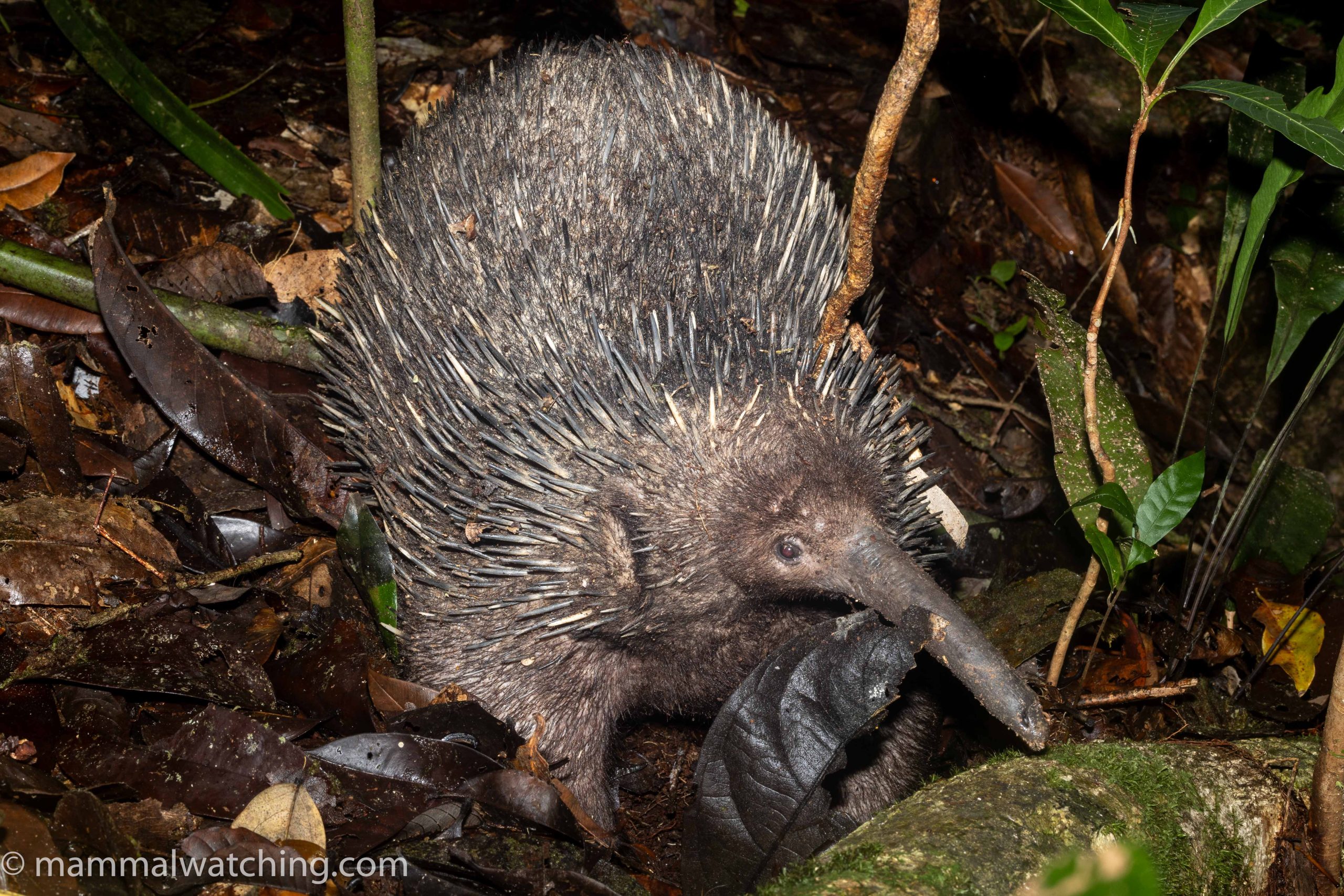
West Papua, 2023
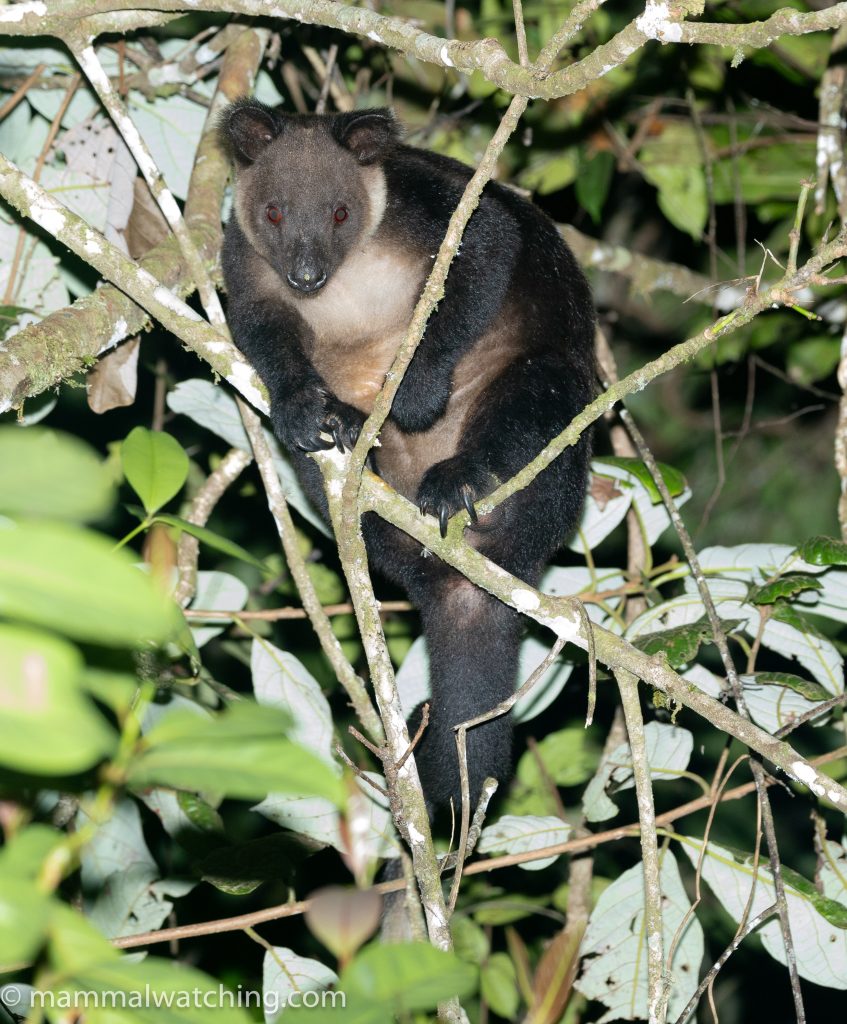
Vogelkop Tree Kangaroo (Dendrolagus ursinus), Gunung Mupi.
What makes for a great trip? The quality and quantity of the mammals? The adventure? The chance to explore somewhere so new you feel like you might be on a scientific expedition with Charles Darwin at your side? Maybe it’s the people: the rest of the group, your guide and the locals who help you on the way? Or perhaps the best trips are when expectations, no matter how high, are greatly exceeded?
This trip won on every front.
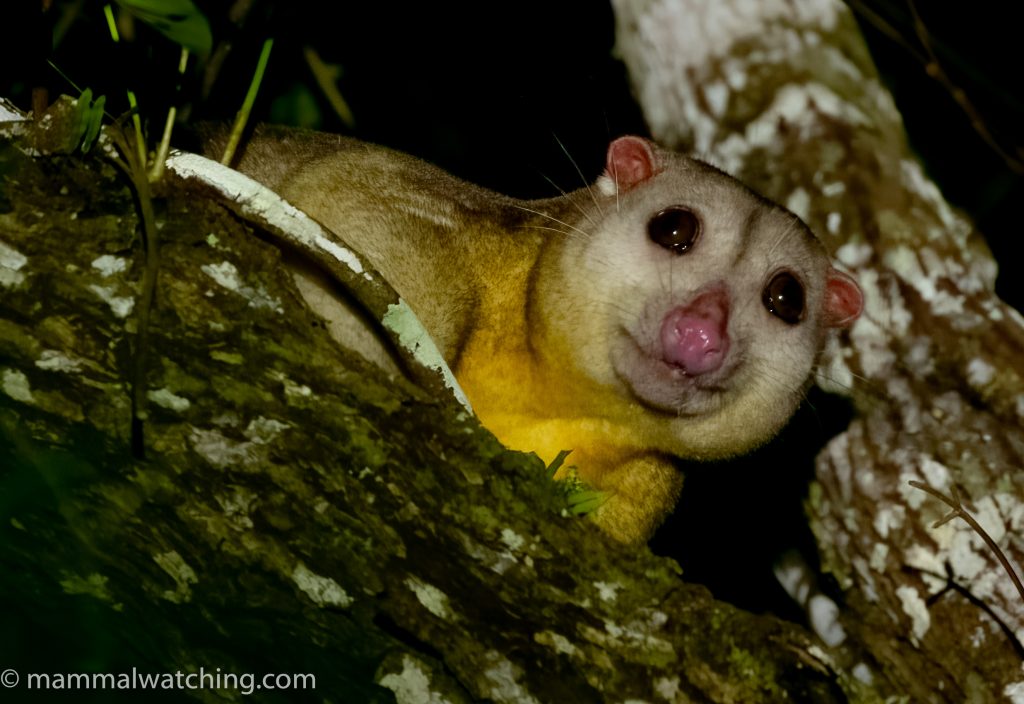
Female Northern Common Cuscus (Phalanger orientalis), Gunung Mupi
But before you start packing your bags, read on. West Papua – at least the bits we saw – is a definite contender for the worst food, sweatiest accommodation and toughest trails this side of …. just about everywhere. Looking back at these hardships they probably made the trip all the more worthwhile. But a month ago I would have put my kids’ internal organs on Ebay for a pizza and a shower.
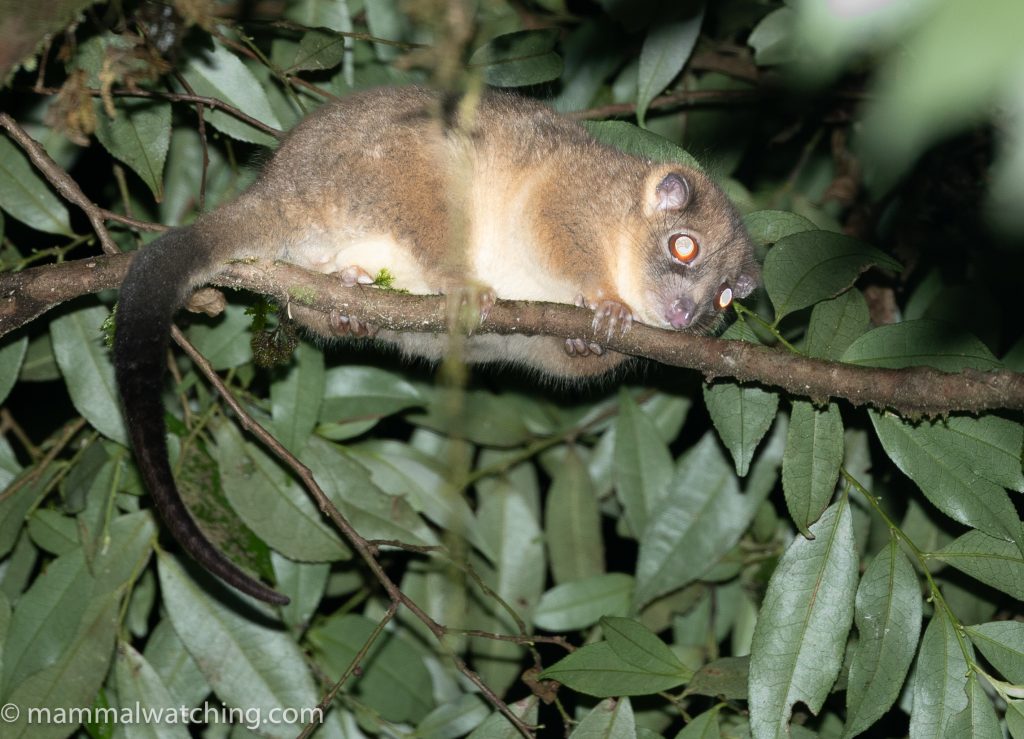
Arfak Ringtail (Pseudochirulus schlegelii), Gunung Mupi
For most of my life I’d thought of Papua as a mammalwatching lost cause. I know plenty of birders who had visited. Many of them had been often. And their advice was a consistent “you won’t see any mammals”. Even after reading Tim Flannery’s ‘Throwim Way Leg’ – my favourite mammalwatching book – I was not tempted. His is a story of an island rich in adventure and superb mammals that are incredibly difficult to see.
And then Carlos Bocos started writing to me in 2019. One of Indonesia’s top birding guides he was beginning to realise that mammalwatching might be his true love. He needed someone to talk to and I was happy to help.
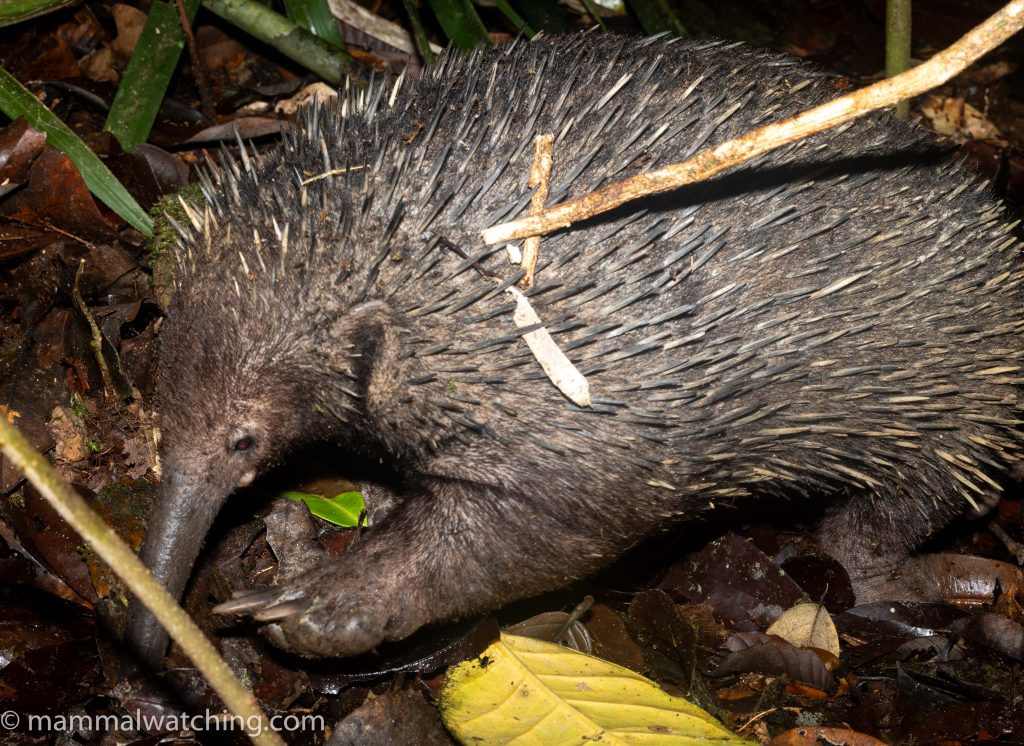
Western Long-beaked Echidna (Zaglossus bruijnii) near Sorong
Carlos is bloody good at finding, photographing and IDing mammals. In those giddy early days of our friendship not a week would go by without him sending me a picture of a bat or a rat I’d never even heard of. And so we started talking about a trip to West Papua: somewhere Carlos had lived for several years and where he was convinced we could find mammals if we went to the right spots and didn’t have to spend our days birding. “I’ll get you 50 lifers Jon” he whispered. Who could resist?
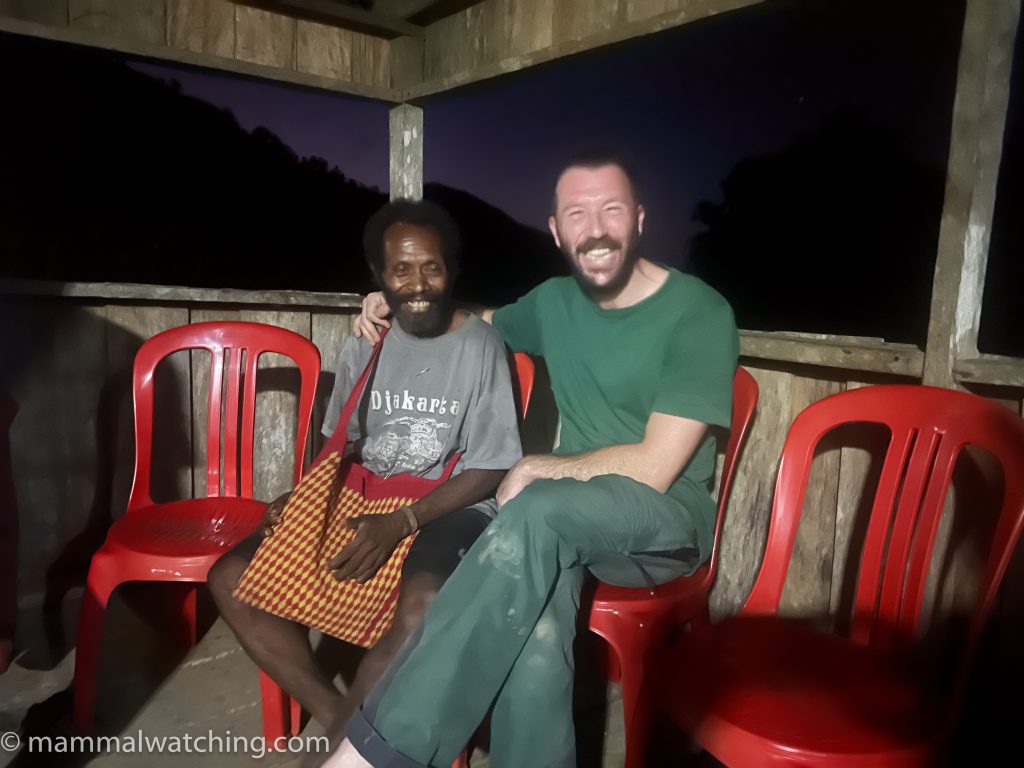
Carlos and his friend Matheus (one of our chief mammal finders on the mountain), Gunung Mupi
But then COVID. Our plans for a trip in 2020 were postponed to 2021, then 2022. Indonesia was still shut and so when Mark Spence – a Brit who lives in Jakarta – posted about his successful search for a Western Long-beaked Echidna in West Papua I was devastated. This should have been us! A few months later the country was openinng and I was messaging Carlos weekly to set the date. The rest is history.
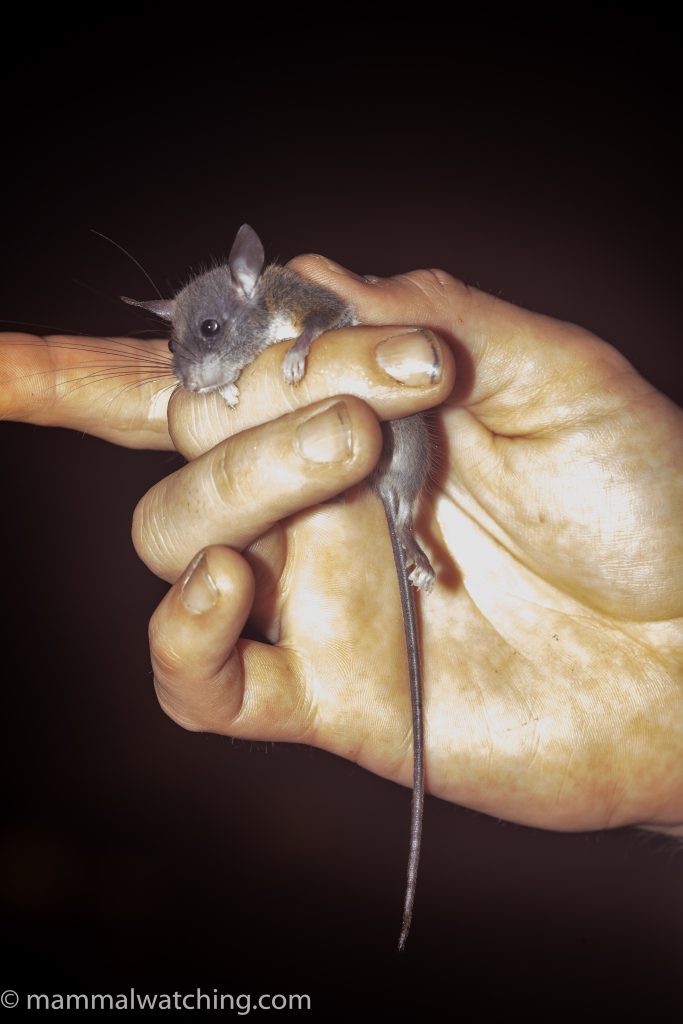
Long-footed Tree Mouse (Lorentzimys nouhuysii), Malagufuk
In early June 2023, Charles Foley and I were starting a very long journey to Manokwari in West Papua from New York, via Hong Kong, Jakarta, and Sulawesi. We met up with Carlos, Venkat Sankar and Nils Bouillard en route and were joined by the last of our team – Ian Thompson – soon after we arrived at our hotel in Manokwari some 50 hours after we left New York. The air thick with anticipation and jet lag.
Our itinerary
As you can see from the map we explored just a fraction of the Vogelkop (or Bird’s Head) Peninsula. But the peninsula is a tiny bit of just West Papua let alone the whole island of New Guinea.
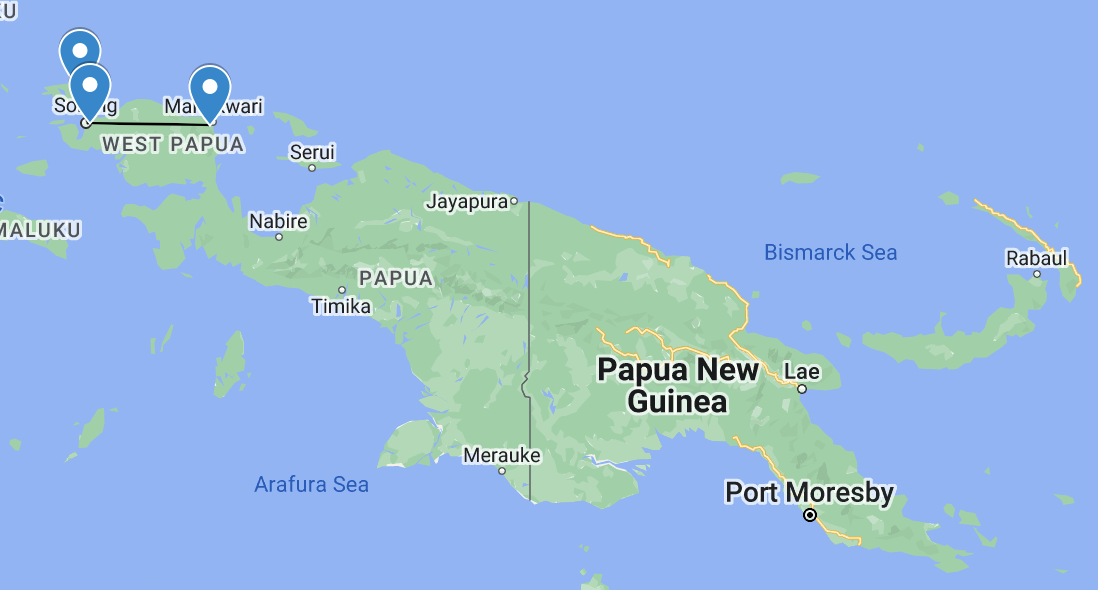
Carlos has outstanding knowledge of West Papua: both the sites to visit and the people you need to work with to visit them. Perhaps the latter is more important the former. The local politics are complex to say the least and it would be very easy to get into problems there without someone like Carlos to navigate the Papuan waters.
We decided to visit three areas. We’d spend a week on Gunung Mupi near Manokwari where our key target would be the Vogelkop – or Ursine – Tree Kangaroo along with a bunch of other top-tier mammals. We’d spend a week around Malagufuk, a village popular with birders, close to the city of Sorong where our key target would be Western Long-beaked Echidna and, possibly, Grizzled Tree Kangaroo.
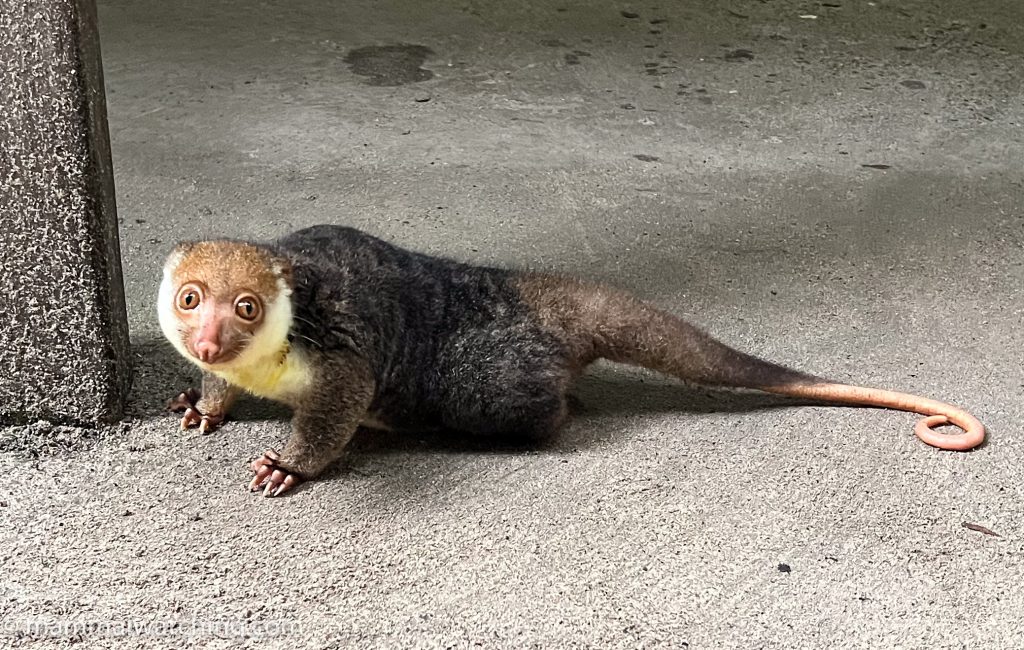
A young Waigeo Cuscus (Spilocuscus papuensis) that had fallen from a tree. and taken up residence in a cardboard box at a dive resort.
And we’d finish with a couple of days on Waigeo Island where our key targets would be cold beer, decent food, a comfortable lodge, accompanied by a few final species including Waigeo Spotted Cuscus. Waigeo was definitely a place to finish the trip, not visit in the middle.
In the end our trip ran like this.
Day 1: arrive Manokwari and visit a bat cave in the afternoon
Days 2 – 6: Gunung Mupi in the Arfak Mountains
Day 7: return to Manokwari and rest
Day 8: in Manokwari with a half day trip and night walk from the Papuan Lorikeet Guesthouse, south of Manokwari
Day 9: short flight to Sorong and overnight at a village close to Malagufuk to try for Long-beaked Echidna
Day 10 – 14: Malagufuk eco village
Day 15: return to Sorong and take the afternoon ferry to Waigeo Island
Day 16: Waigeo Island
Day 17: return to Sorong for onward connections
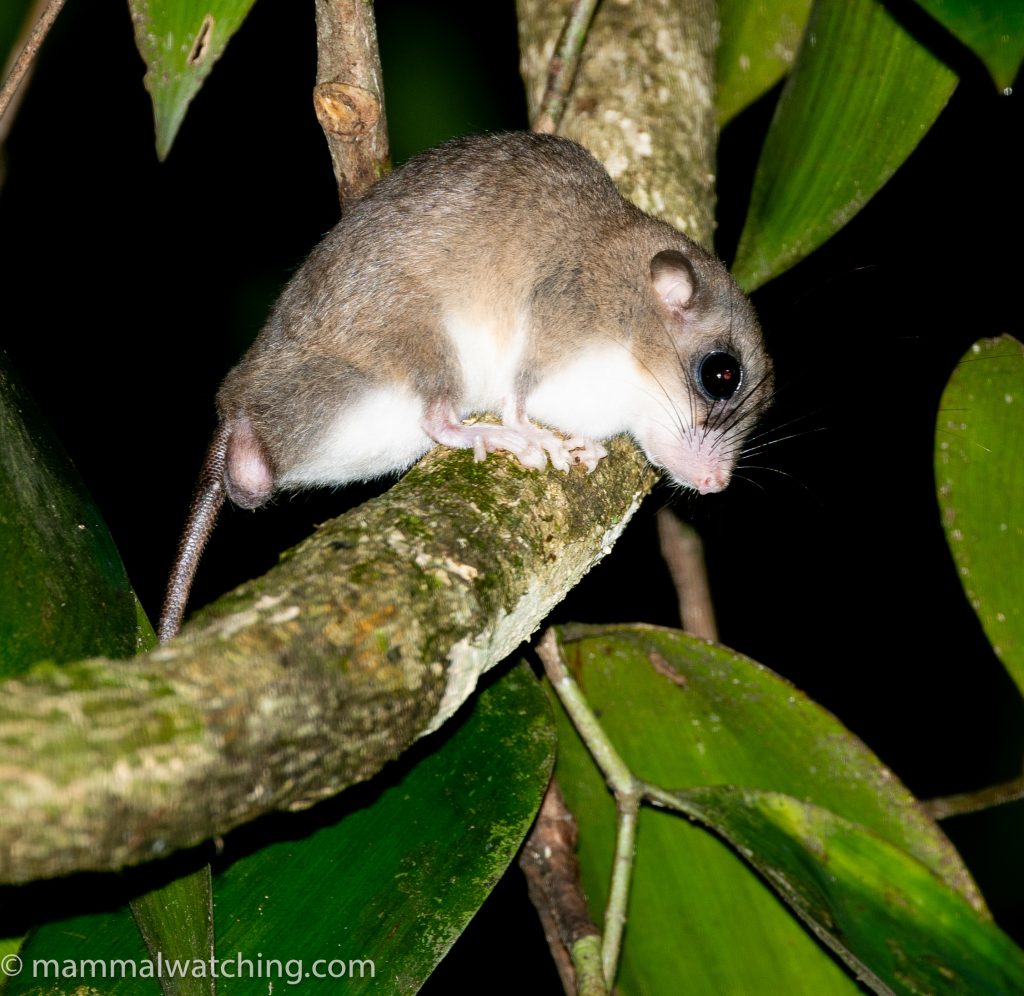
Bruijn’s Pogonomelomys (Pogonomelomys bruijnii) at the Long-beaked Echidna site.
Food, Accommodation, Weather
The dry season in Papua lasts from May through October/November. Mammalwatching would be pretty much impossible in the wet. We were lucky with the weather: though we had our fair share of torrential rain (which is normal even in the dry season), the year’s El Nino meant we had a less than usual. Carlos talked about previous ‘dry season’ trips up Gunung Mupi where it had rained continuously for three days and nights. The humidity in the lowlands was hideous. We’d be dripping in sweat sitting still in the shade. So, no matter how many clean clothes you can fit in your bag, trying to maintain any level of personal hygiene above ‘feral’ was a lost cause.
There were surprisingly few biting insects which was a relief as malaria and dengue can be common. Rubber boots were useful for the very muddy trails but not so great for support when you are slipping and sliding up and down the mountain at Mupi. I packed a tent I didn’t use: we were given space in huts to sleep everwhere. And I bought a cheap sleeping bag in Manokwari that I didn’t really need either. A cotton sleeping sack was adequate: it was mainly useful to keep bugs away and provide a layer between me and the putrid mattresses that we slept on.
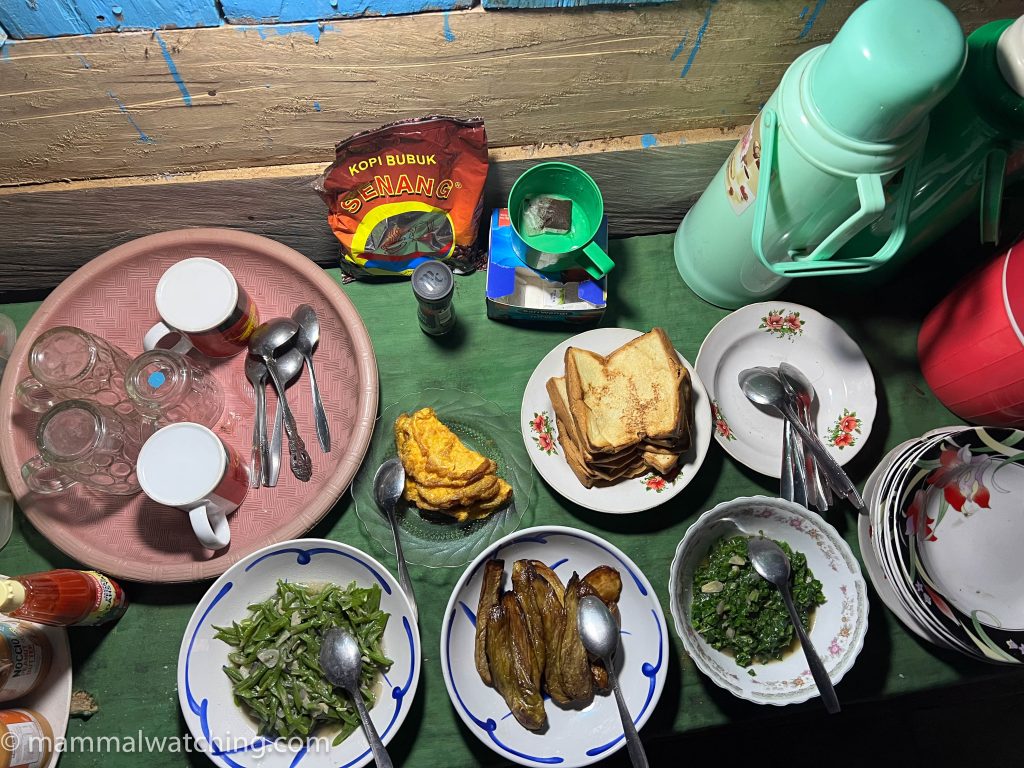
Breakfast. Possibly. Or possibly lunch or dinner. Everywhere.
If you are going to West Papua for the food then think again. At Mupi and Malagufuk we had rice and noodles three times a day, accompanied usually by a bitter green spinach-like vegetable, or vast quantities of oily aubergine. These were occasionally supplemented by meat that was somewhere between vulcanised rubber and chicken. Sardines kept making an unwelcome appearance even though Charles, Carlos, Venkat and I were not shy in letting people know that we’d rather chew our own arms off then approach within a few feet of them. In hindsight it would have been better to have supervised the food shopping.
In Malagufuk at least there was an opportunity to have extra supplies brought in from Sorong during the week. These supplies were mainly pot noodle, beer and cookies: my staple diet for the last few days. Waigeo Island, by comparison, was paradise: a comfortable resort on the ocean, good food and hot showers.
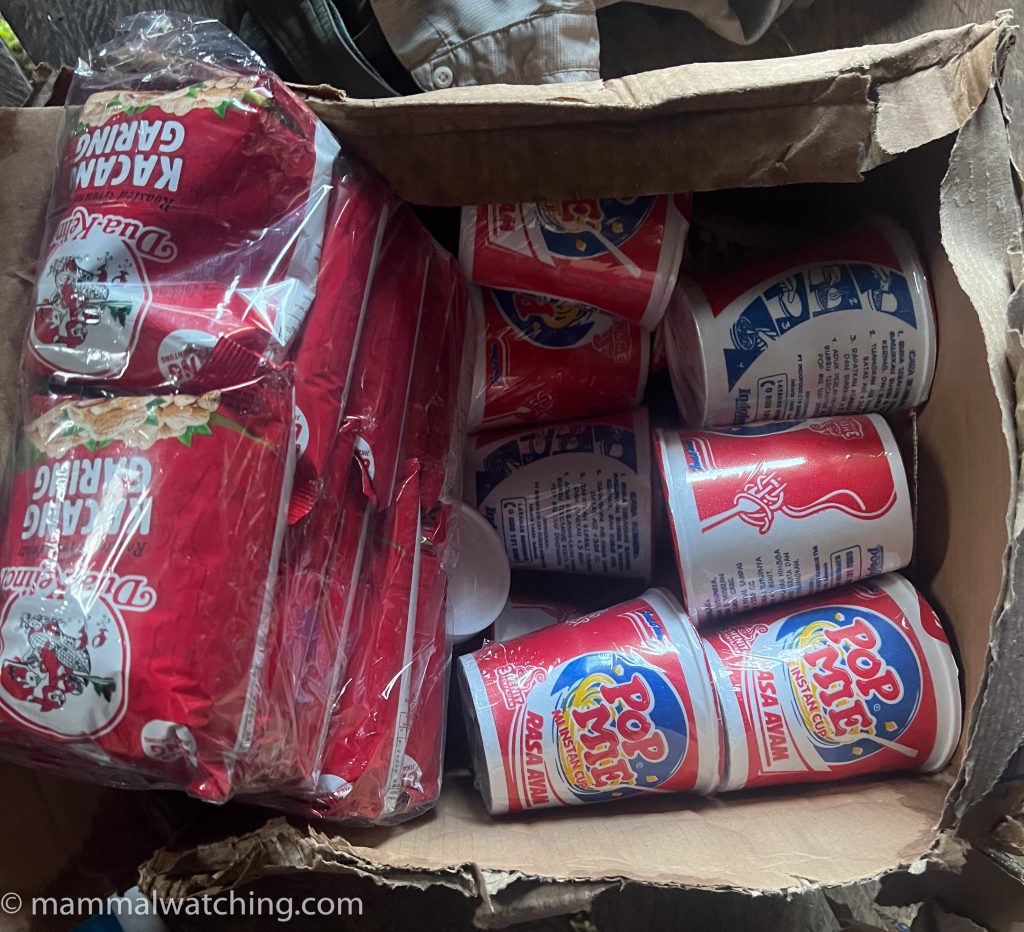
Emergency rations in Malagufuk
There was cell phone reception at Mupi when the sky was clear. It was pretty reliable in Malagufuk and excellent everywhere else.
We brought one copy of Tim Flannery’s guide to the mammals of New Guinea with us. It is over thirty years old, but an invaluable starting point and I am not aware of anything better. As you will read we saw several species that appeared to be well out of their range and habitat or perhaps undescribed. West Papua is fun like that.
Organising A Trip
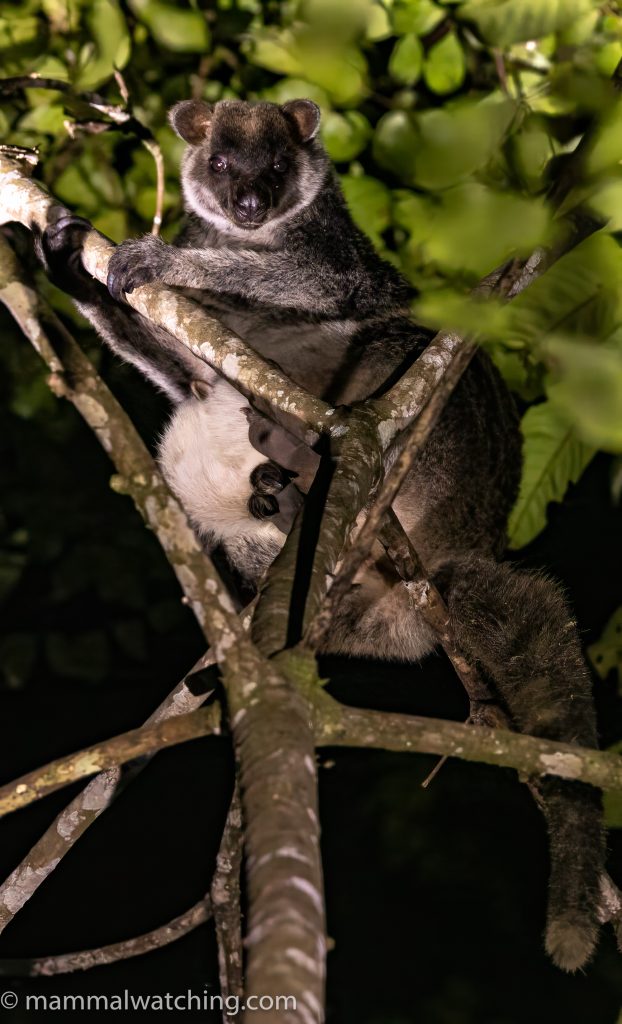
Grizzled Tree Kangaroo (Dendrolagus inustus). Gunung Mupi.
We all learned a great deal on this trip about mammalwatching: about the best ways to find and photograph mammals and to work as a team. But perhaps the biggest lesson – other than that I love pot noodle – is the importance of having a guide with the people skills that Carlos has. He has a genuine gift in being able to get along with everyone, especially the many locals we needed to help us access the remote areas and find the mammals. It might be tempting to underestimate how important this is, especially if you are used to doing everything on your own. But that would be pretty much impossible in West Papua. Carlos’s personality, his genuine respect for the Papuans, and his ability to speak with them in the local language meant we could access their community lands and were welcomed enthusiastically. The people who met seemed as excited as we were at the prospect of going out to look for mammals. There was a definite buzz in the air that was louder even than the flies licking the sweat from our socks. Carlos explained the villagers were particularly excited because they had never met mammalwatchers before, not from such a distant tribe at least, and that it was mammals – not birds – that were really their thing. This might be more for culinary reasons than photography but whatever ….
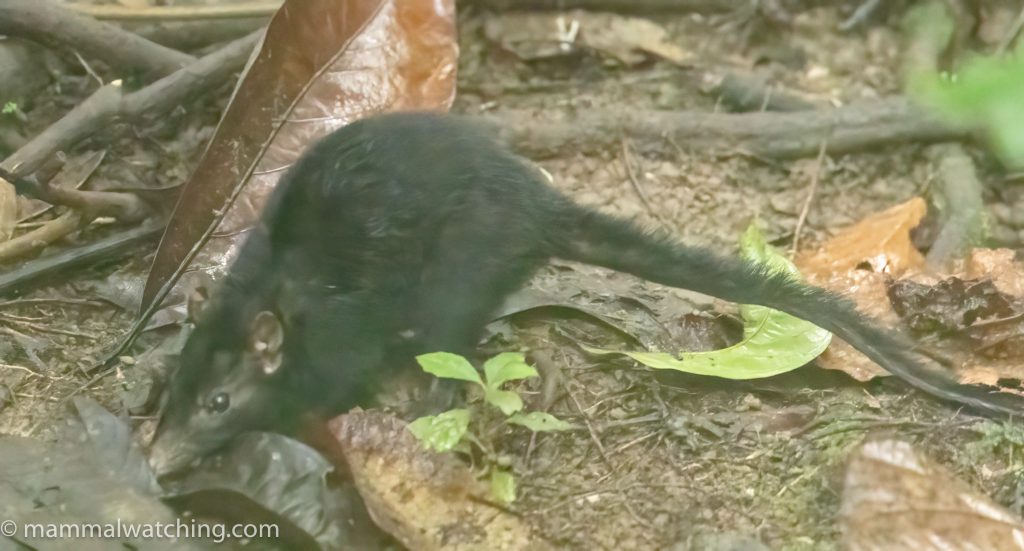
Müller’s Three-striped Dasyure (Myoictis melas), Malagufuk
So Carlos is the perfect guide for Papua. But Carlos is in big demand as a bird guide so it’s unlikely he will be able to lead many trips to West Papua in the near future. He and I are still talking about how best to help others to visit. We would like to help set things up with the local people so that mammalwatchers can follow in our footsteps. This will take a bit of time and some of the information is a bit sensitive.
It is important that you talk with the right people to visit each area, and that will also mean you might need someone to help contact them. Some of the guys we met are apparently not easy to get hold of even if you can speak Bahasa. So for now it is probably best if you write to me and I will try to point you in the right direction. On this trip Carlos worked with Hans Mandacan (on Facebook here) for the Manokwari and Mupi parts of the trip and Absalom Kalami (on Facebook here) for the Sorong leg. Great people but I have no idea how easy it would be for a rookie to set something up with Absalom in particular.
It is also important to stress that West Papua is not an easy place to navigate and lots can go wrong and much can chage. I am told that some international bird tour companies will not recommend any local guides for liability reasons. And so we are not ‘recommending’ these guys either. But I can report they did a good job for us. So travel at your own risk knowing that things can and do go wrong for some groups. That said, it might be safer than an Ocean Gate trip.
Manokwari Area
Manokwari City
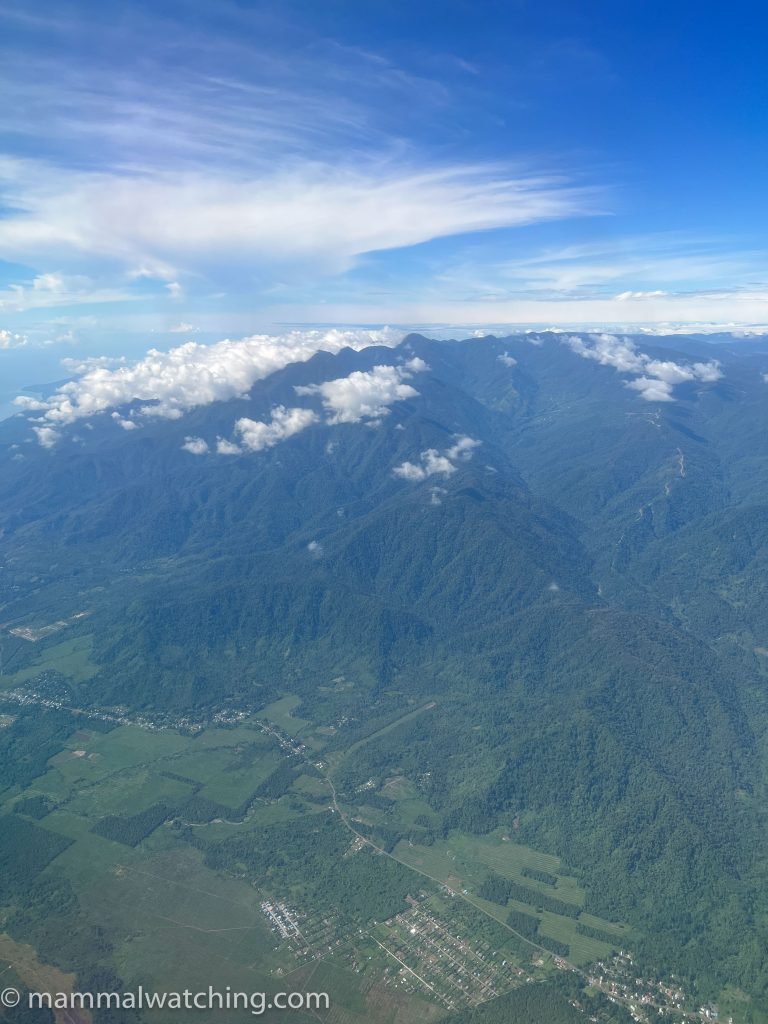
Coming in to land at Manokwari
We spent our first night at Manokwari’s comfortable Aston Nui Hotel. A bustling city that is alcohol free unless you know the right doors to knock on. A few hours after we landed we visited the Goa Jepang Bat Cave about 30 minutes from our hotel.
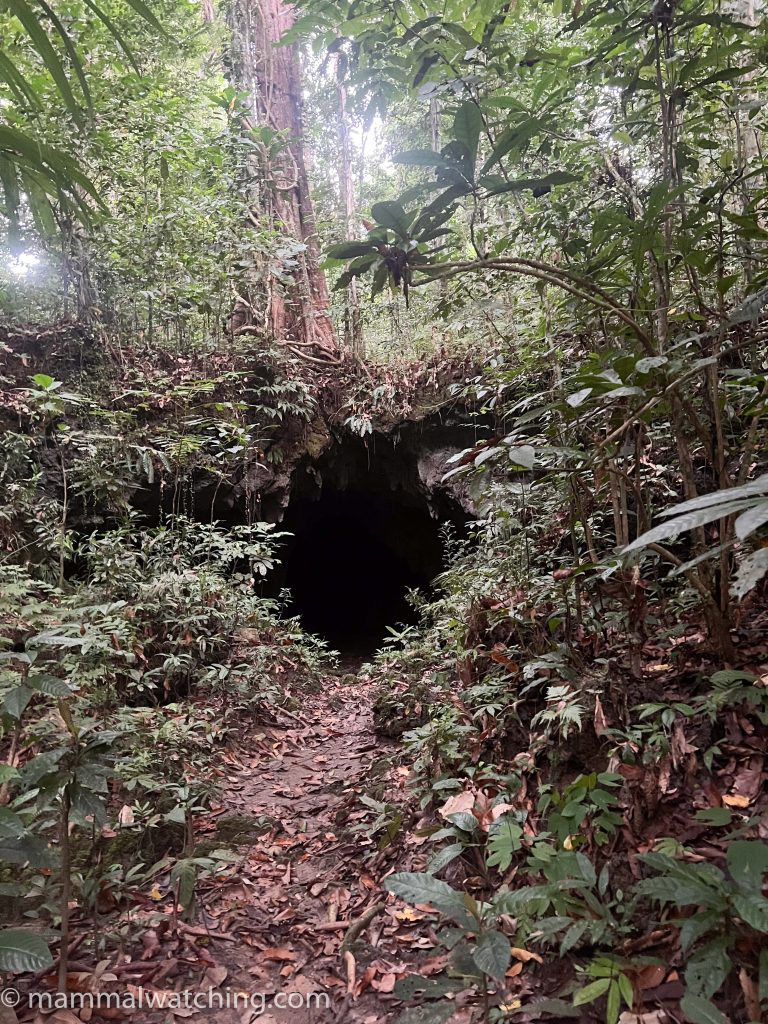
Bat cave near Manokwari
Access was easy and there were some Lesser Bare-backed Fruit Bats (Dobsonia minor) inside.
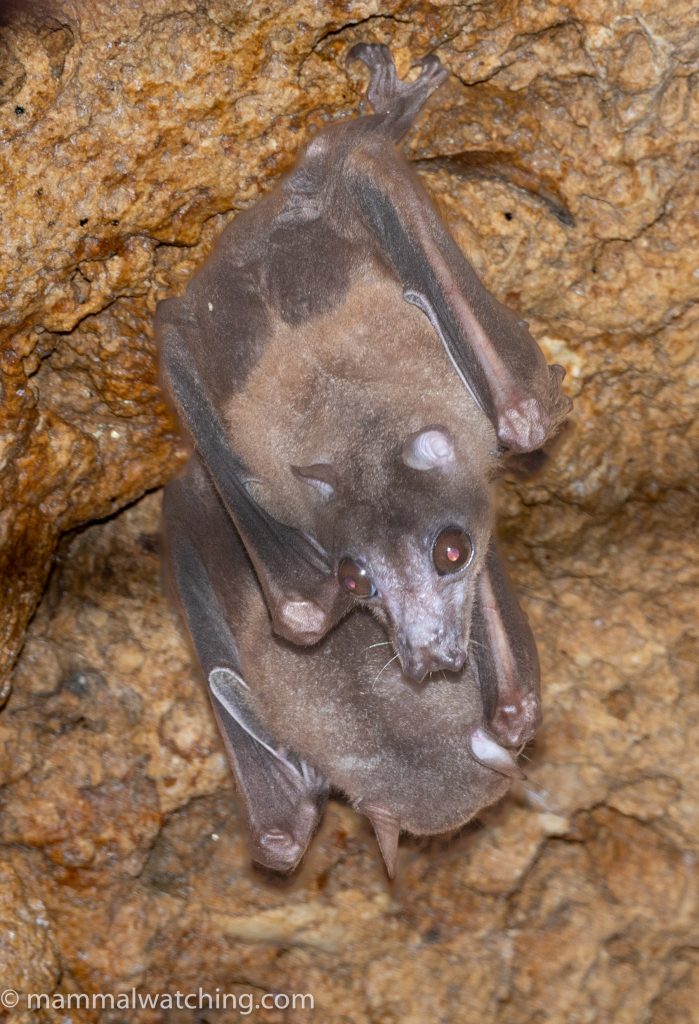
Lesser Bare-backed Fruit Bats (Dobsonia minor)
Along with a few Raffray’s Sheath-tailed Bats (Emballonura raffrayana).
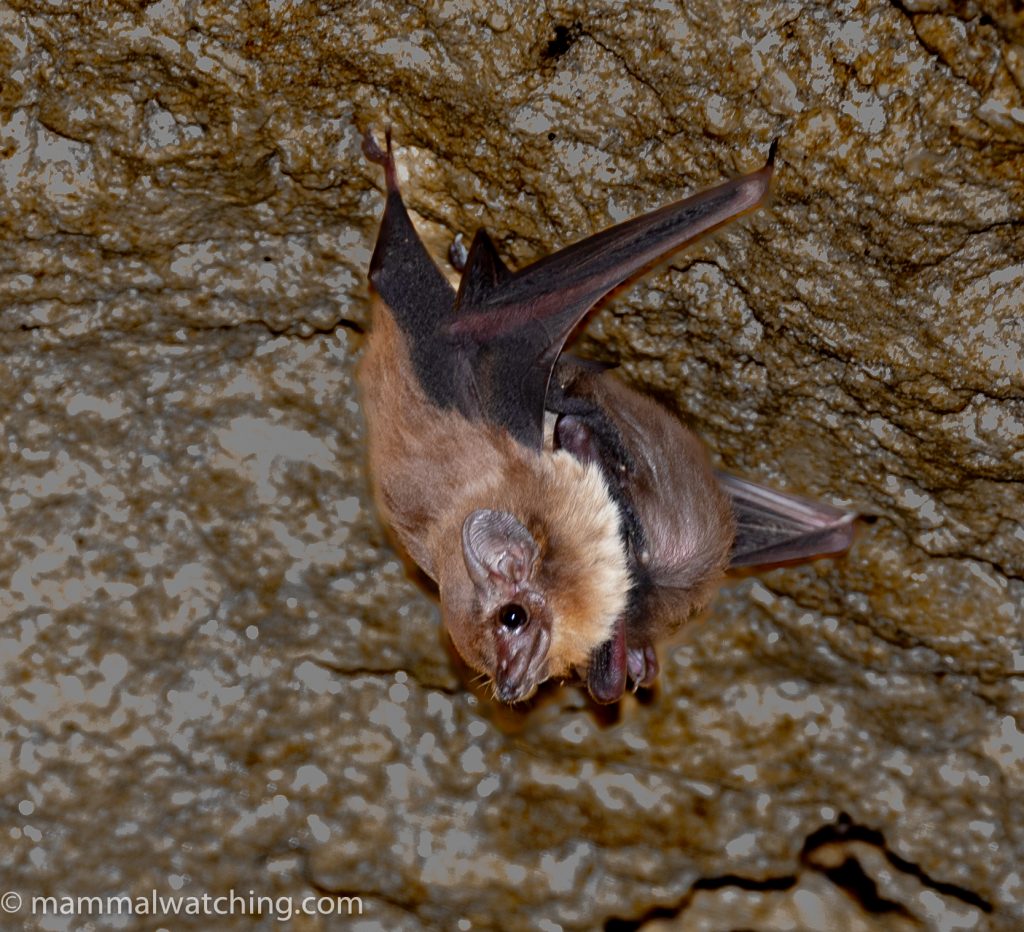
Raffray’s Sheath-tailed Bats (Emballonura raffrayana)
Gunung Mupi
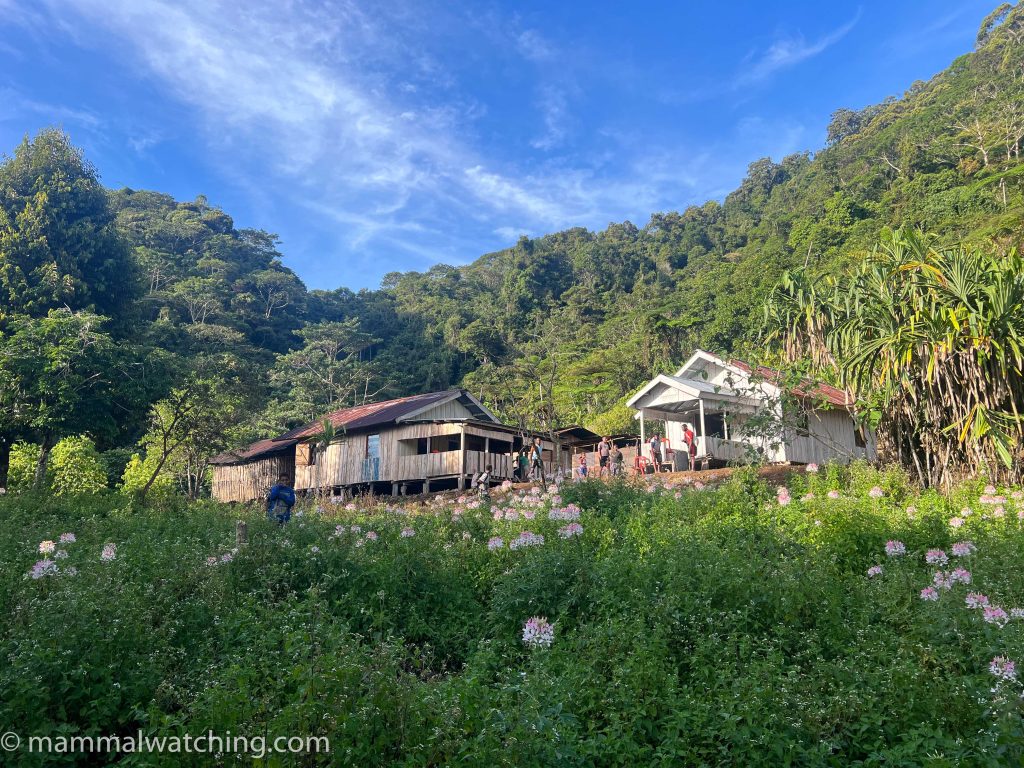
Mupi mountain is close to Manokwari. It is a fairly well known birding site though seldom visited: access is a challenge and there are easier ways to see the local birds. But its remoteness means it is a far better place to see mammals than the Arfak birding lodges. You would have to be seriously committed to wanting a kangaroo dinner to hike the 8 hours up the mountain to find one.
The land is owned by the local community. People used to live up there but the camp is empty most of the time, though a couple of wooden huts and a church(!) are ready for visitors to use. To visit you need to deal with Hans Mandacan: he speaks some English and was well-organised for our visit. Hans and his team, with two impressively rugged pick up trucks, met us at 4am at our Manokwari hotel and drove us for an hour to the trail head. We were met by a crowd of porters, kids and dogs who started distributing our luggage and supplies between them as we set off in the dark for the long climb up the mountain.
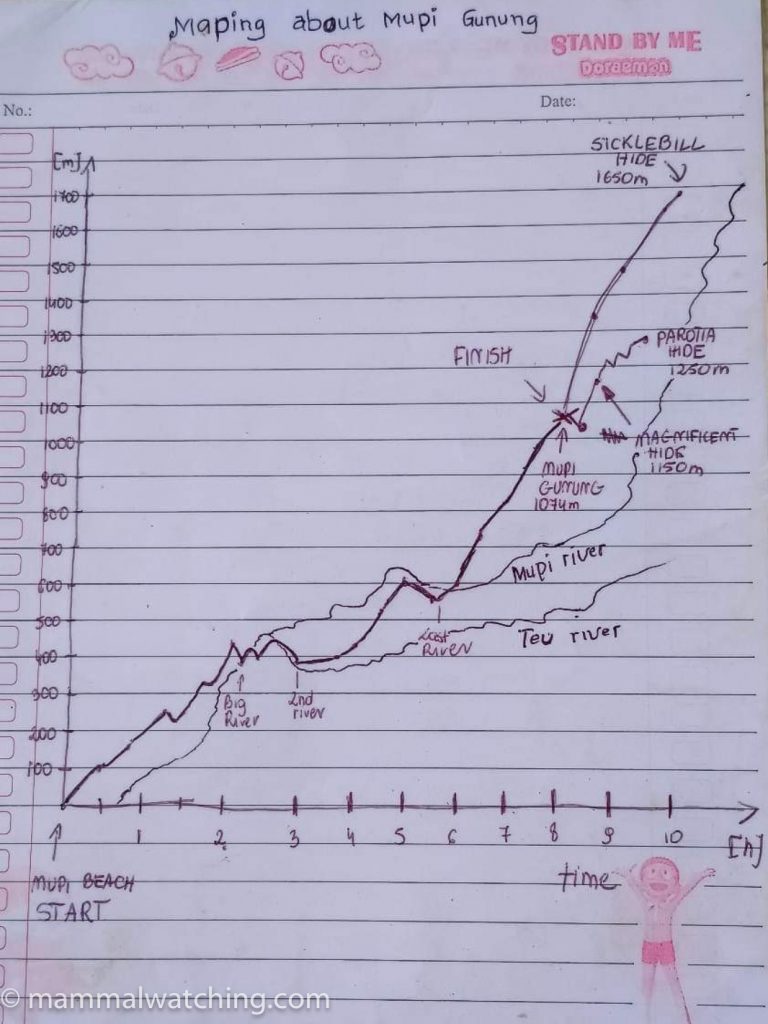
I didn’t know what to expect beyond this trail ‘map’ and a 2017 trip report that described the 7 hour hike as “remarkably strenuous”, warninged that you must be “reasonably fit”. It was indeed strenuous: it took us almost 9 hours and the final 4 hours were a very tough slog up some of the steepest and slipperiest trails I have ever encountered. Here is Charles Foley’s account.
“The first two hours were a steep and arduous sweat-filled climb through thick forest, after which the path fortunately flattened out a bit for the next two hours as we criss-crossed a largish river using fallen tree trunks. At the final river crossing we stopped for a quick dip in the water to cool down. ‘Where do we go from here?’ I asked Hans, one of the village headmen and our principal guide. He pointed to the steepest part of the mountain and said gleefully ‘Now we go up, up, up.’ He wasn’t kidding. At some points the path was so steep that the villagers had strapped together makeshift railings out of bamboo that we could hold onto and use to hoist ourselves up. We staggered up, sweating profusely and taking increasingly frequent stops to catch our breath. We even had a few leeches crawling up our legs to add to the general merriment. This went on for four hours.”
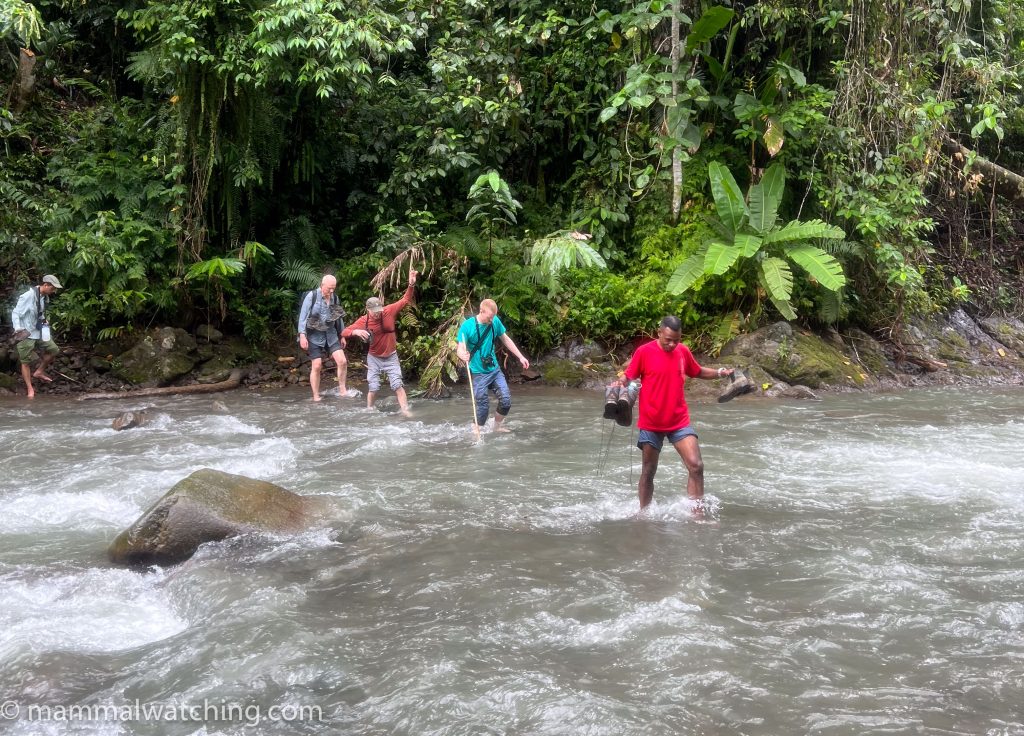
And we were lucky: the weather was cool and overcast and the trail relatively dry.
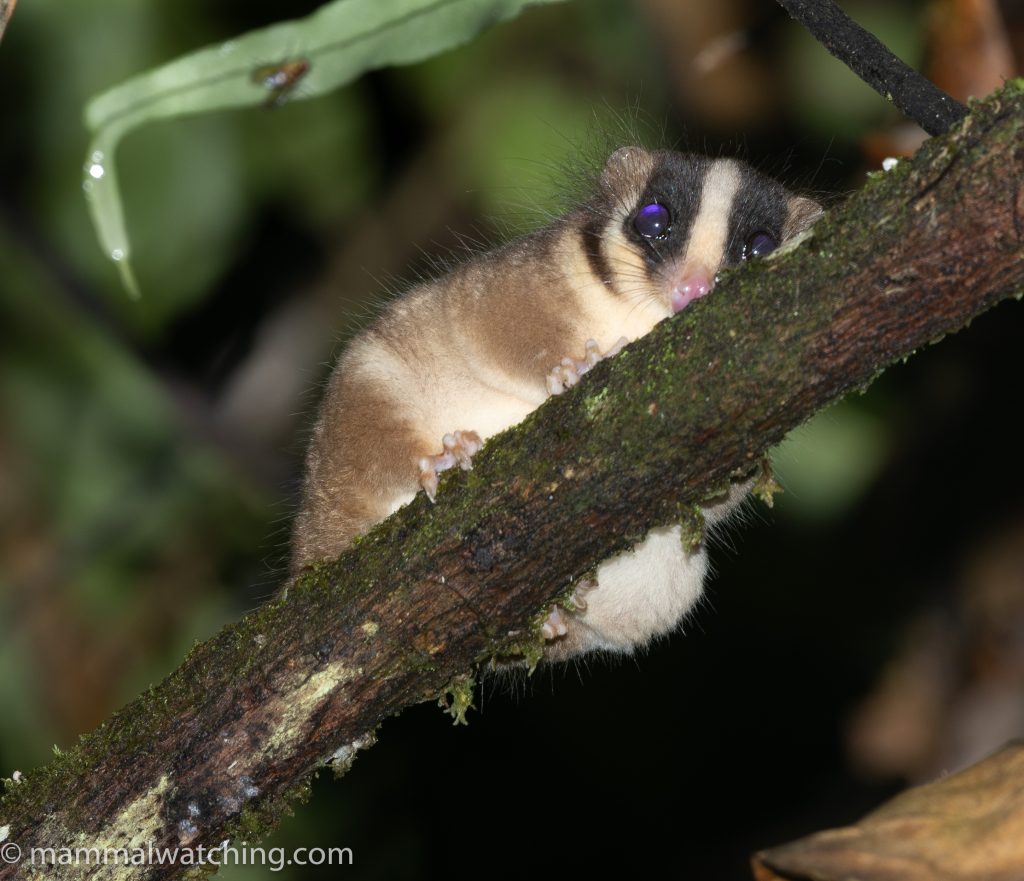
Feather-tailed Possum (Distoechurus pennatus)
We’d been expecting to camp so it was a pleasant surprise to discover we had space to sleep in two wooden shacks, with an ensuite squat toilet and shower. There was even a generator so we could charge our batteries in the afternoons plus occasional cell phone reception when the skies were clear. A very large – more than 30 – and enthusiastic team of locals were up there with us: men, women, children and dogs. We spent the next five nights walking the various often steep and always slippery trails in search of mammals. We passed the days doing very little other than a couple of excursions to see tree kangaroos the villagers had found for us in the forest or take an occasional stroll to a small hide to catch a fleeting glimpse of some of the birds of paradise species that would come to feed on the pandanus fruit, locally known as “ Buah merah” that had been laid out.
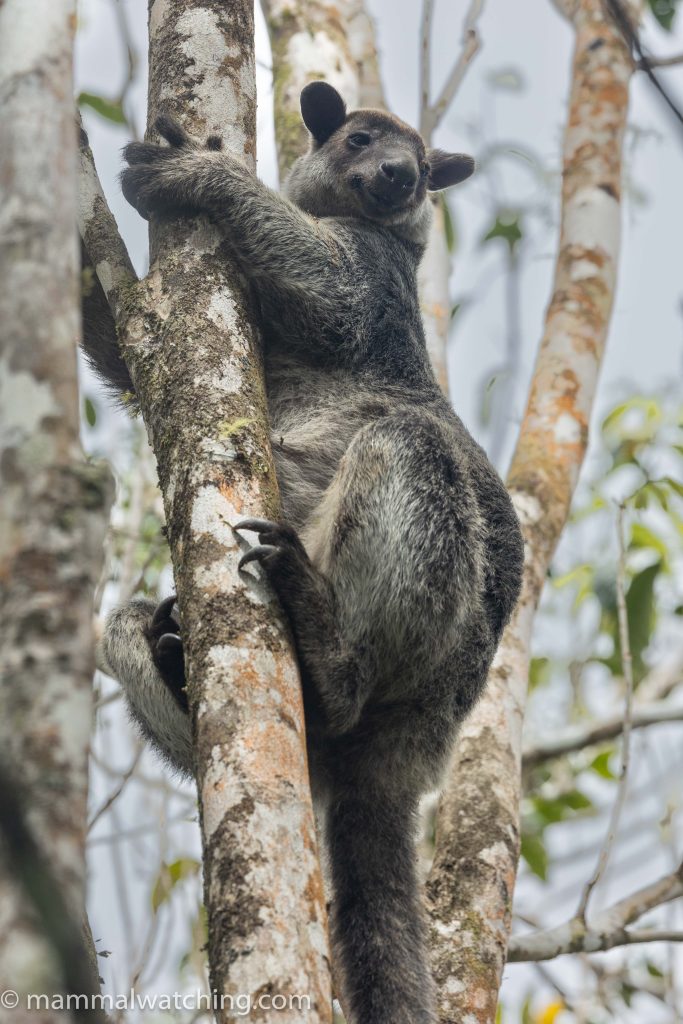
Grizzled Tree Kangaroo (Dendrolagus inustus)
We had plenty of food. Pretty much the same meal three times a day: rice, noodles, a bitter green vegetable and occasional side dishes that could be hard to identify.
The mammalwatching was superb. We soon settled into a rhythm for our night walks, walking the trails slowly, each of us stopping every few steps to scan with our thermal scopes. The local team fanned out on either side to search with their flashlights.
We were seeing animals every 10 minutes. The vast majority were seen well: the arboreal species would usually freeze and allow photographs, which we discovered was vital for identification, even for some of the larger species some of us were familiar with. We planned to spend six nights on Mupi but left on our 6th day so we could spend a night in a different area to try for Stein’s Cuscus. We’d allowed plenty of time up here in part because we had expected to lose some nights to rain. But as I said we were lucky: there was torrential rain during several afternoons but the nights were dry. Even so we were still recording new species on our last night and so I’d recommend a minimum of five nights up here and perhaps six or seven.
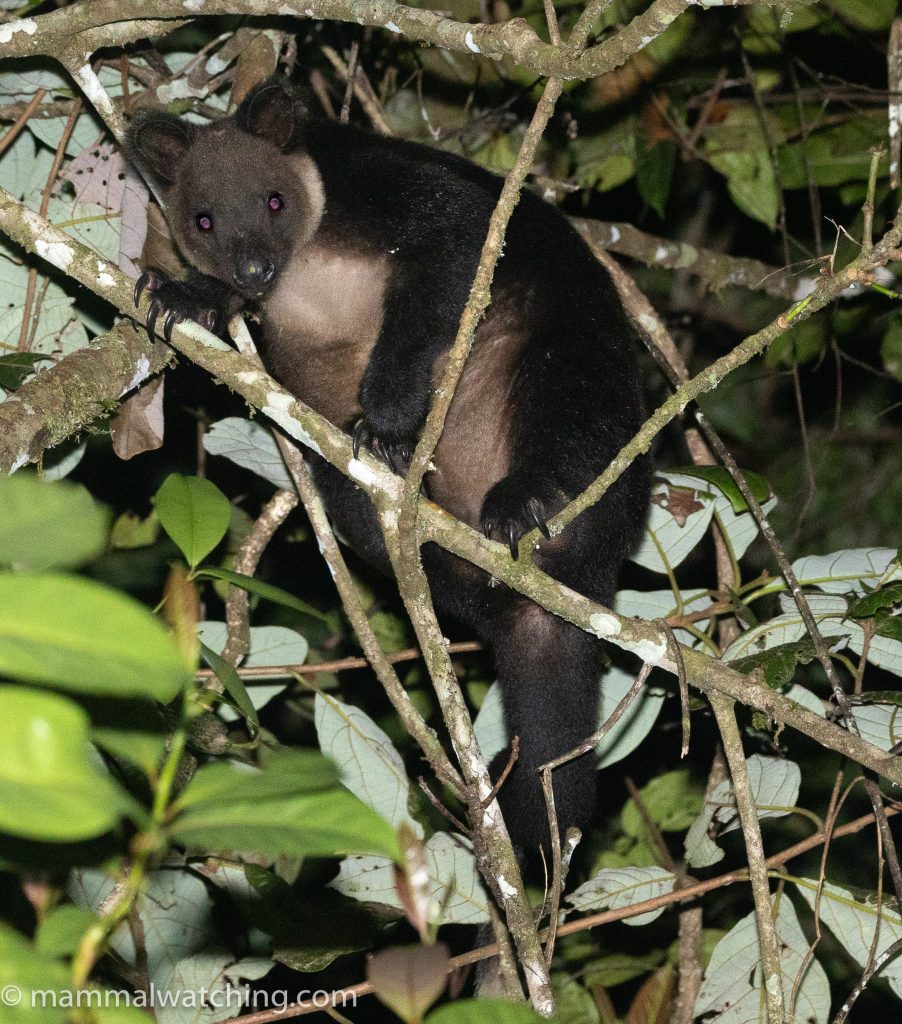
Vogelkop Tree Kangaroo (Dendrolagus ursinus)
The walk down was as tough as the hike up. What it lacked in cardiovascular exertion it made up for in strain on our knees, arms and nerves as we tried to stay upright. I clung for dear life to every spiky tree, shrub and handrail along the way.
The Mammals
All species were found at night unless otherwise noted.
Raffray’s Bandicoot (Peroryctes raffrayana)
We saw two or three of these white bellied bandicoots at night but they were shy and fast and we could not photograph any.
Common Echymipera (Echymipera kalubu)
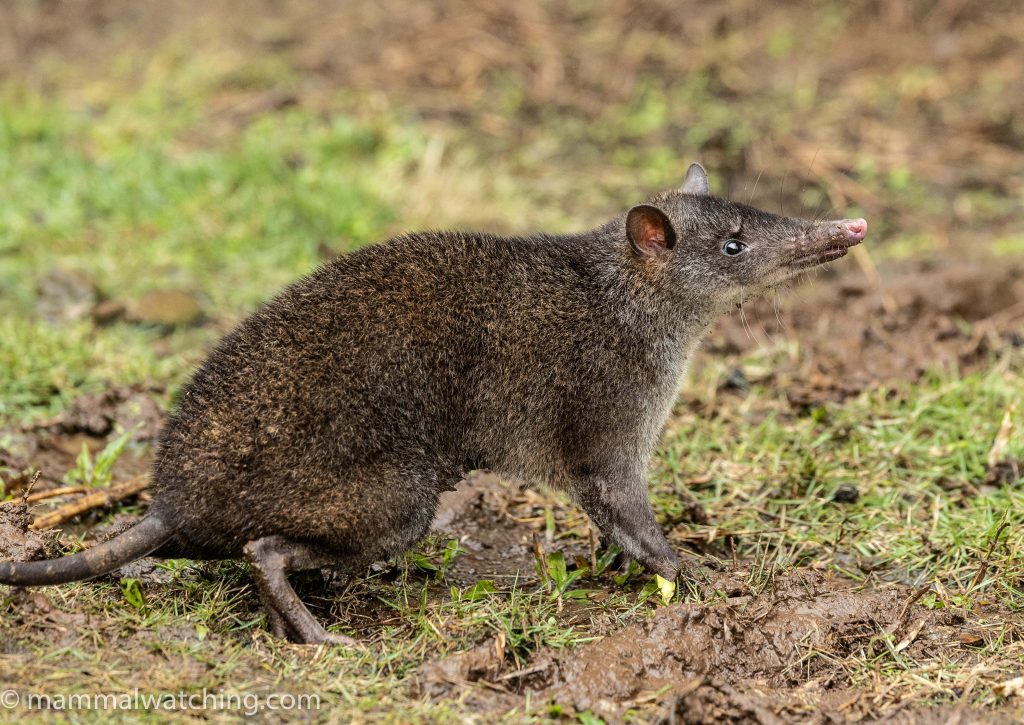
Common Echymipera (Echymipera kalubu)
We saw several at night and the villagers found one in the day time.
Ground Cuscus (Phalanger gymnotis)
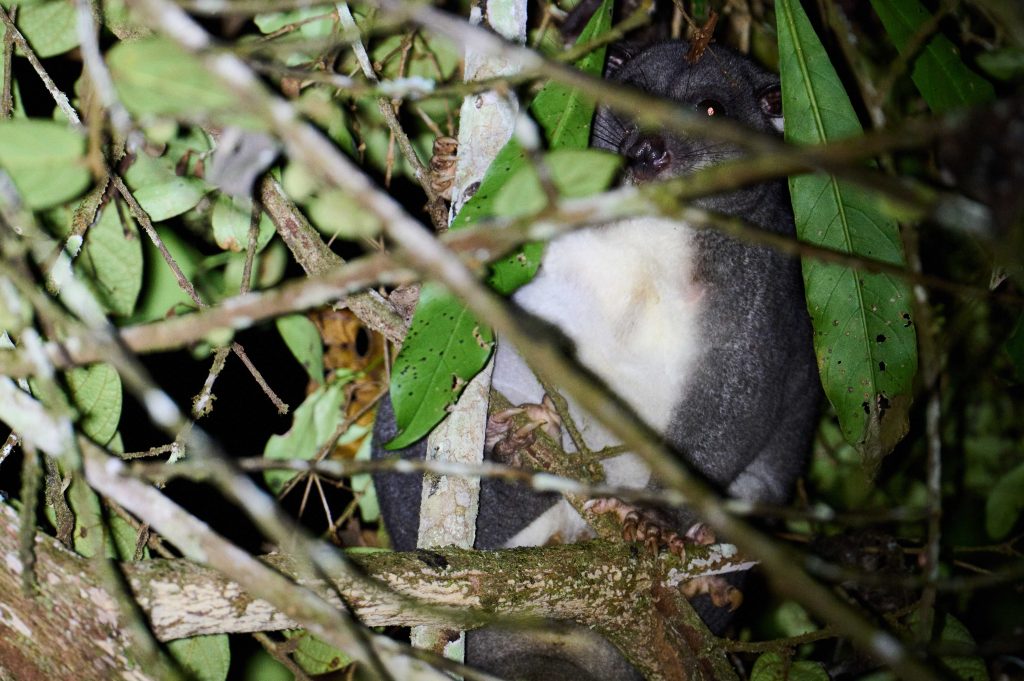
Ground Cuscus (Phalanger gymnotis). Photo Nils Bouillard.
An action-packed encounter with this species which seems quite hard to see. As the name suggests, the species is unique among Cuscuses for being terrestrial. But they do also climb. The community guides spotted this one high in a tree on a our first night. While we were trying to get pictures, and the villagers were scraping the tree trunk, the animal took a leap for freedom and plummeted 10m to the forest floor landing with a thud. We thought it must have been hurt but it dashed off at high speed, running rings around the guys at the base of the tree and disappeared in a few seconds. We wondered whether the ability to fall from great heights like a sack of potatoes is a well-rehearsed escape mechanism.
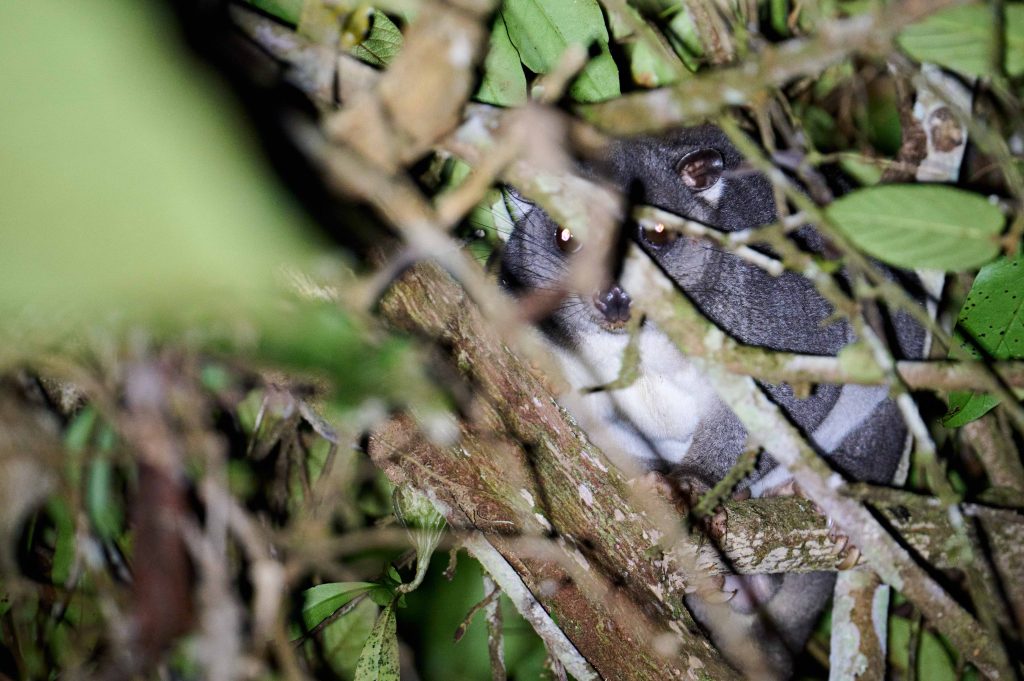
Ground Cuscus (Phalanger gymnotis). Photo Nils Bouillard.
Northern Common Cuscus (Phalanger orientalis)
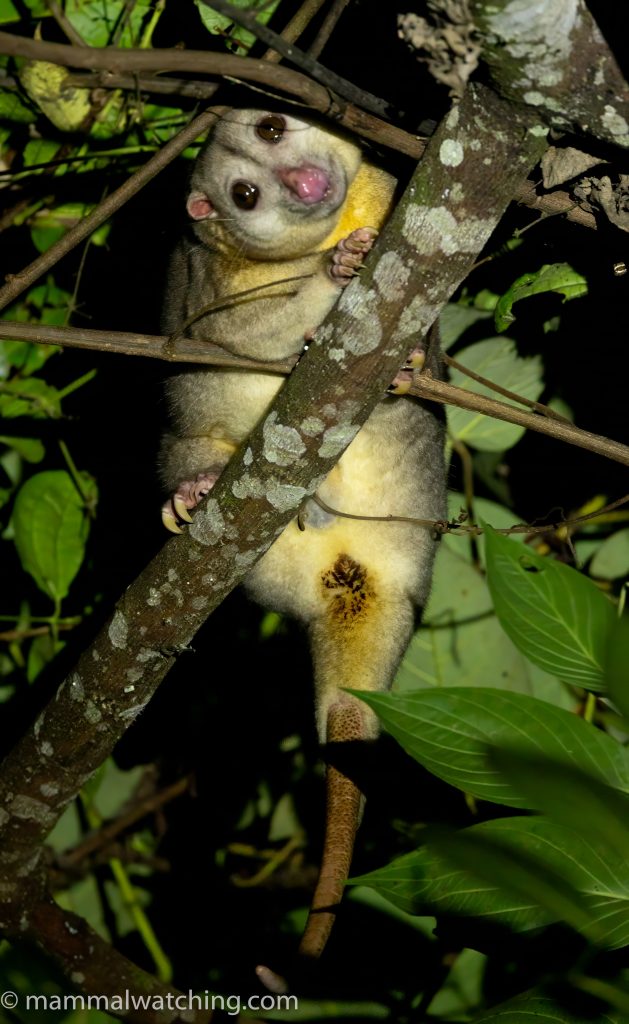
Female Northern Common Cuscus (Phalanger orientalis)
This was the common cuscus at Mupi and we saw several. They are sexually dimorphic. Females are brown and white and males grey. Indeed we thought we had seen two species: Common Spotted Cuscus and Northern Common Cuscus but after examining our photos when we got home we realized all the animals had visible ears and none were the Common Spotted flavor. A reminder of the importance of photos no matter how good the views.
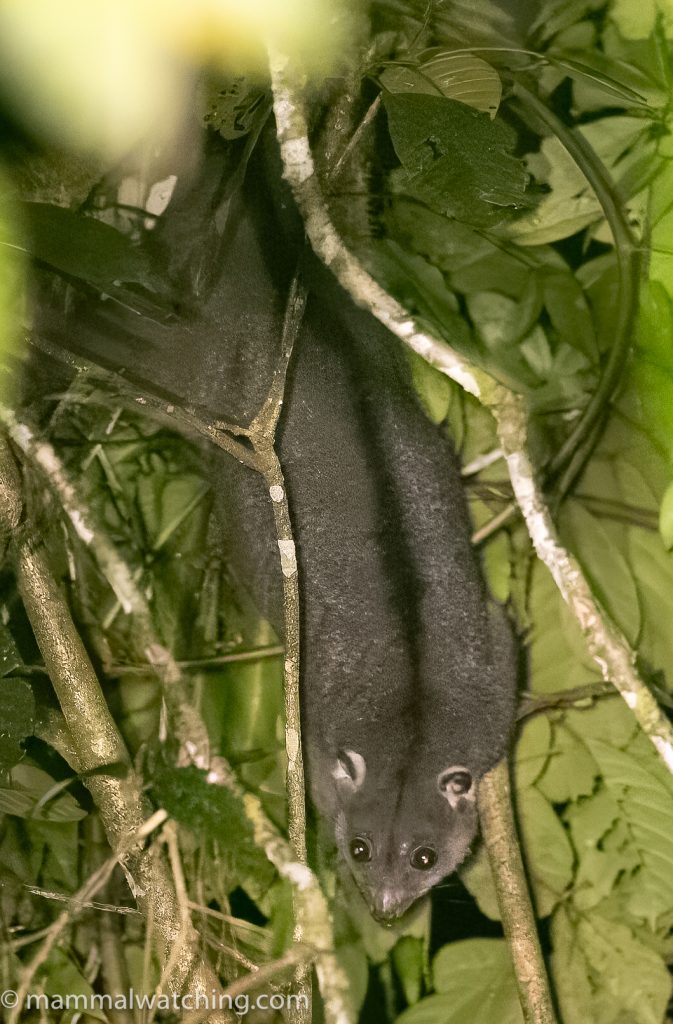
Male Northern Common Cuscus (Phalanger orientalis)
Arfak Ringtail (Pseudochirulus schlegelii)
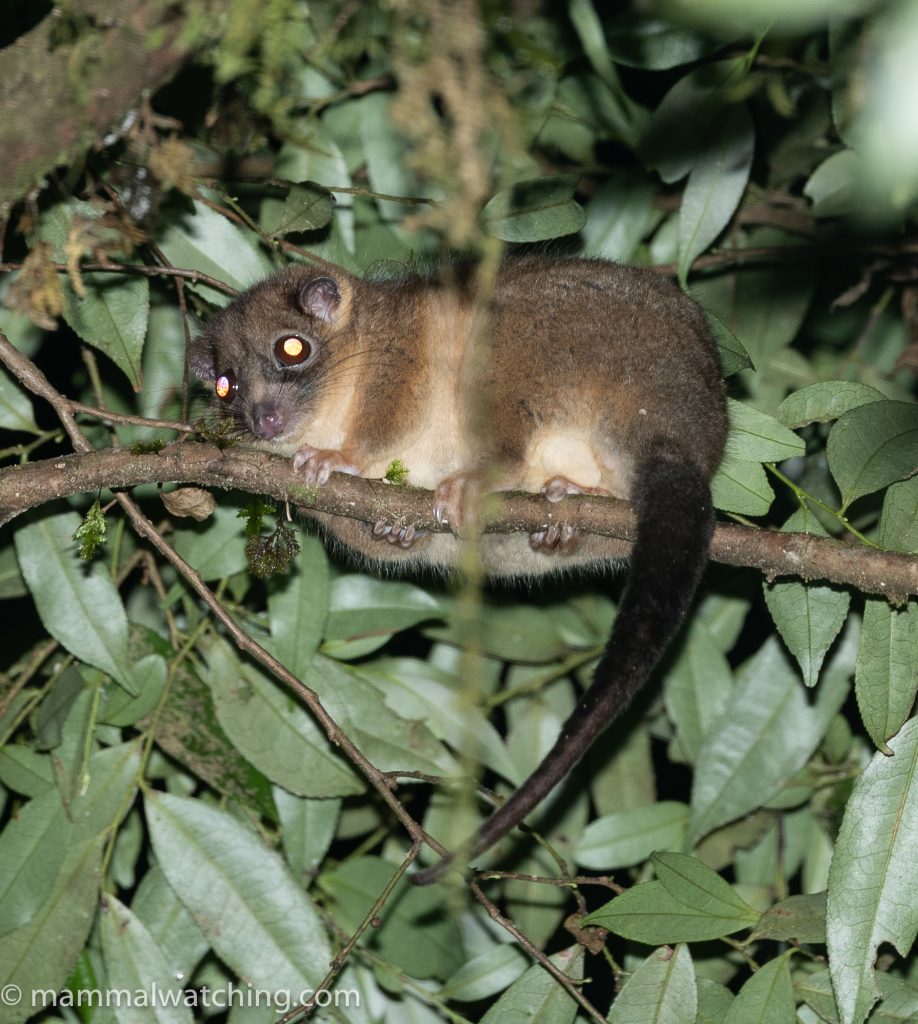
Arfak Ringtail (Pseudochirulus schlegelii)
We found animals on two nights.
D’Albertis’s Ringtail (Pseudochirops albertisii)
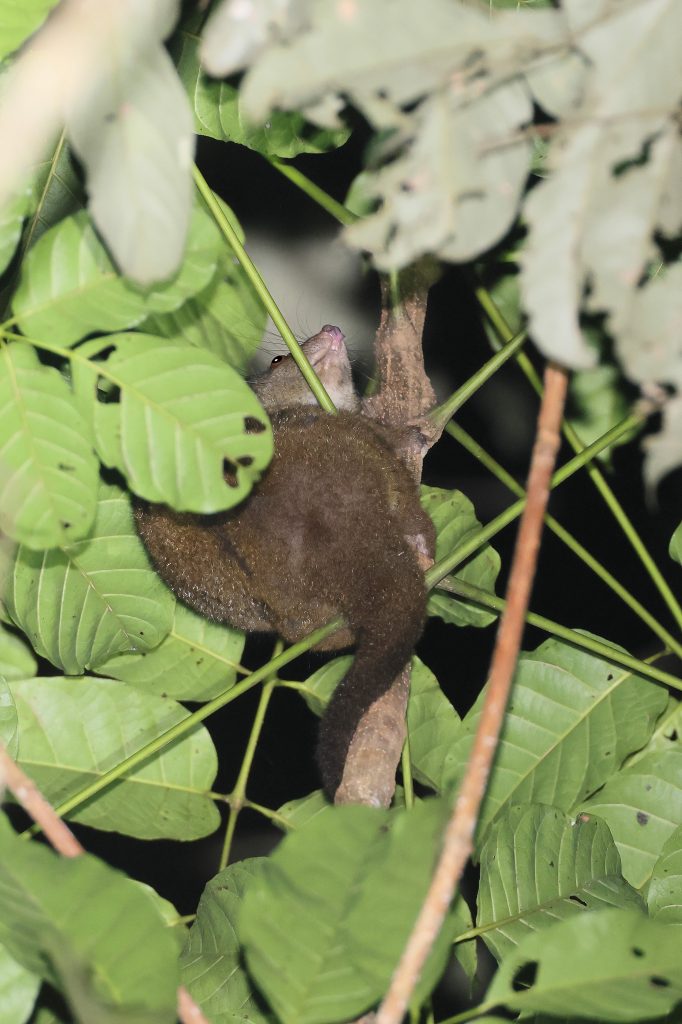
D’Albertis’s Ringtail (Pseudochirops albertisii. Photo Carlos Bocos.
Just one seen on our last night in Mupi, suggesting there were still more species to find there had we stayed longer.
Reclusive Ringtail (Pseudochirops coronatus)
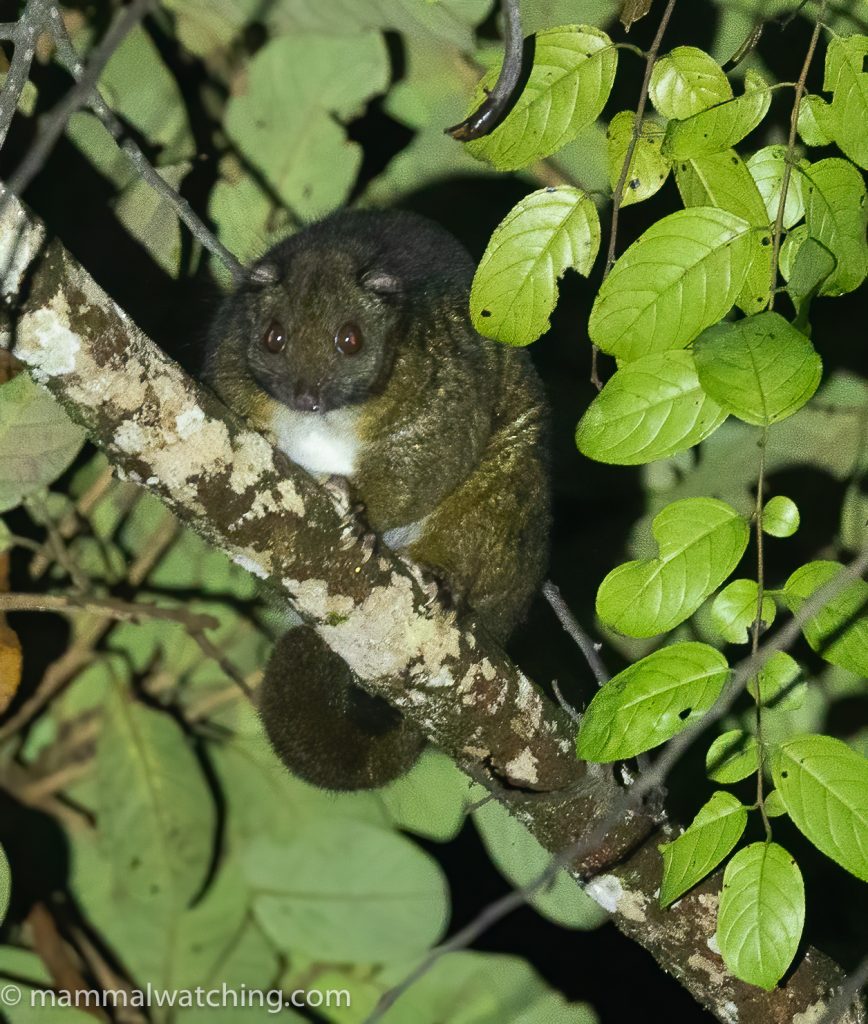
Reclusive Ringtail (Pseudochirops coronatus)
We saw this smart possum on two nights.
Striped Possum (Dactylopsila trivirgata)
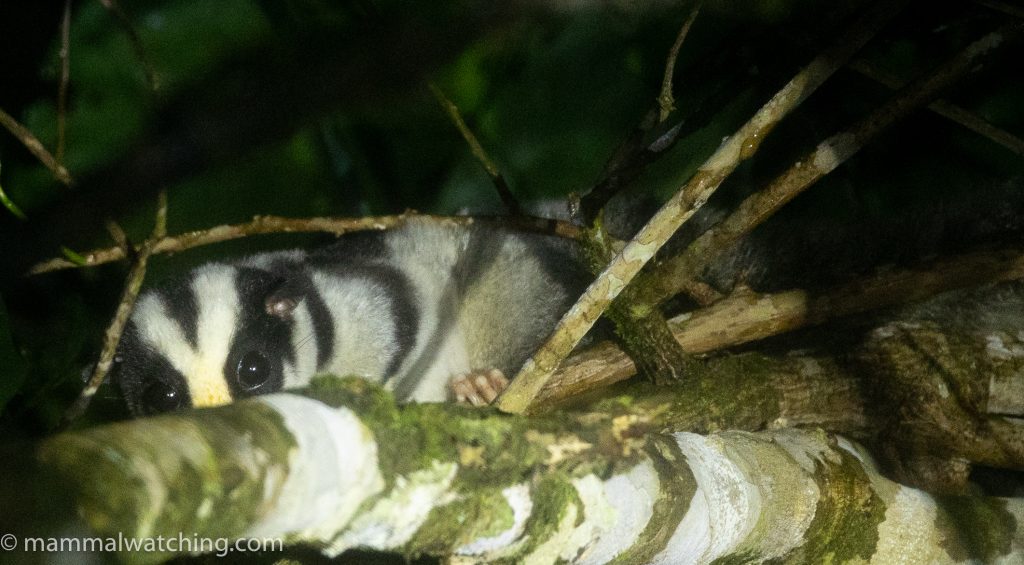
Striped Possum (Dactylopsila trivirgata)
We saw this species two or perhaps three times. One sighting – at the bird of paradise hide – was too brief to be know whether we were looking at a Striped Possum or a Long-fingered Triok.
Papuan Glider (Petaurus papuanus)
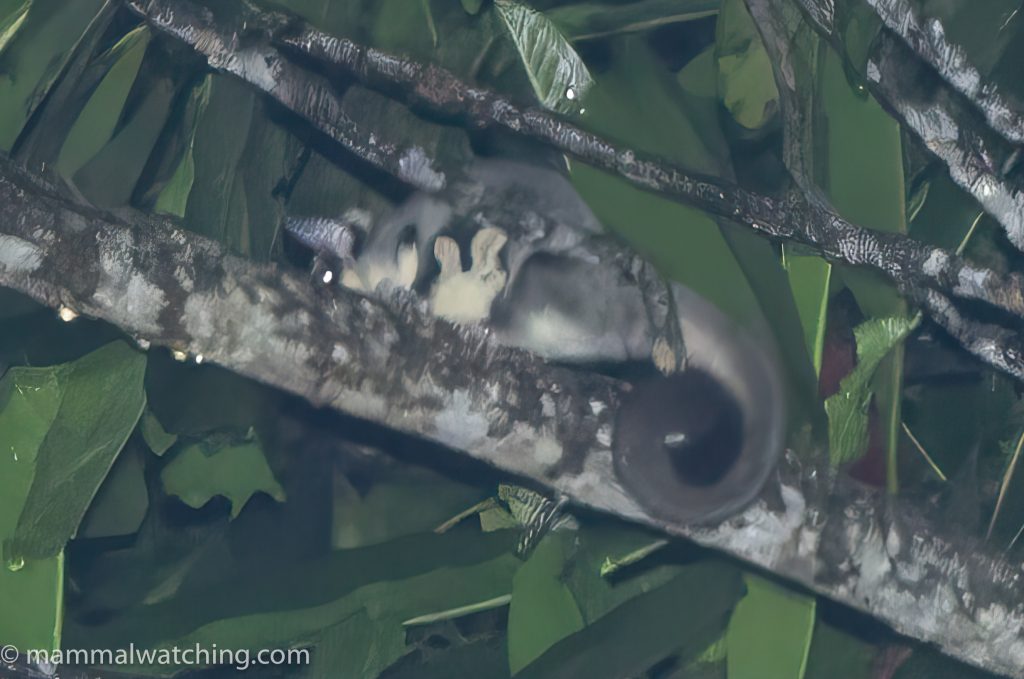
Papuan Glider (Petaurus papuanus)
One seen on our first evening while we were eating dinner: I found it with my thermal scope in a distant tree next to the church.
Feather-tailed Possum (Distoechurus pennatus)
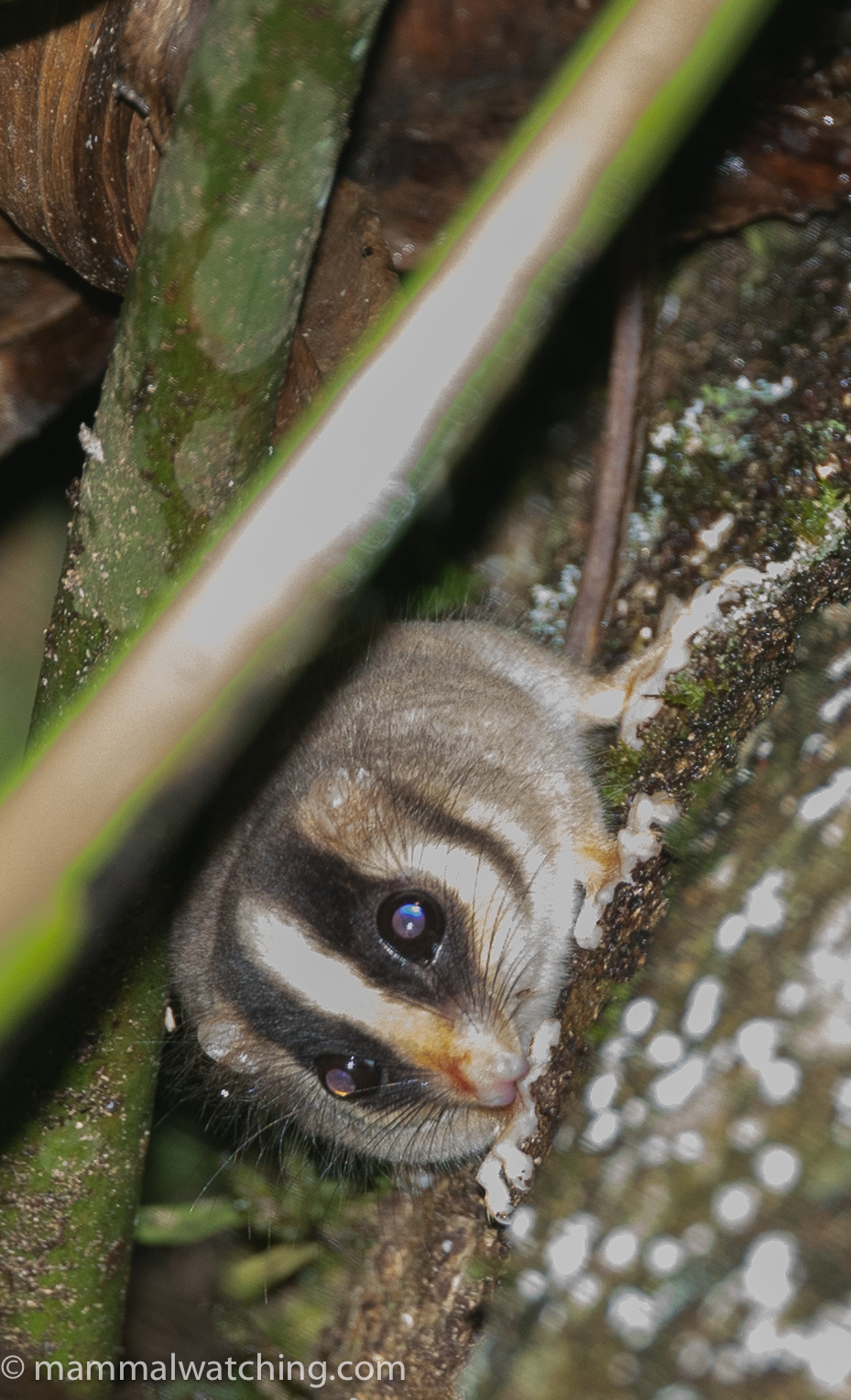
Feather-tailed Possum (Distoechurus pennatus)
Another highlight of the trip were two of these pretty relatives of the Australian feathertail gliders. Seen on different nights and both close to our camp.
Grizzled Tree Kangaroo (Dendrolagus inustus)
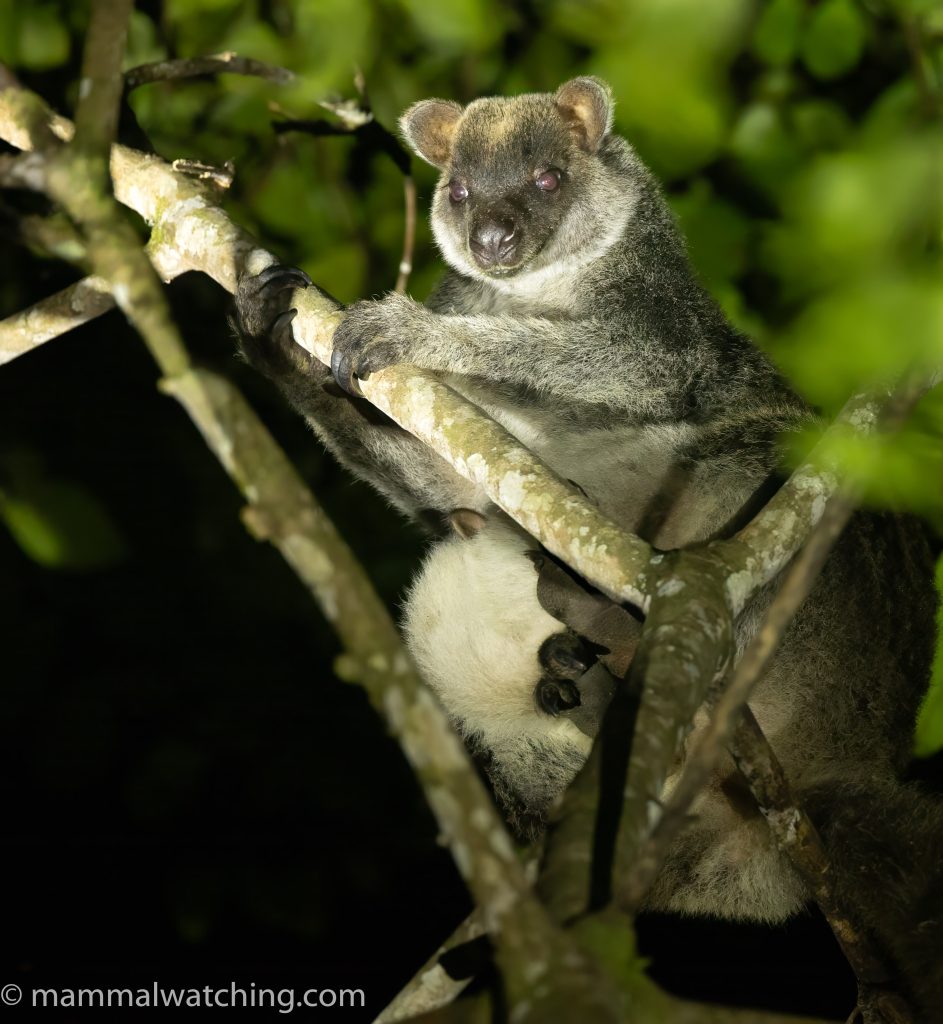
Grizzled Tree Kangaroo (Dendrolagus inustus)
We saw three Grizzled Tree Kangaroos, a species we had not expected to find at Mupi. The first was found by the local community for us in the day time. Most days they were actively searching the slopes for tree kangaroos and the animal below was quite close to the accommodation.
On our last night we found two more – presumably a mother and sub adult – with our thermal scopes deeper into the forest. They seems remarkably unconcerned by our present.
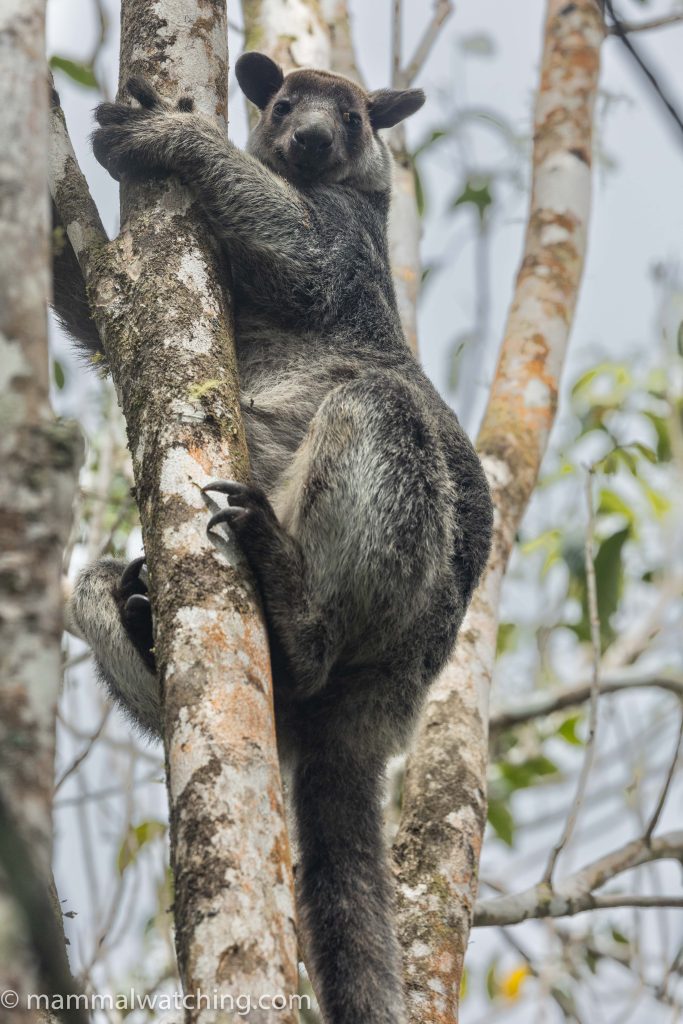
Grizzled Tree Kangaroo (Dendrolagus inustus)
Vogelkop Tree Kangaroo (Dendrolagus ursinus)
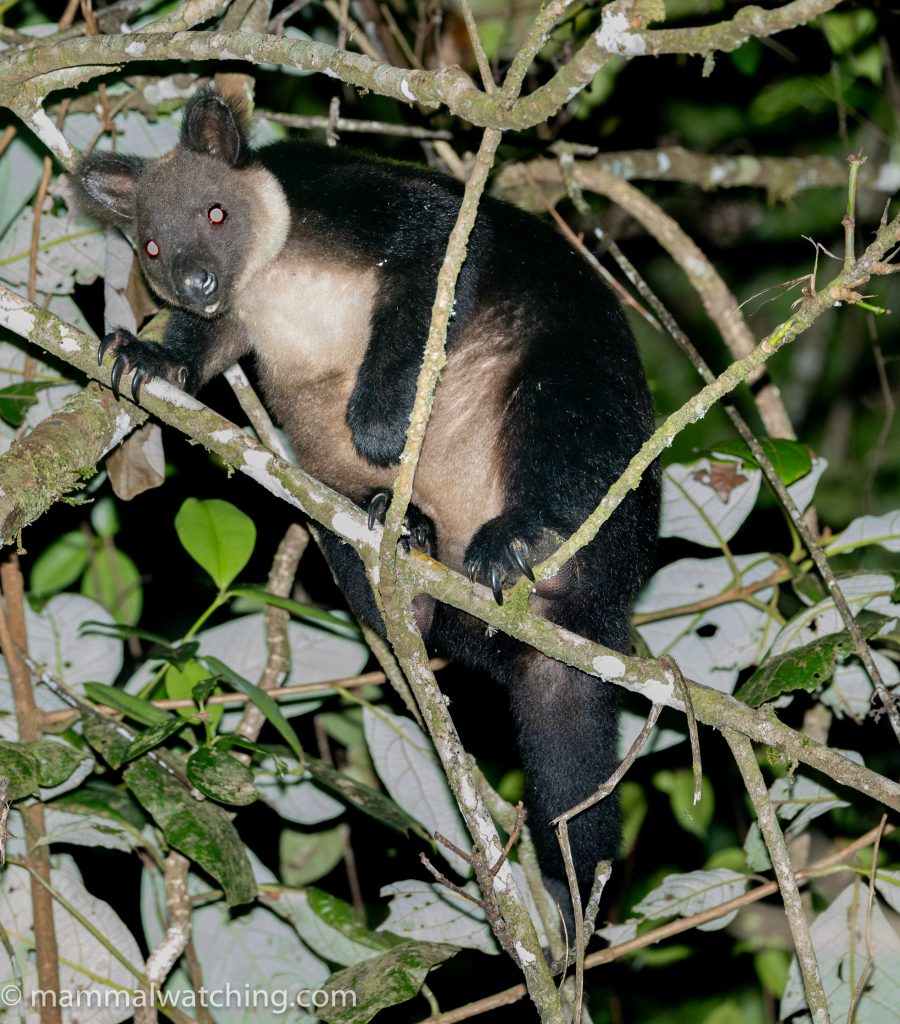
Vogelkop Tree Kangaroo (Dendrolagus ursinus)
Vogelkop’s – or Ursine – Tree Kangaroo was our main target for Gunung Mupi and we had an extraordinary three separate encounters with six animals.
On our first full day on the mountain the villagers located two animals just after lunch and we had prolonged views of this pair below after a 45 minute climb from camp.
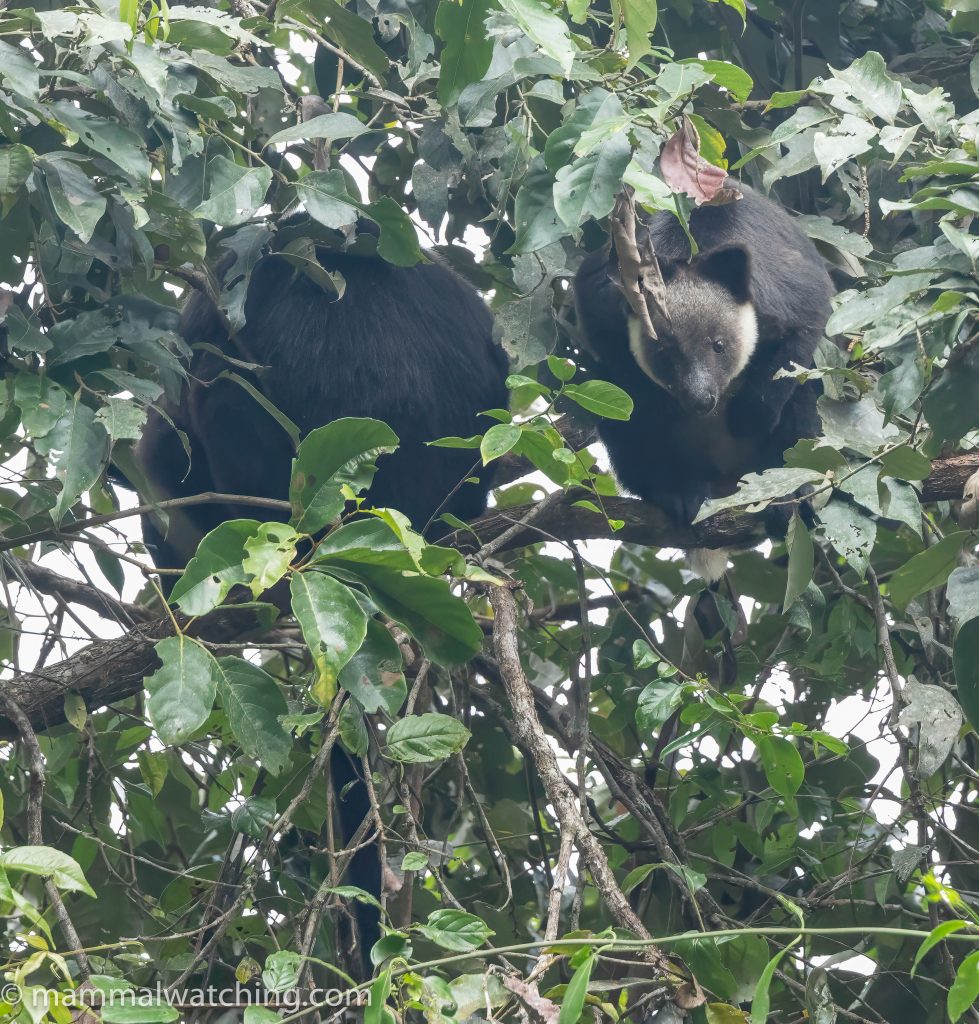
Vogelkop Tree Kangaroo (Dendrolagus ursinus)
Two days later in the late afternoon we got word they had found a Grizzled Tree Kangaroo in the same area. We raced up there (‘raced’ relative to my normal speed, not that of any of the locals)and arrived at dusk to find the lone Vogelkop male below.
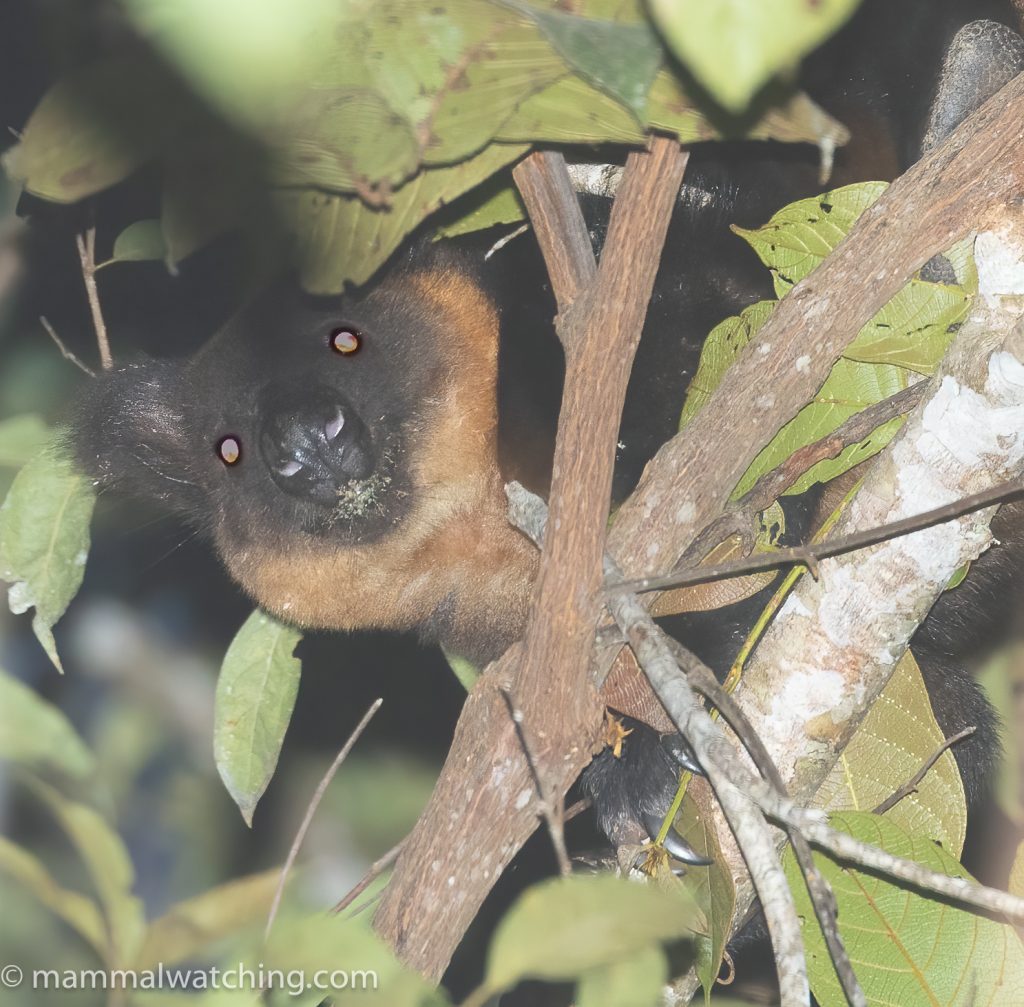
Vogelkop Tree Kangaroo (Dendrolagus ursinus)
We carried on spotlighting and the night continued successfully with some nice species and climaxed in three more Vogelkop’s Tree Kangaroos feeding peacefully right above us: a mother and a sub-adult and a tiny joey that we were oblivious too, but who’s ear Fiona Reid spotted poking out of the pouch in one of Carlos’s pictures.
The evening quickly deteriorated when we were persuaded to take a ‘shortcut’ from hell to avoid the switchbacks on the main trail (we were trying to gain altitude to search for Stein’s Cuscus). The shortcut was a near vertical scramble through very dense forest for over an hour as we followed the villagers hacking a trail, and determined not to turn back. By the time we were back on the main trail, exhausted and ragged from scratches, we decided to cut our losses and return straight to camp. You can’t win them all.
Broad-headed Tree Mouse (Chiruromys lamia) – (possible)
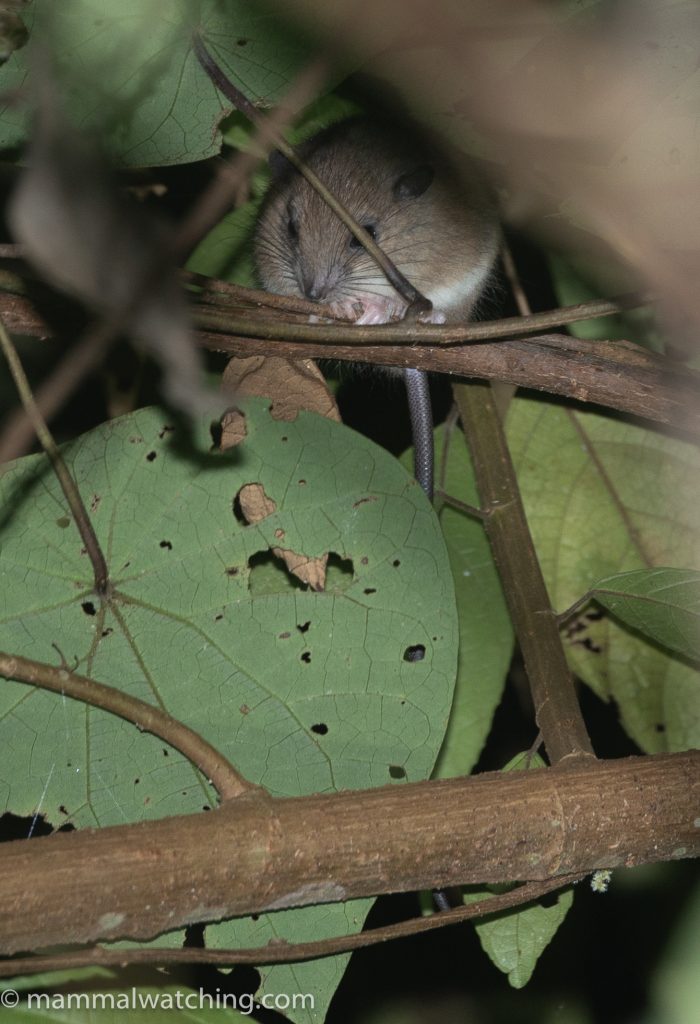
Possibly a Broad-headed Tree Mouse (Chiruromys lamia)
A mystery species we found in a tree close to the bird of paradise hide. At first we thought it was a pogonomys, then a melomys, but it was small and its face didn’t look right for either species. After looking at Flannery’s Mammals of New Guinea the animal seemed to be a dead ringer for his photo of Broad-headed Tree Mouse. The problem is this species appears only to have been recorded in the south of Papua New Guinea. We are discussing the pictures with experts and one person suggested it might be a juvenile pogonomys. But for the moment is remains a rodent of interest. I include several pictures here in case someone stumbles on them and can help with the identification.
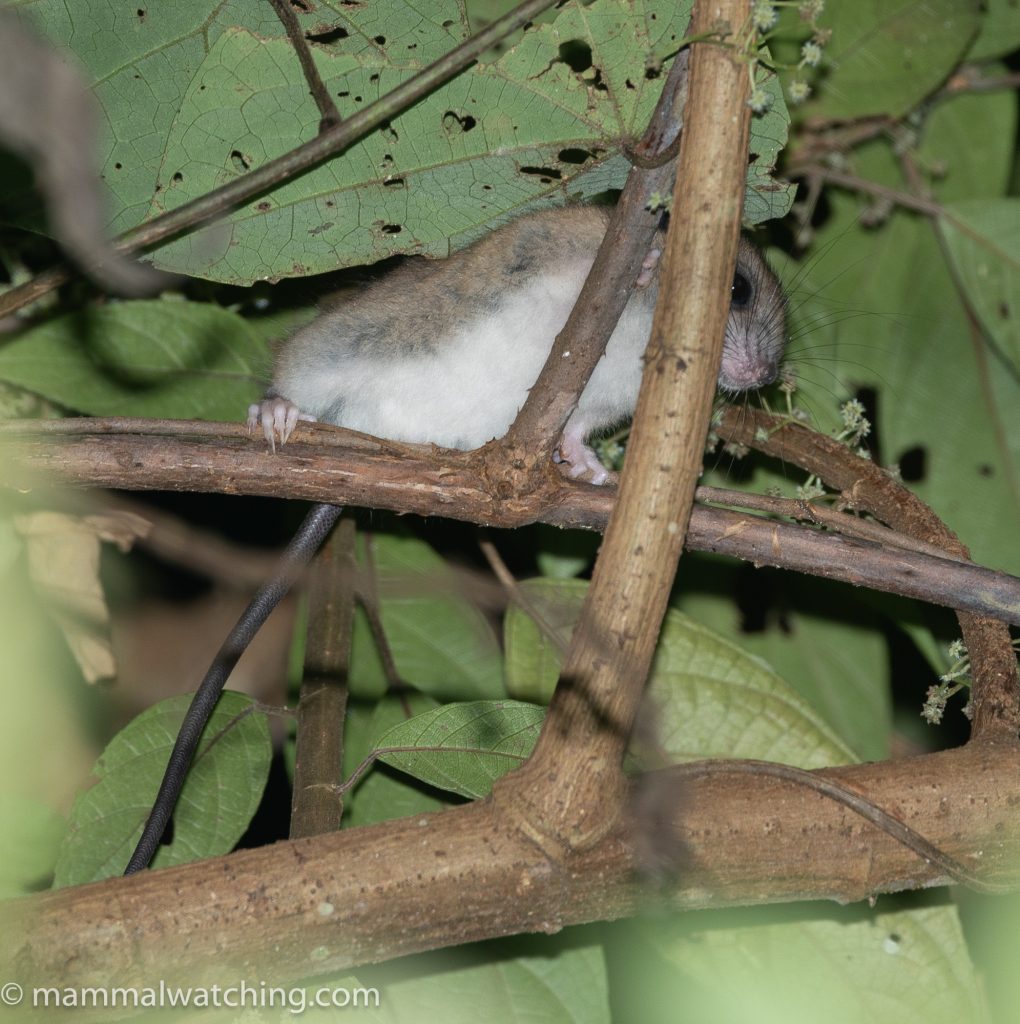
Possibly a Broad-headed Tree Mouse (Chiruromys lamia)
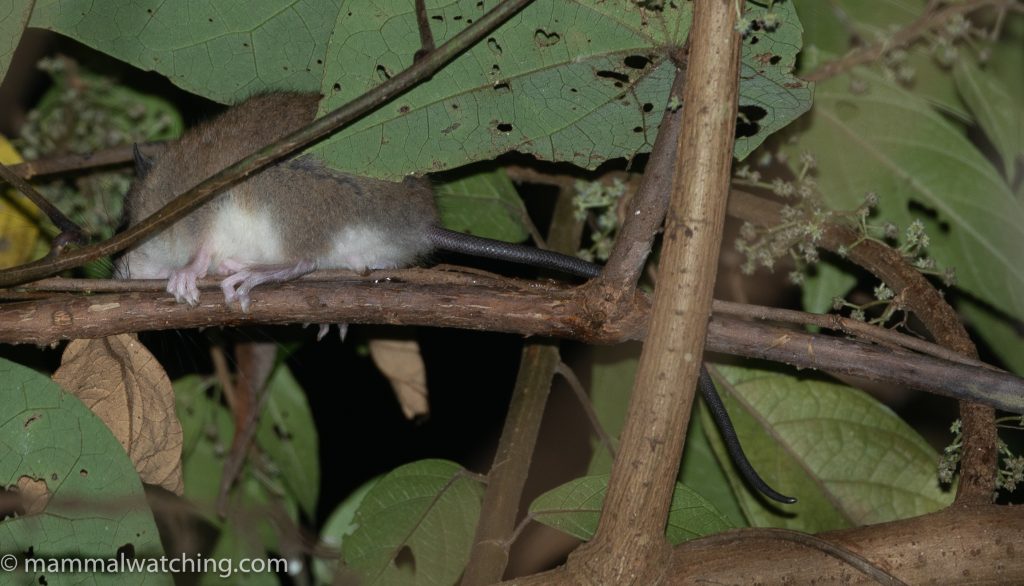
Possibly a Broad-headed Tree Mouse (Chiruromys lamia)
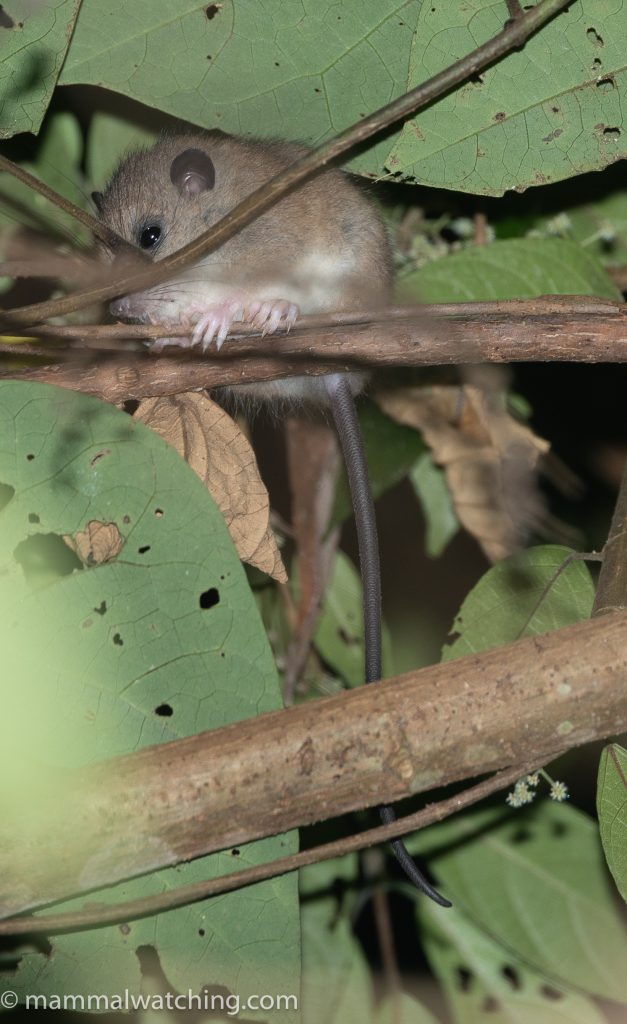
Possibly a Broad-headed Tree Mouse (Chiruromys lamia)
Black-tailed Melomys (Melomys rufescens)
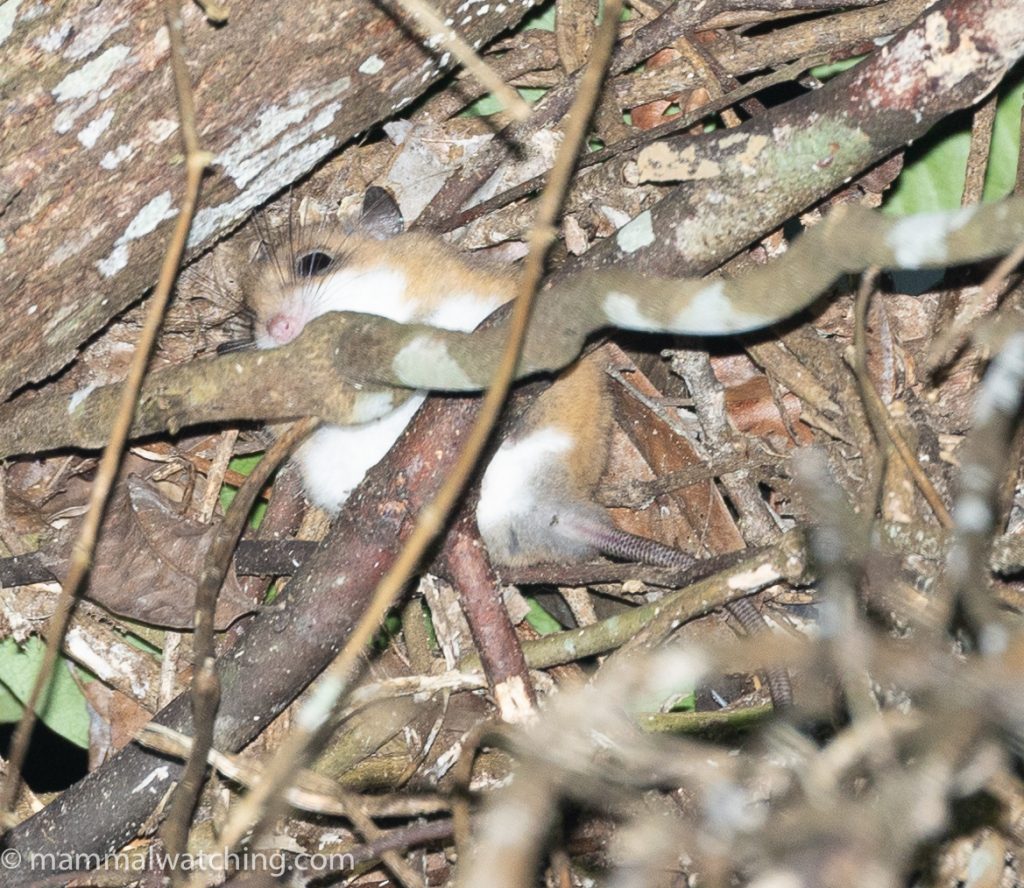
Black-tailed Melomys (Melomys rufescens)
One animal, identified on colour and overall jizz.
Chestnut Tree Mouse (Pogonomys macrourus)
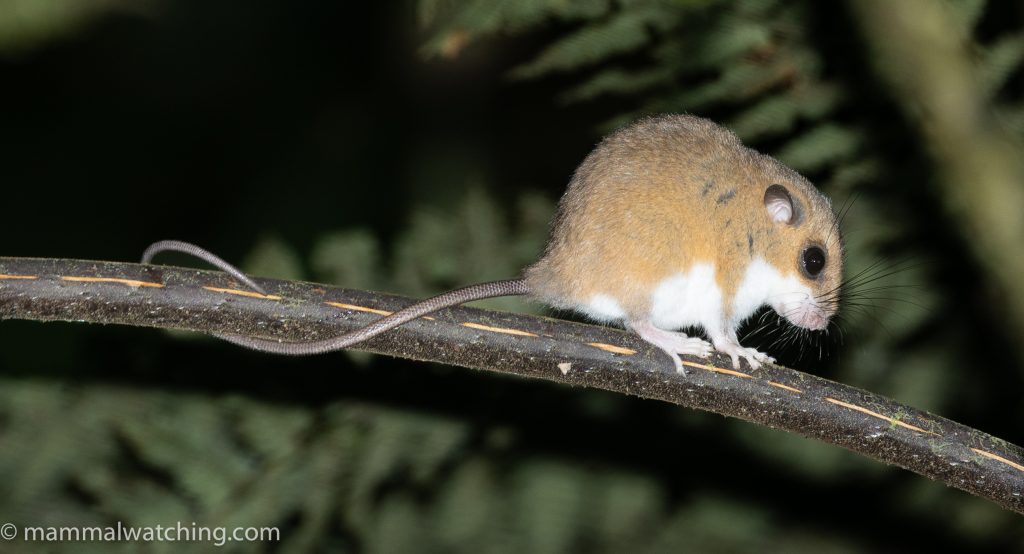
Chestnut Tree Mouse (Pogonomys macrourus)
Seen twice on Mupi. A much richer rufous brown than its gray-bellied cousin below.
Gray-bellied Tree Mouse (Pogonomys sylvestris)
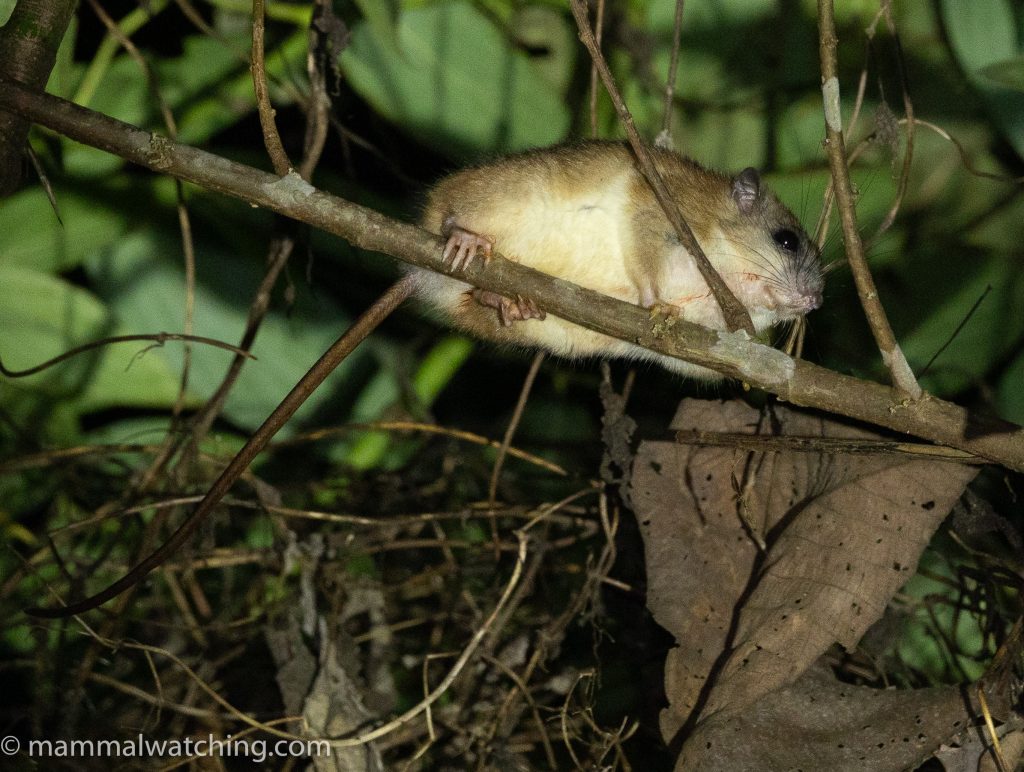
Gray-bellied Tree Mouse (Pogonomys sylvestris)
One on our first night walk. We debated whether it was Pogonomys sylverstris or P. macrourus at some length but settled on sylvestris because it was much less red than the pictures of macrourus in the field guide. Our subsequent sightings of Chestnut Tree Mice appears to confirm our ID.
Geoffroy’s Rousette (Rousettus amplexicaudatus)
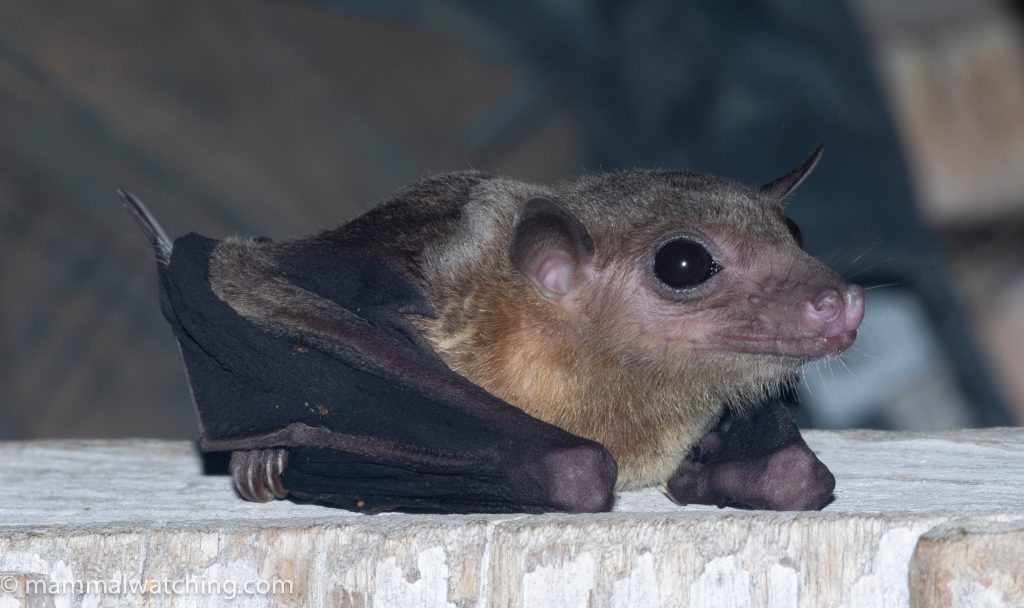
Geoffroy’s Rousette (Rousettus amplexicaudatus)
One found close to our accomodation.
Dagger-toothed Long-nosed Fruit Bat (Macroglossus minimus)
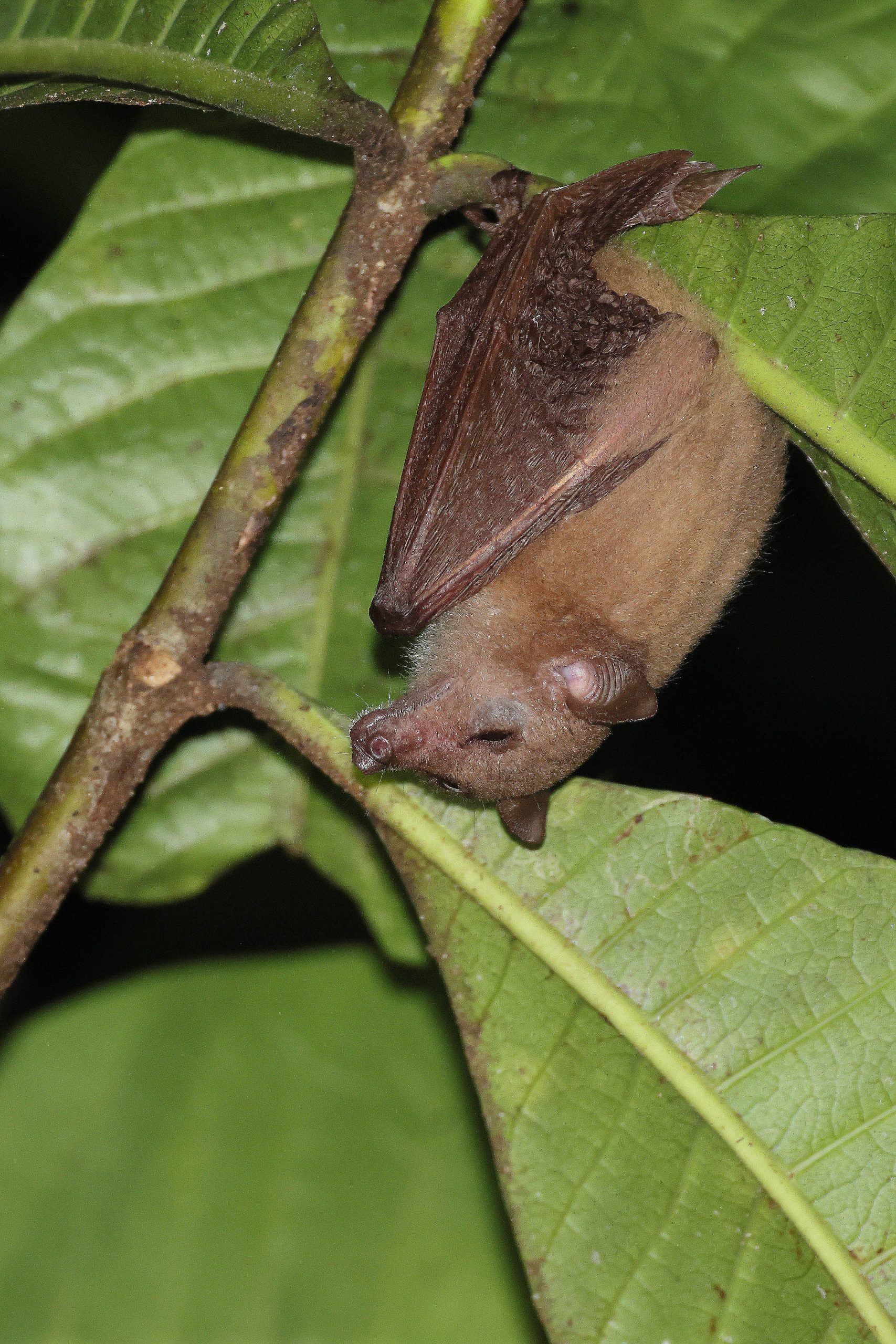
Dagger-toothed Long-nosed Fruit Bat (Macroglossus minimus). Photo Carlos Bocos.
Rather similar to the more commonly seen syconycteris, we saw only one bat we fully confirmed as this species with its longer snout.
Common Blossom Bat (Syconycteris australis)
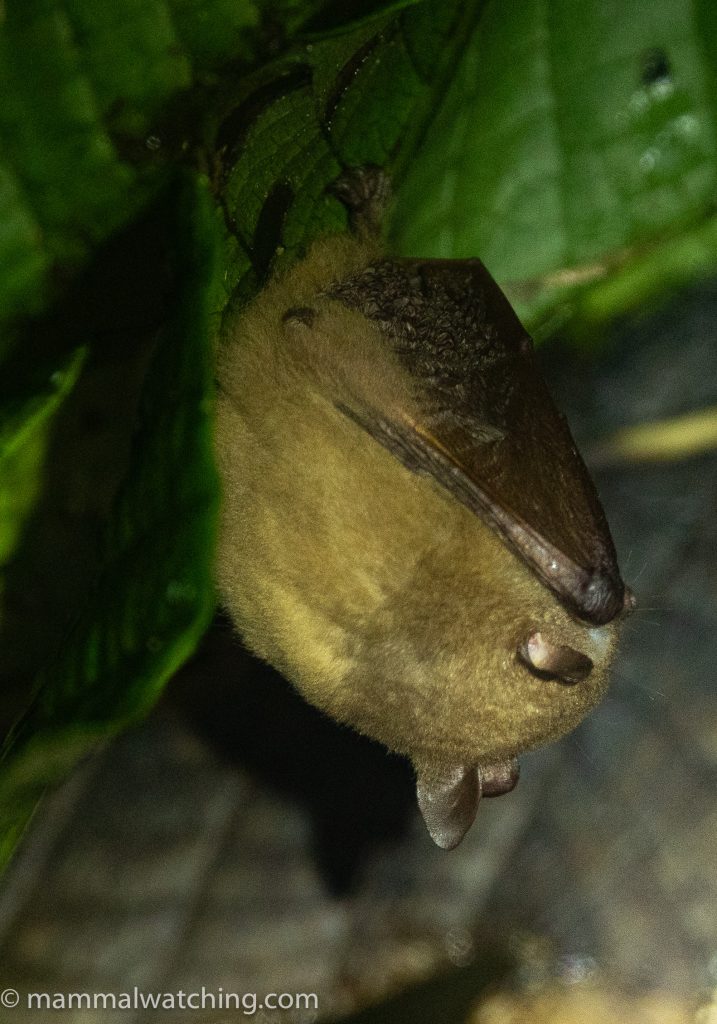
Common Blossom Bat (Syconycteris australis)
Seen most days hanging from perches at night.
Moluccan Naked-backed Fruit Bat (Dobsonia moluccensis)
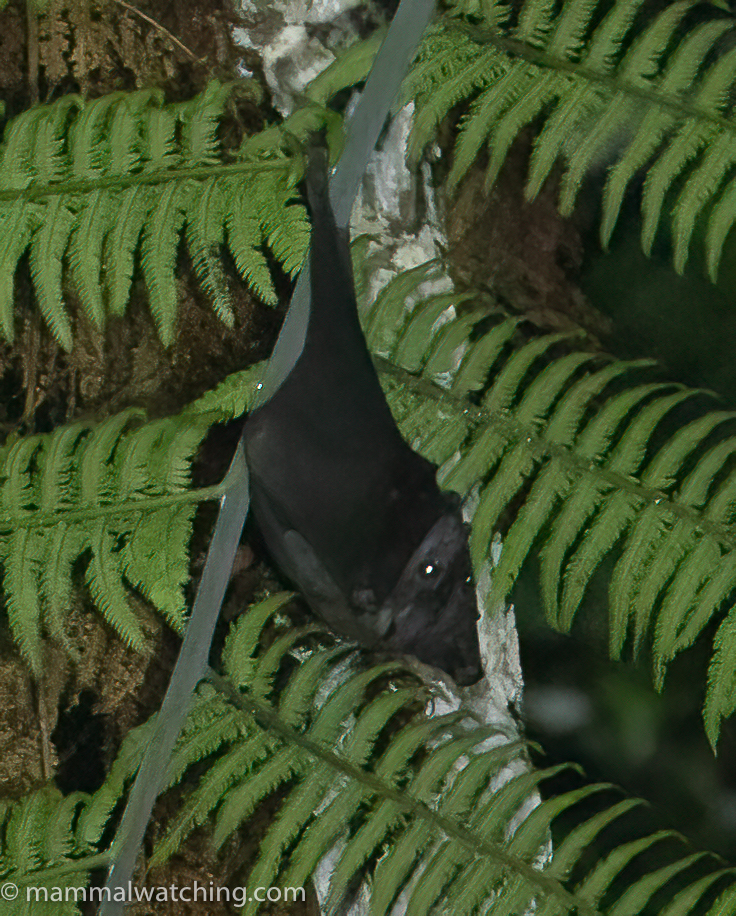
Moluccan Naked-backed Fruit Bat (Dobsonia moluccensis)
Seen – and heard – almost every night at Mupi. The only large fruit bat we encountered there.
Unstriped Tube-nosed Bat (Paranyctimene raptor)
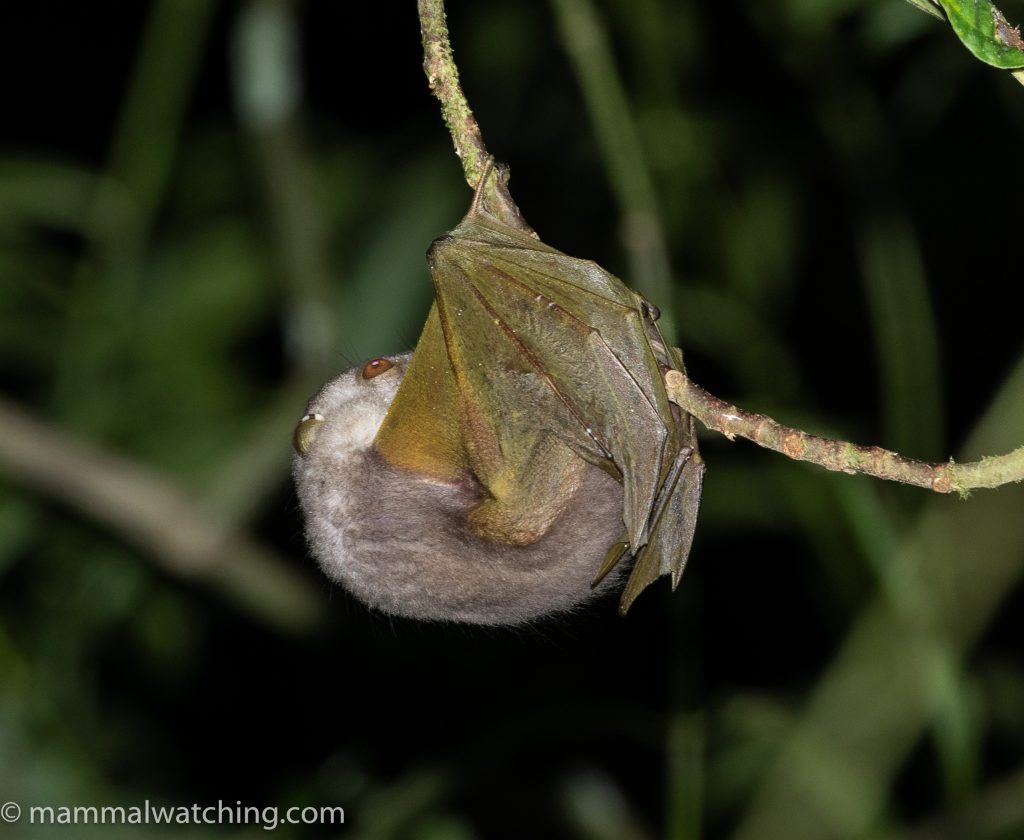
Unstriped Tube-nosed Bat (Paranyctimene raptor)
One found roosting at night. Identified by as a paranyctimene by its greenish wings. Difficult to separate from P. tenax without measurements but for now the latter species is thought to be confined to the south of New Guinea.
Round-eared Tube-nosed Bat (Nyctimene cyclotis)
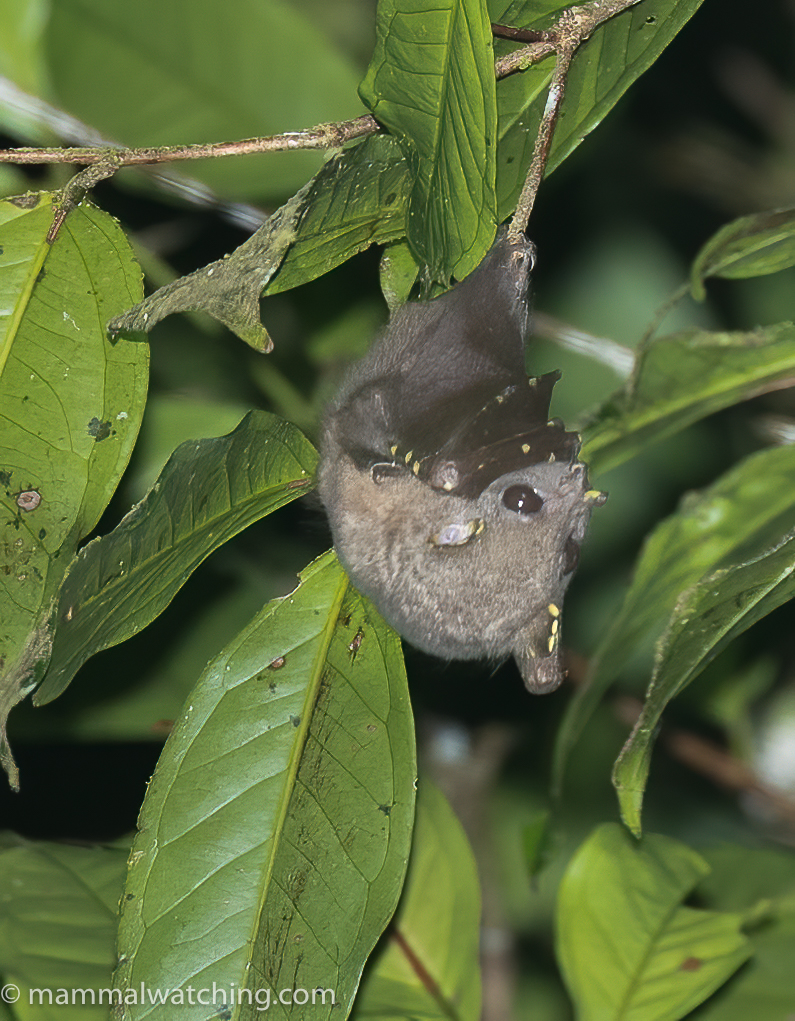
Round-eared Tube-nosed Bat (Nyctimene cyclotis)
A couple seen on separate nights. Identified by its rounded ears and very faint dorsal stripe.Nyctimene aello, so far as we know the only other member of the genus in the region, has a much thicker dorsal stripe. See pictures below from Malagufuk.
Lesser Sheath-tailed Bat (Mosia nigrescens)
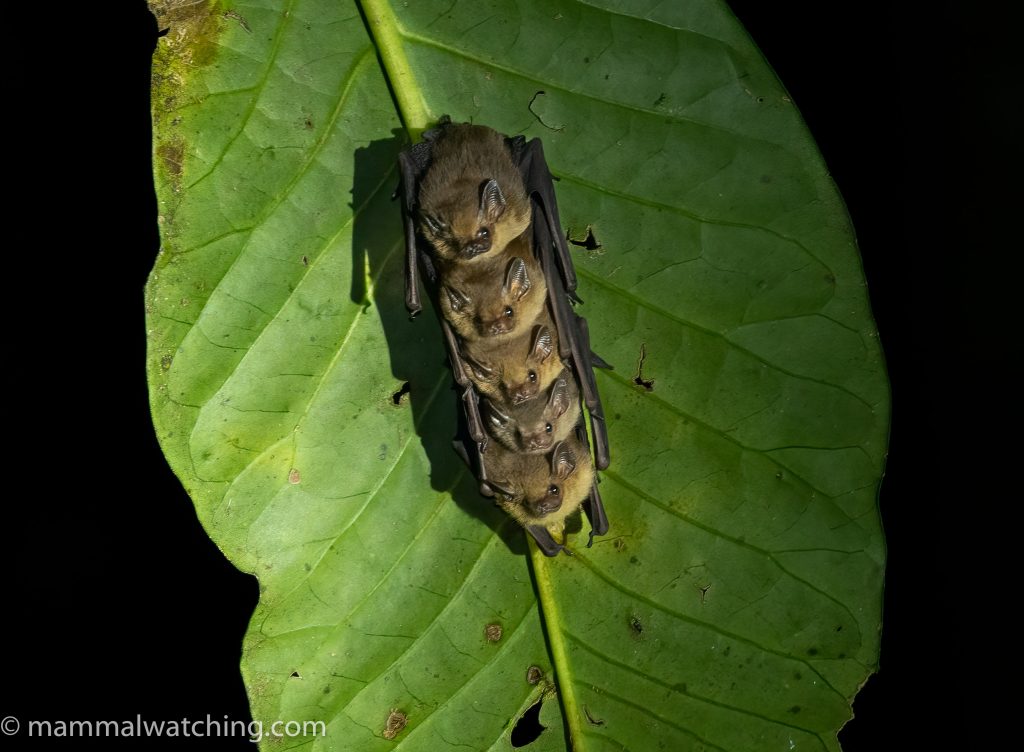
Lesser Sheath-tailed Bat (Mosia nigrescens)
Our thermal scopes found a small group roosting on a leaf at night.
Small Melanesian Bent-winged Bat (Miniopterus macrocneme)
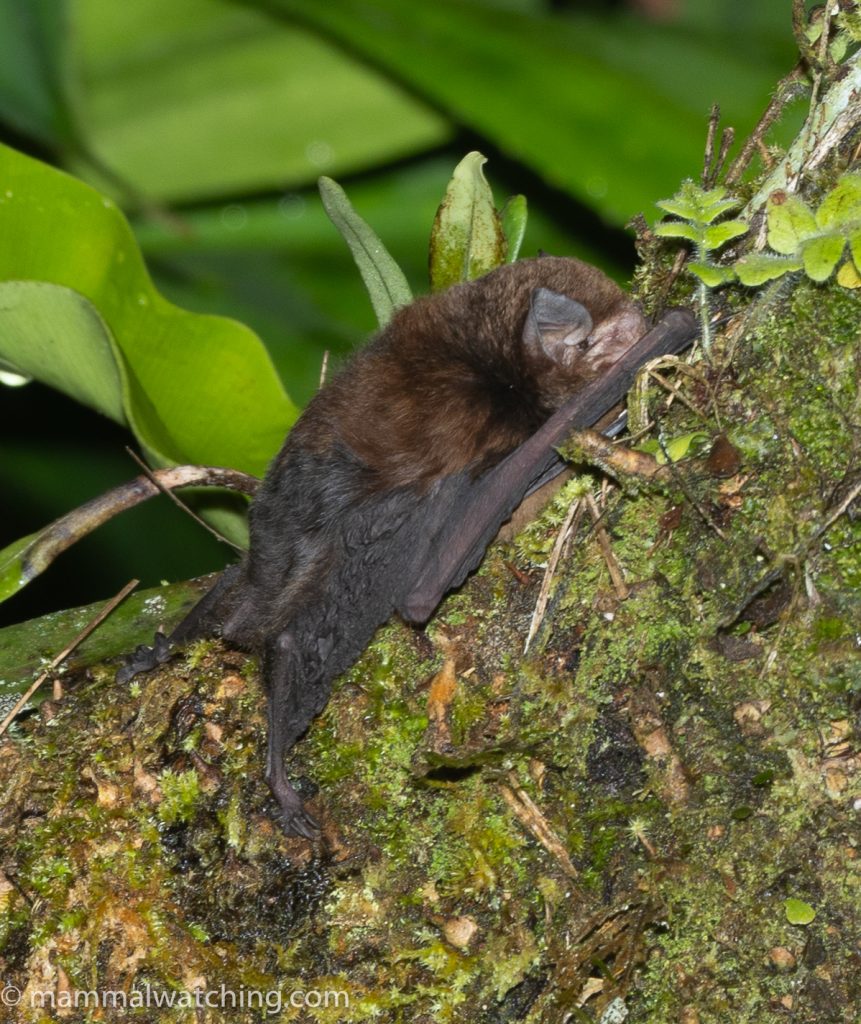
Small Melanesian Bent-winged Bat (Miniopterus macrocneme)
One near our campsite.
Stuff We Missed
We did extraordinarily well in Mupi. It really is a mammalwaching nirvana. We missed a few species that we might have expected, or which ought to have been in range. Long-fingered Trioks ought to be possible there and possibly the Arfak Triok (though its status as a species seems uncertain). Arfak Pygmy Bandicoots are there but extremely hard to see as they are small and largely fossorial. Black-spotted and Common Spotted Cuscuses were both possibilities, and the latter ought to be fairly common. Indeed we were sure we had seen it until we looked at our photographs properly when we got home. Other species we might have encountered include Striped Bandicoot, Papuan Long-eared Bat (Nyctophilus microtis), Vogelkop Mountain Rat (Rattus arfakiensis), Arfak Mountain Leptomys (Leptomys arfakensis), Red-bellied Phascogale (Phascolosorex doriae), Narrow-striped Dasyure and Long-tailed Pygmy Possum. Carlos has seen most of these in the Arfaks during the course of many visits.
The Arfak Birding Trail
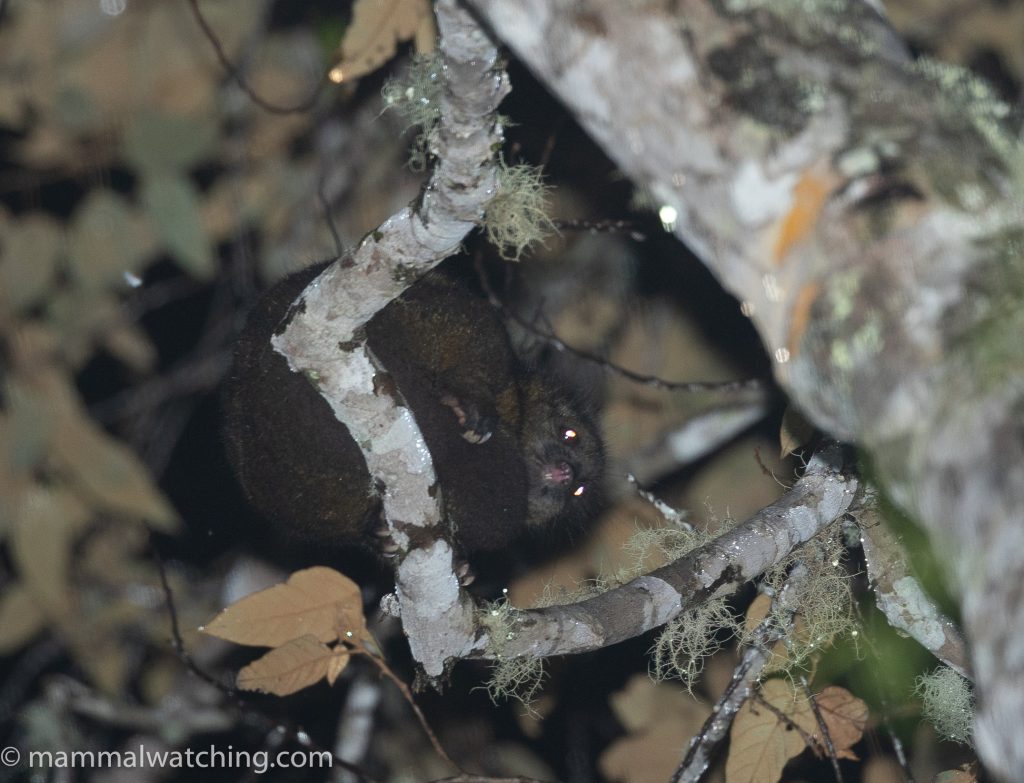
Reclusive Ringtail we think (Pseudochirulus coronatus)
After five nights on Gunung Mupi we returned to the Aston Nui Hotel which now felt like the Four Seasons. We drank milkshakes and celebrated Carlos’s birthday at pizza hut. The next after we had almost recovered from the mountain and drove two hours to Hans Mandacan’s Papua Lorikeet Guesthouse in the Afrak Mountains. After waiting for the rain to stop over a cup of coffee we took a three hour night walk along the trail to the German Camp in Syoubri. Our target here was a strange horseshoe bat – possibly an undescribed species – that Carlos and Nils had seen perched over the trail a few years earlier. We also hoped for a Stein’s Cuscus although Carlos was less optimistic as he had only seen them higher up the mountain around the German Camp itself. We would not have time reach the area in the few hours available.
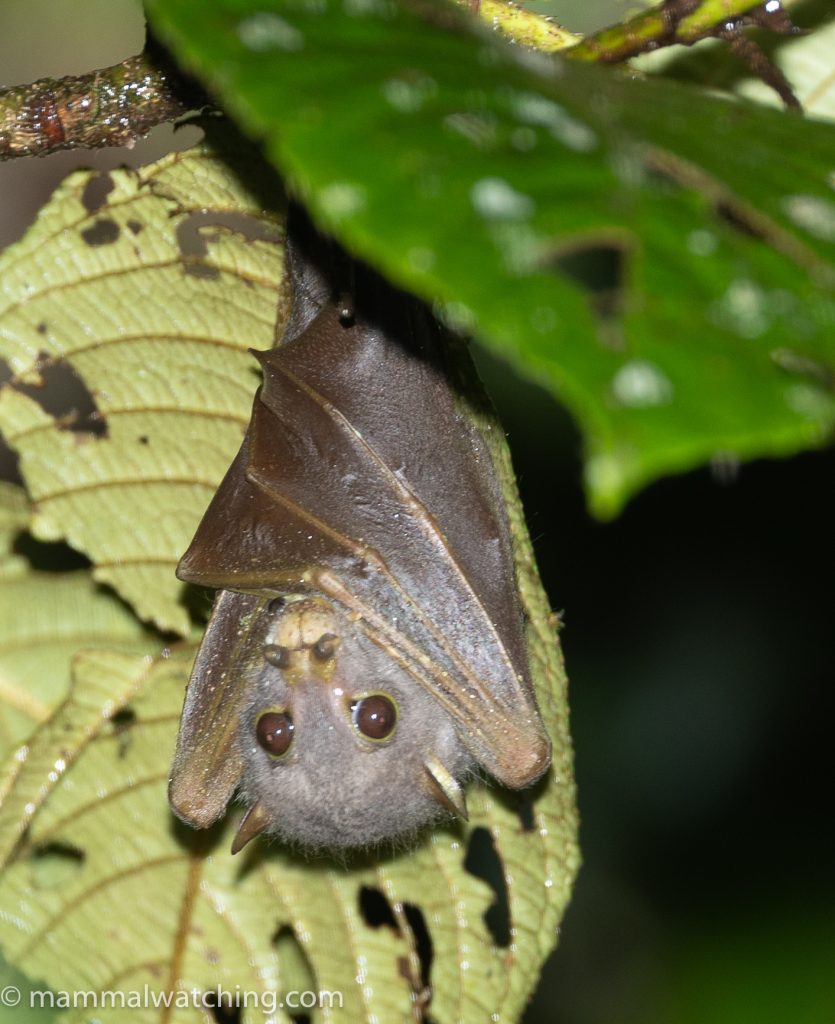
Unstriped Tube-nosed Bat (Paranyctimene raptor)
We focused our time on the lower, flatter section of the trail and after a couple of nice bats and an Arfak Ringtail we found what we thought was a Stein’s Cuscus just as we were about to turn around. But after much discussion it nows seem this animal was more likely a Reclusive Ringtail, even if it looked a bit different to those we had seen earlier.
The Mammals
Reclusive Ringail
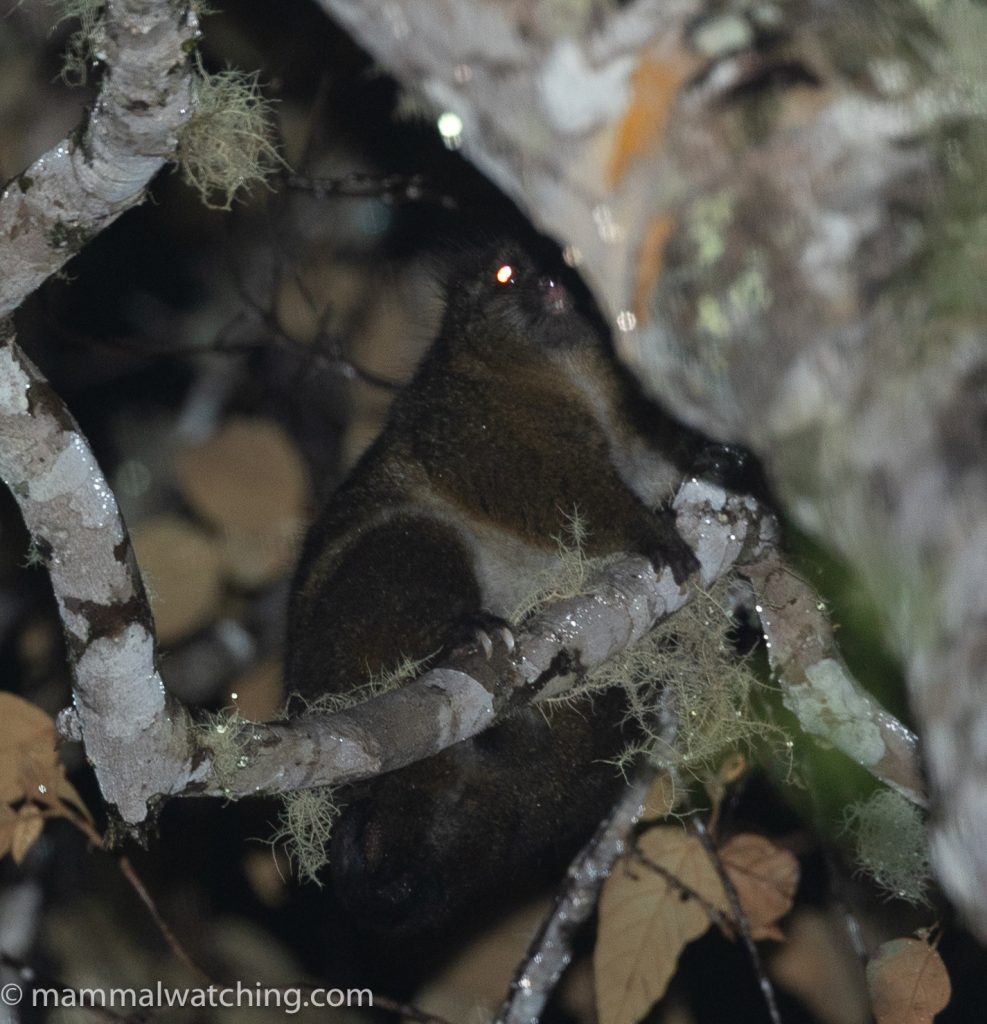
Reclusive Ringrail (Pseudochirulus coronatus)
We saw this animal about 90 minutes along the trail to the German Camp just as the steeper section of the trail began. At first we thought it was a different colour morph to other Stein’s Cuscuses we had seen photos of. After further discussion it seems like it is a slightly odd looking Reclusive Ringtail.
Arfak Ringtail (Pseudochirulus schlegelii)
Several seen along the trail to the German Camp.
Unstriped Tube-nosed Bat (Paranyctimene raptor)
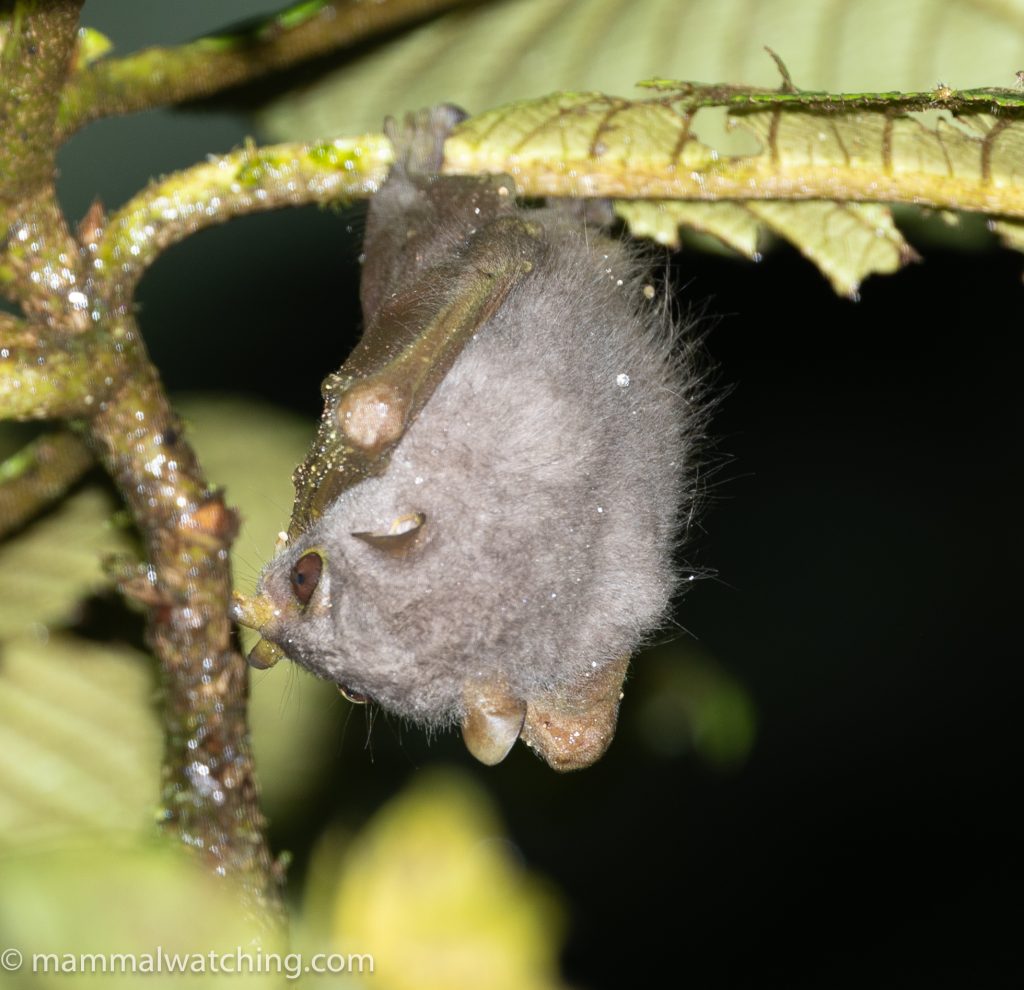
Unstriped Tube-nosed Bat (Paranyctimene raptor)
One found with a thermal scope and identified by its greenish wings as a paranyctimene. The very similar P. tenax is difficult to separate from this species without measurements but, for now at least, the latter species is thought to be confined to the south of New Guinea.
Round-eared Tube-nosed Bat (Nyctimene cyclotis)
One found with a thermal scope and identified by its rounded ears and very faint dorsal stripe (compared to the thick stripe in (N. aello). This species was photographed well at Gunung Mupi.
Bat detected species
Nils recorded two bat species flying around a forest clearing along the trailthat he was pretty sure were identifiable to species level: Papuan Pipistrelle (Pipistrellus papuanus) and Large Bentwing Bat (Miniopterus magnater). I generally don’t count bats I have seen in flight but only identified by Anabat unless I have also seen some features in flight that are ID-worthy. So I have left these off the trip list. But this is just a personal preference and I don’t judge anyone happy to count species this way!
Sorong Area
It is a short flight from Manokwari to Sorong and we were joined there by Carlos’s friend, Juliana Senawi, a bat scientist from Universiti Kebangsaan in Malaysia. After some lunch and last minute supply shopping we set off for our first destination.
Long-beaked Echidna Village
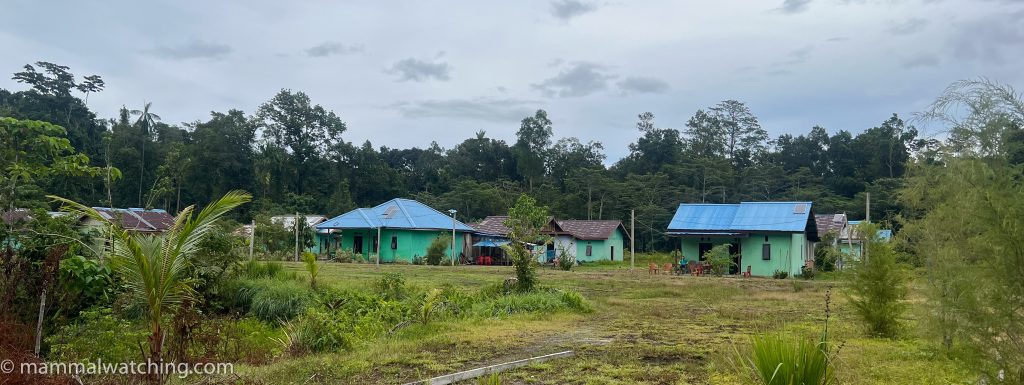
When Carlos started planning the trip we thought we would have a decent chance to see a Western Long-beaked Echidna in Malagufuk. But by 2023 the echidnas were no longer being seen there. We didn’t know why, but the absence of visitors and income during COVID may well have meant subsistence hunting became more important to the local community. This was arguably the main mammal of the trip so the news was more than a little distressing.
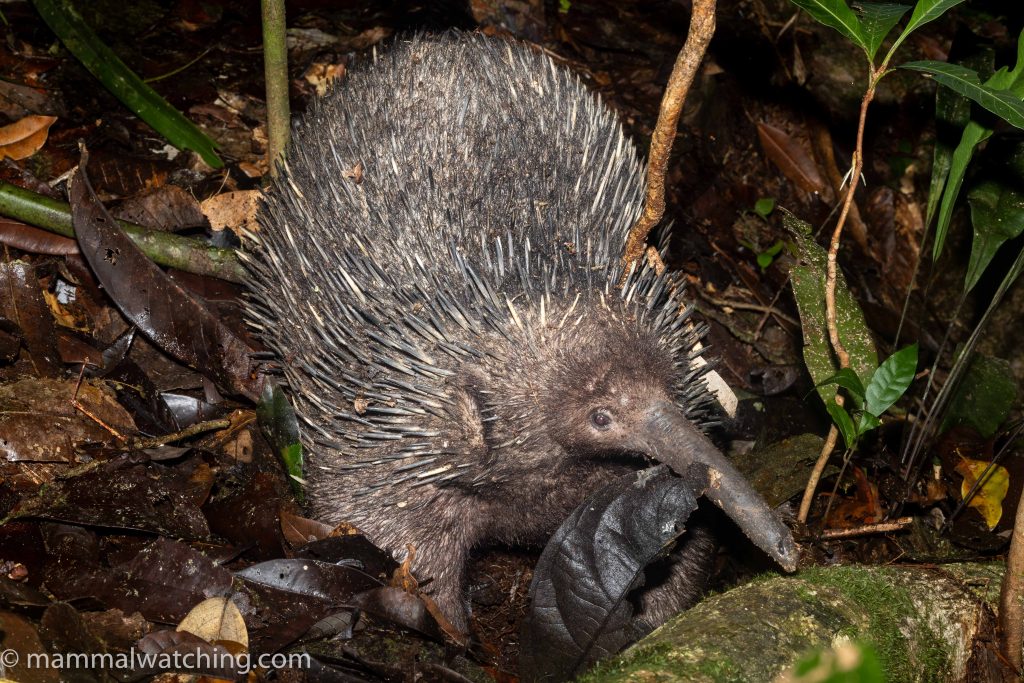
Western Long-beaked Echidna (Zaglossus bruijnii)
But, thanks to Carlos’s wonderful network, he had one of his local guides – Absalom – scout for another site. And Absalom came through after several months of searching. He found a tiny village, only an hour from Malagufuk, where the Echidna seemed like a very good bet. This is an area we have decided not to give details about for the moment: they are not set up for tourism and anyone wanting to visit really ought to do so through Absalom as he has put in all the work to find it. Plus it seems like it could cause some political strife if people started visiting without his involvement. Please contact me for advice on how to get in touch with Absalom: though be aware he might not be an easy guy to reach.
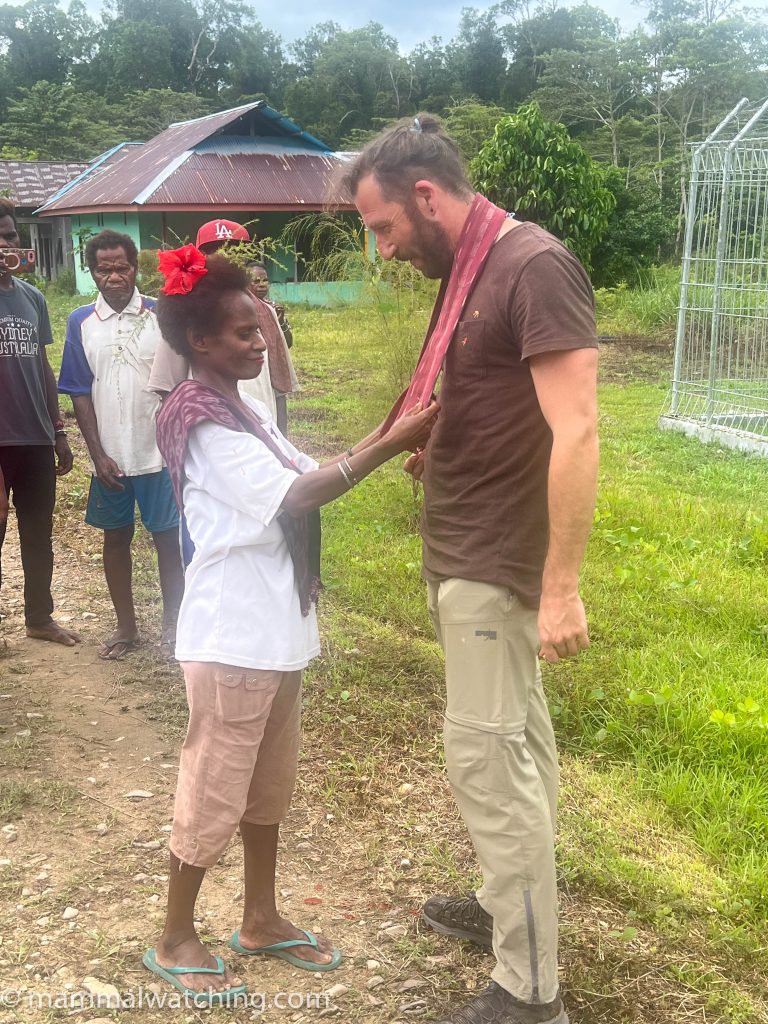
The Festival of Carlos
We were the first foreigners ever to visit the village and they put on a welcome ceremony: all the villagers turned out, the women with fresh flowers in their hair, and Carlos received a ceremonial scarf.
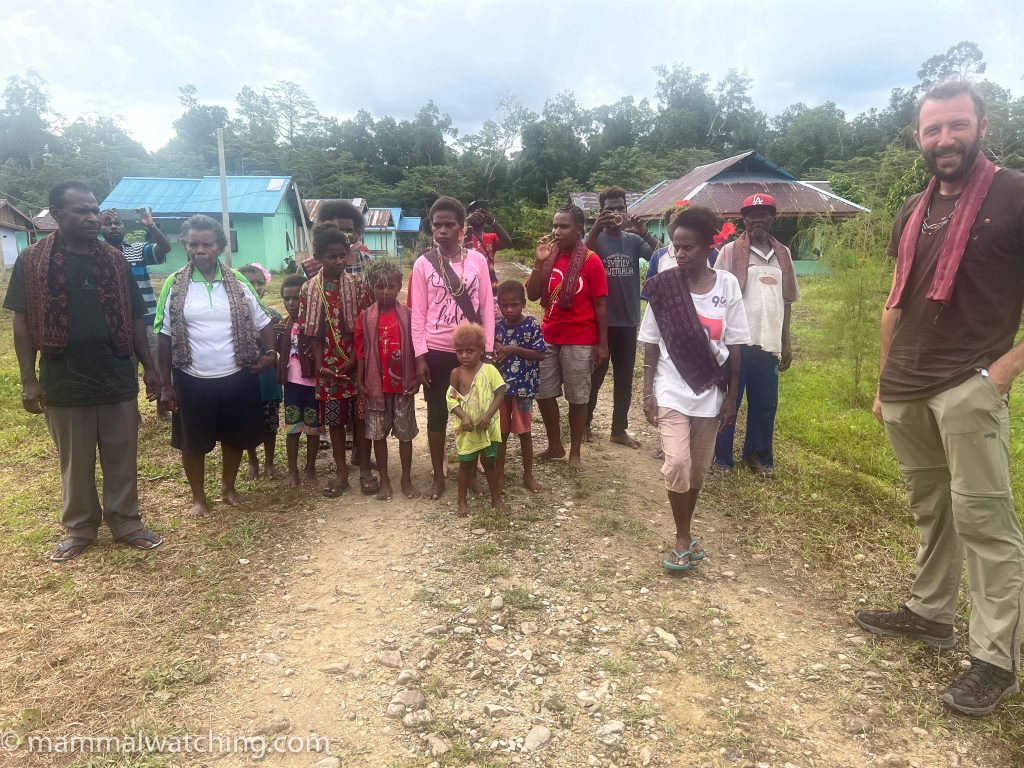
We were given some space on the floors of two very hot, windowless concrete buildings where the humidity was crippling. After two hours we were increasingly desperate to see the echidna that night. Spending a second evening here was not appealing.
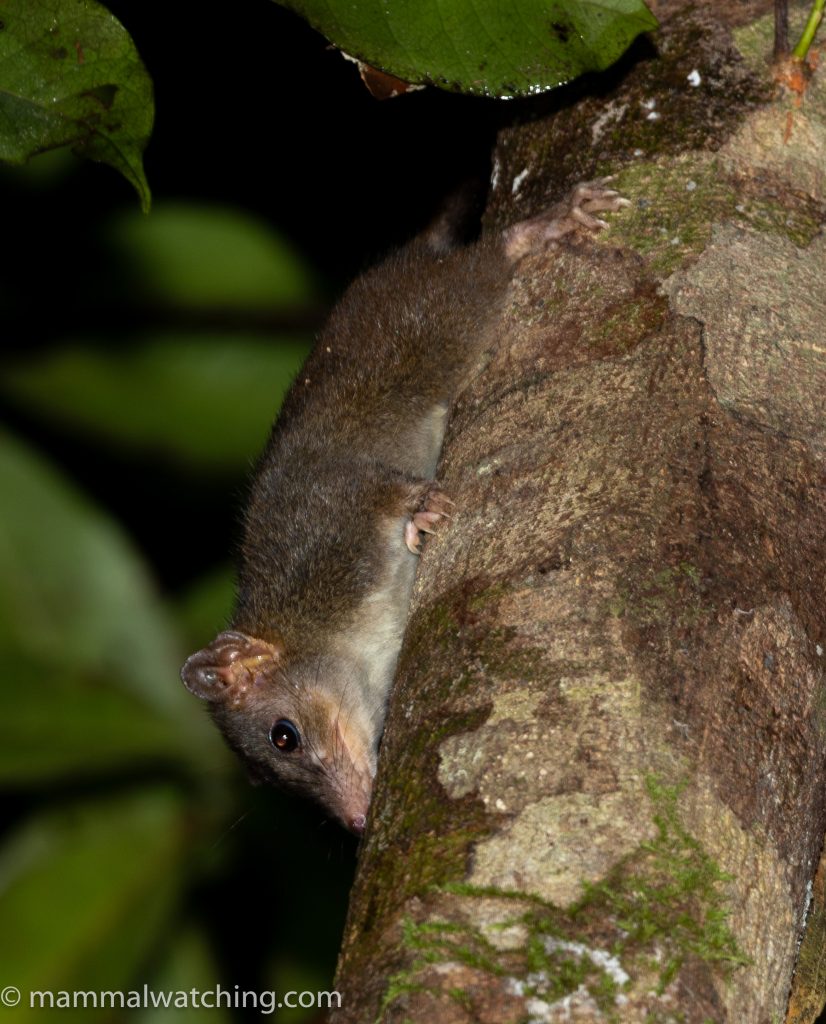
Black-tailed Dasyure (Murexia melanurus)
Once again the local community were wonderful: we set out after dinner into the forest with a gaggle of men and kids running ahead of us searching for the echidna. There was plenty for us to look at as we walked behind them including a beautiful Black-tailed Dasyure (a large antechinus species that brought back a flood of happy Australian memories).
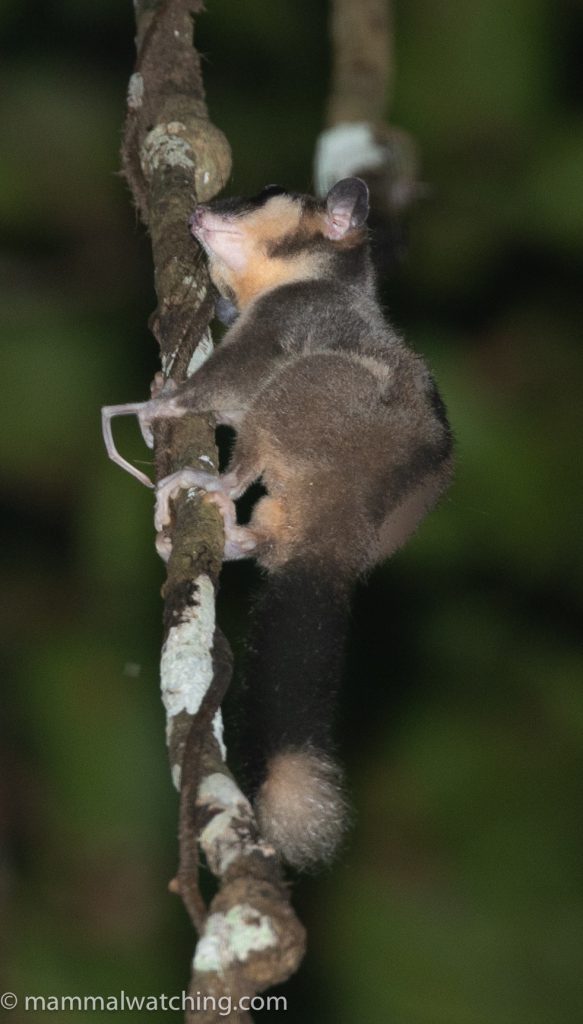
Long-fingered Triok (Dactylopsila palpator)
We rested by a creek after three hours searching and one of the villagers told Carlos he had “a squirrel”. In fact he had somehow caught a Long-fingered Triok by hand. We still have no idea how he caught it.
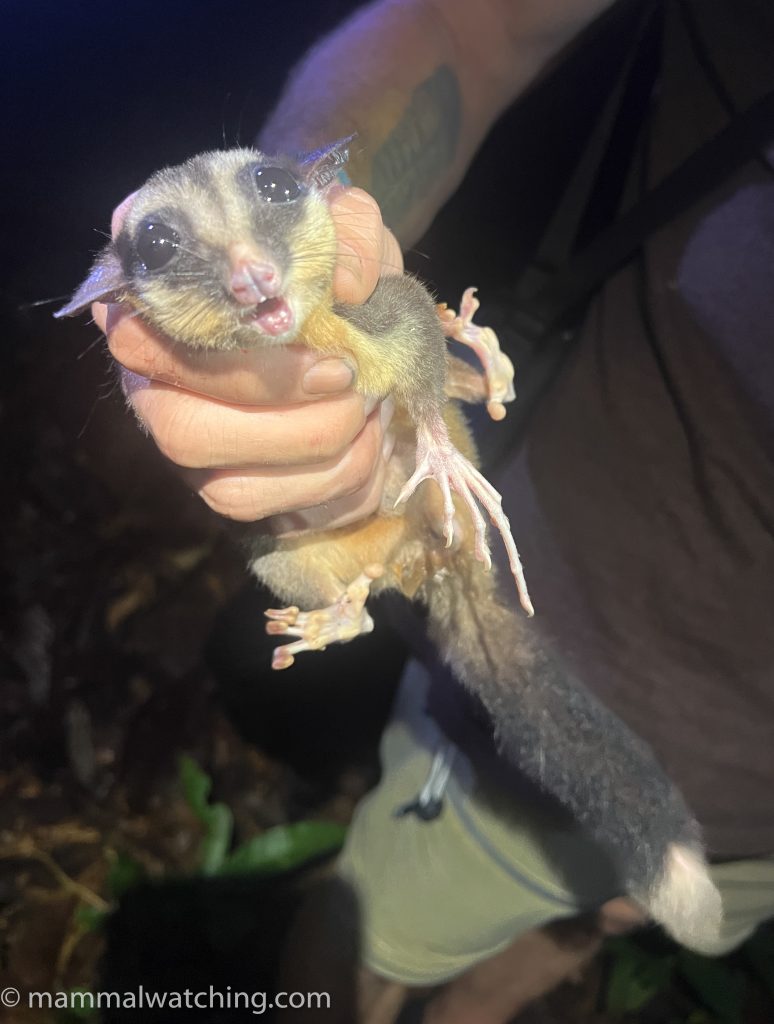
Long-fingered Triok (Dactylopsila palpator)
What a fabulous creature and one we had hoped to see in the Arfaks but not expected in the lowlands.
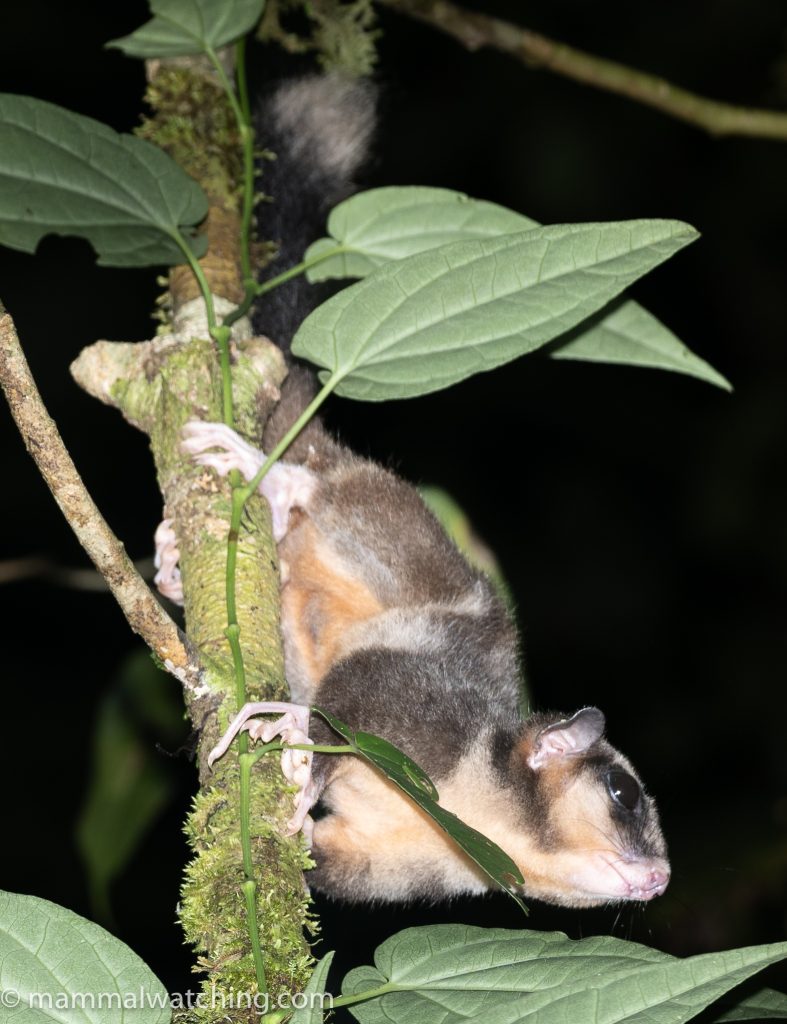
Long-fingered Triok (Dactylopsila palpator)
It was now after 11pm and we were becoming sceptical about our echidna prospects. Even the indefatigable Carlos was beginning to have doubts. “These echidnas are not playing ball” he sighed. But as the words hung in the air a roar echoed through the forest. The sort of roar that says ‘I’ve found a long-beaked echidna so you had better start moving’.
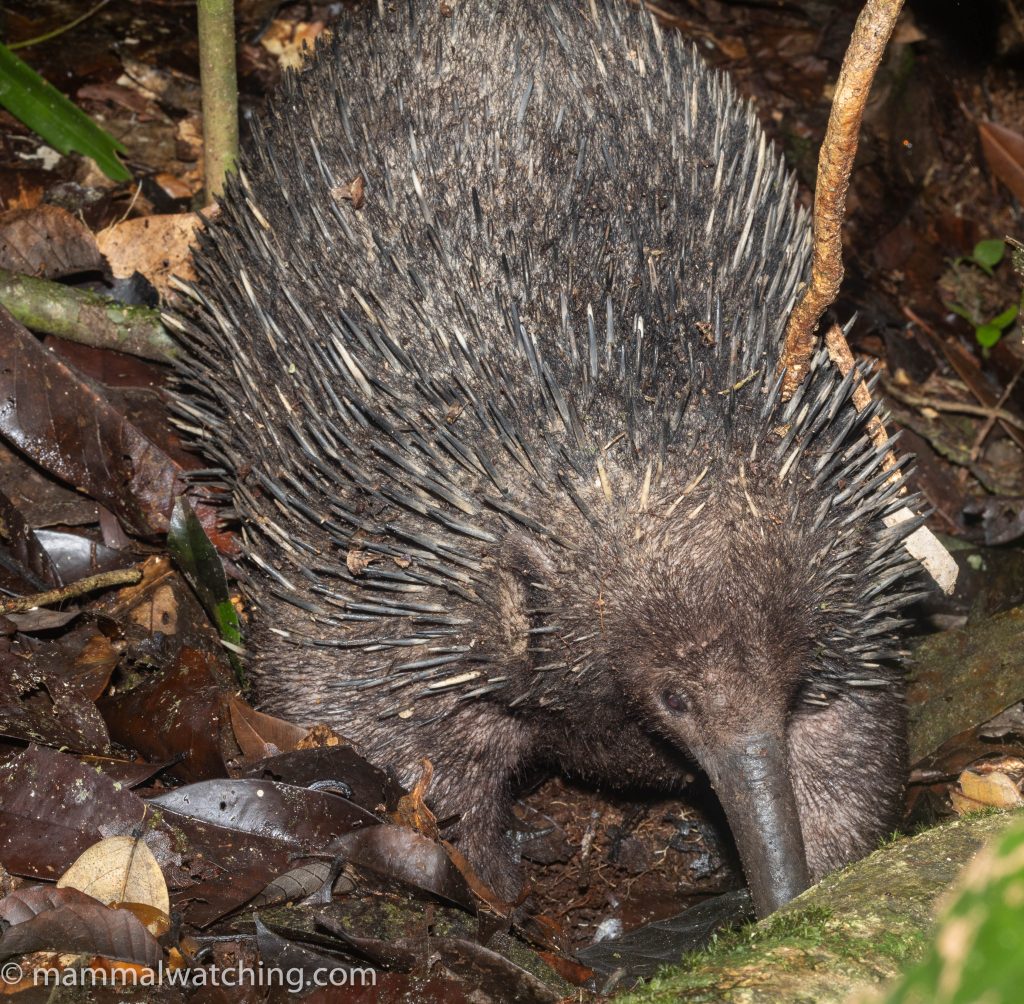
Western Long-beaked Echidna (Zaglossus bruijnii)
Fifteen minutes later we were staring at the weirdest rarest mammal on the planet. From their prehistoric feet to their kiwi styled beak this is one seriously odd beast. And an animal I was sure I would never see.
We were privileged to experience a close encounter for the next twenty minutes. It made no effort to escape. Echidnas don’t seem to do anything in a hurry. This guy stuck its head into the soil a few times in the hope we might all go away, and when that didn’t work he stuck his beak into – well up – Charles, in the hope they might never be parted. It bumbled around a few rocks and we eventually left it to wander away along the edge of the small creek where it had been discovered. A huge mammalwatching highlight for me and for everyone. It was a lifer even for Carlos, delivered just 15 minutes before his birthday.
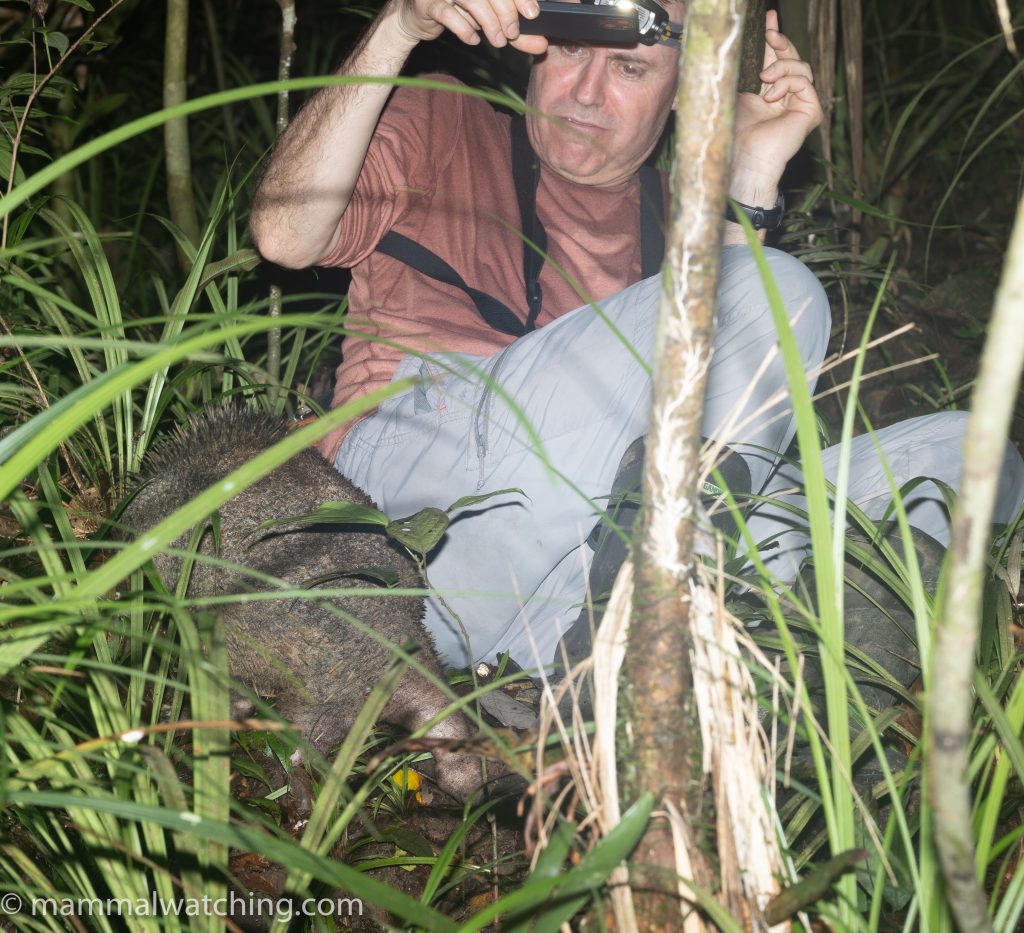
Charles discovers the Echidna must have been off sick the day HR ran the sexual harassment course
The next morning we tried to visit a bat cave. We were too busy basking in post-Echidna happiness to set out early and so it was almost noon before we got organised. After a 45 minute hike we realised that the cave might still be an hour away and we needed to return to the village if we were to leave for Malagufuk on time. Hopefully the next visitors will find out what bats live inside.
The Mammals
Western Long-beaked Echidna (Zaglossus bruijnii)
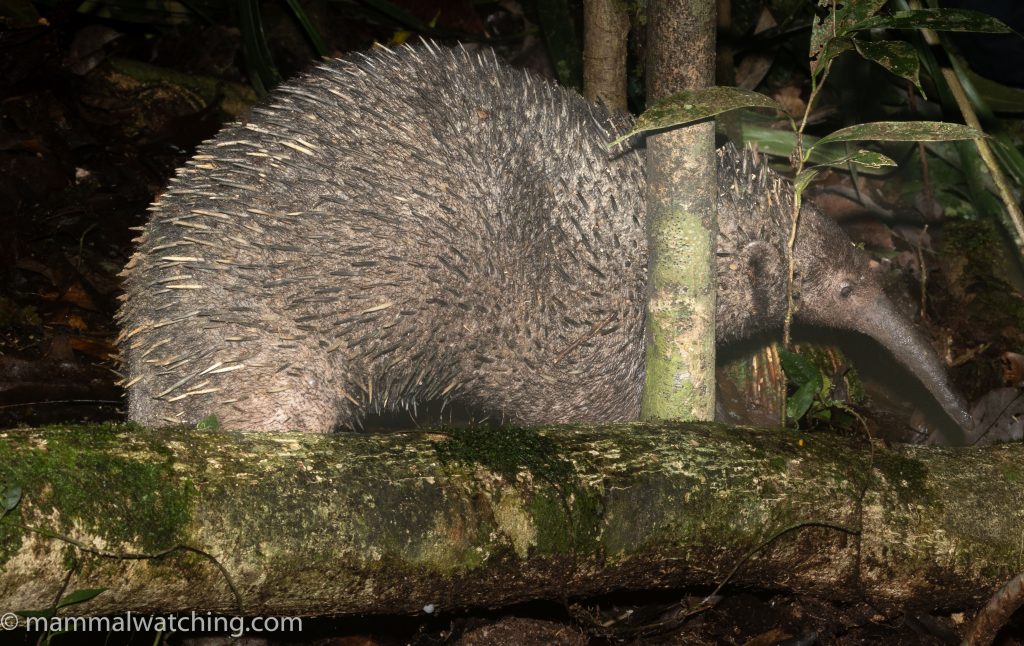
Western Long-beaked Echidna (Zaglossus bruijnii)
An unforgettable encounter with this spectacularly weird mammal just before midnight. The local community found it on the rocky bank of a small creek. We spent 20 minutes with the animal which snuffled among – and into us – before we left it to wander away. The mammal of the trip for most of us.There is a short video here and another here.
Black-tailed Dasyure (Murexia melanurus)
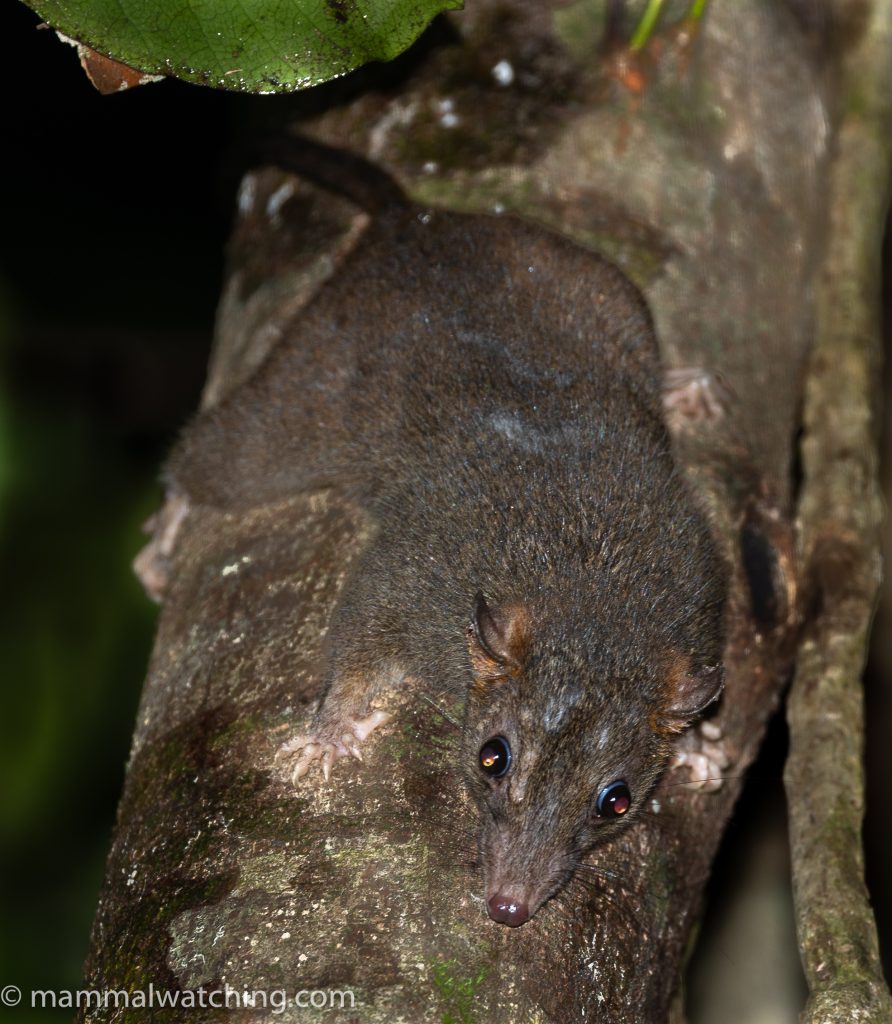
Black-tailed Dasyure (Murexia melanurus)
Wonderful views of this great dasyurid a half an hour after we started our night walk.
Long-fingered Triok (Dactylopsila palpator)
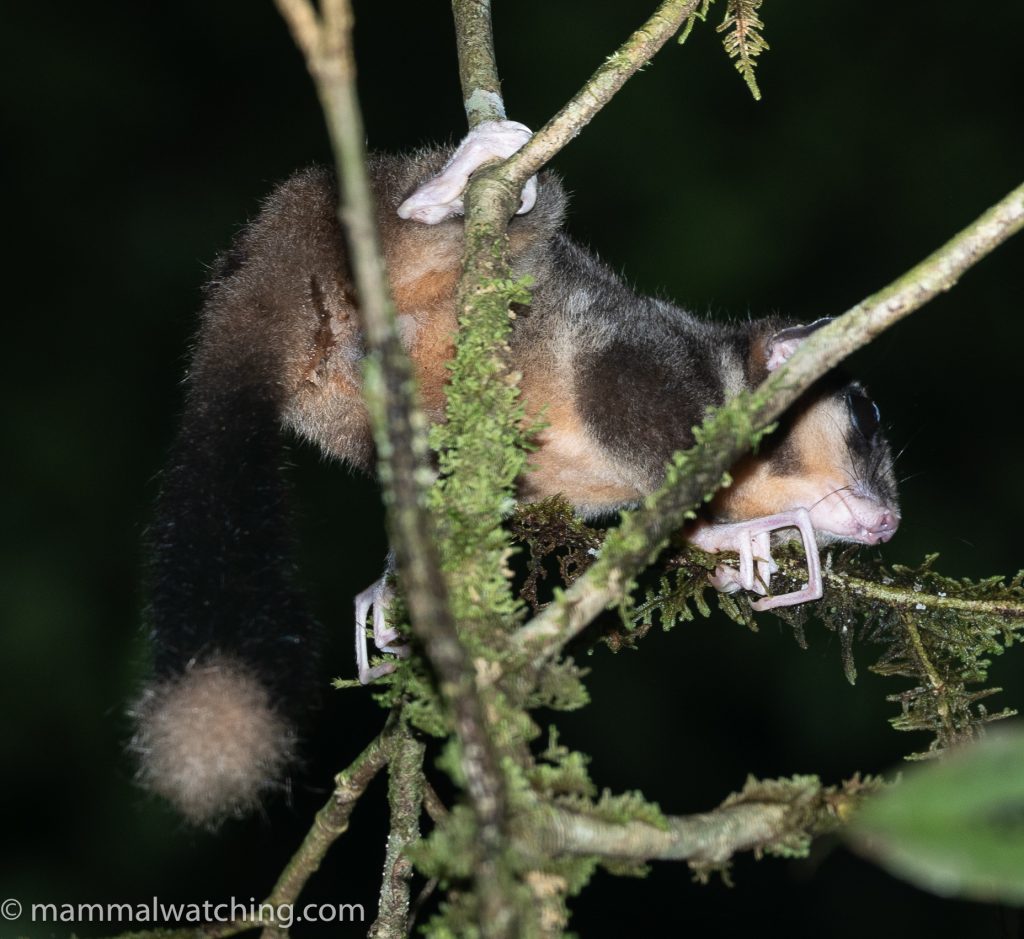
Long-fingered Triok (Dactylopsila palpator)
This fabulous beast was caught by hand by one of the local community at about 11pm. We’d had many debates in Gunung Mupi about whether the Striped Possums we were seeing there might be Trioks. But the long fingers of this species are unmistakable. A surprise to see one here at sea level as the literature we have seen claims they are only found above 1000m.
Bruijn’s Pogonomelomys (Pogonomelomys bruijnii)
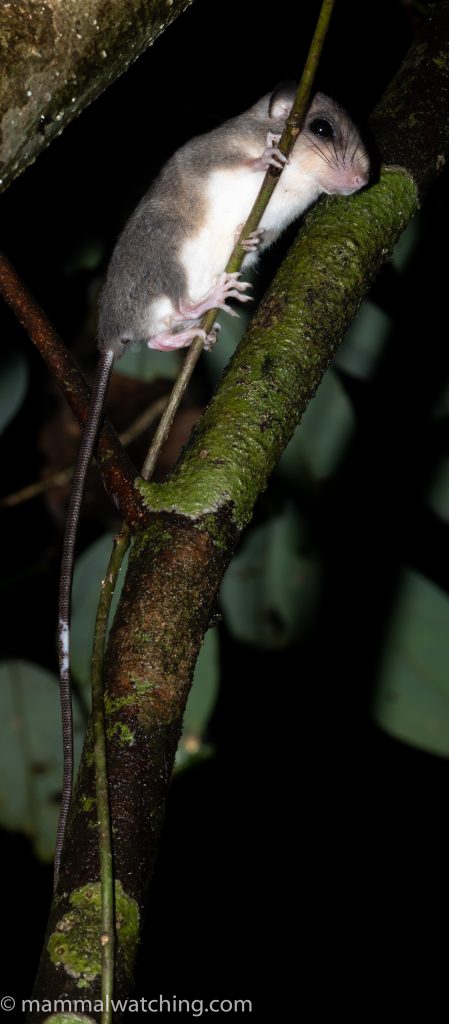
Bruijn’s Pogonomelomys (Pogonomelomys bruijnii)
Several seen during our night walk. Most posed very well for photographs. Identified to species level by overall colour.
Large Spiny Rat (Rattus praetor)
We saw a large rat on the forest floor late into the evening. It posed well for a couple of seconds, so we had a good view but no photographs. Its overall appearance was of a large rattus with spiny fur. We tentatively identified it as this species as nothing else seemed to match in range (though as we were discovering range maps are not always helpful in Papua!). However, the ‘rattus praetor’ we saw and photographed in Malagufuk looked rather different. So, one of these two records (or possibly both) may be incorrectly identified.
Lesser Sheath-tailed Bat (Mosia nigrescens)
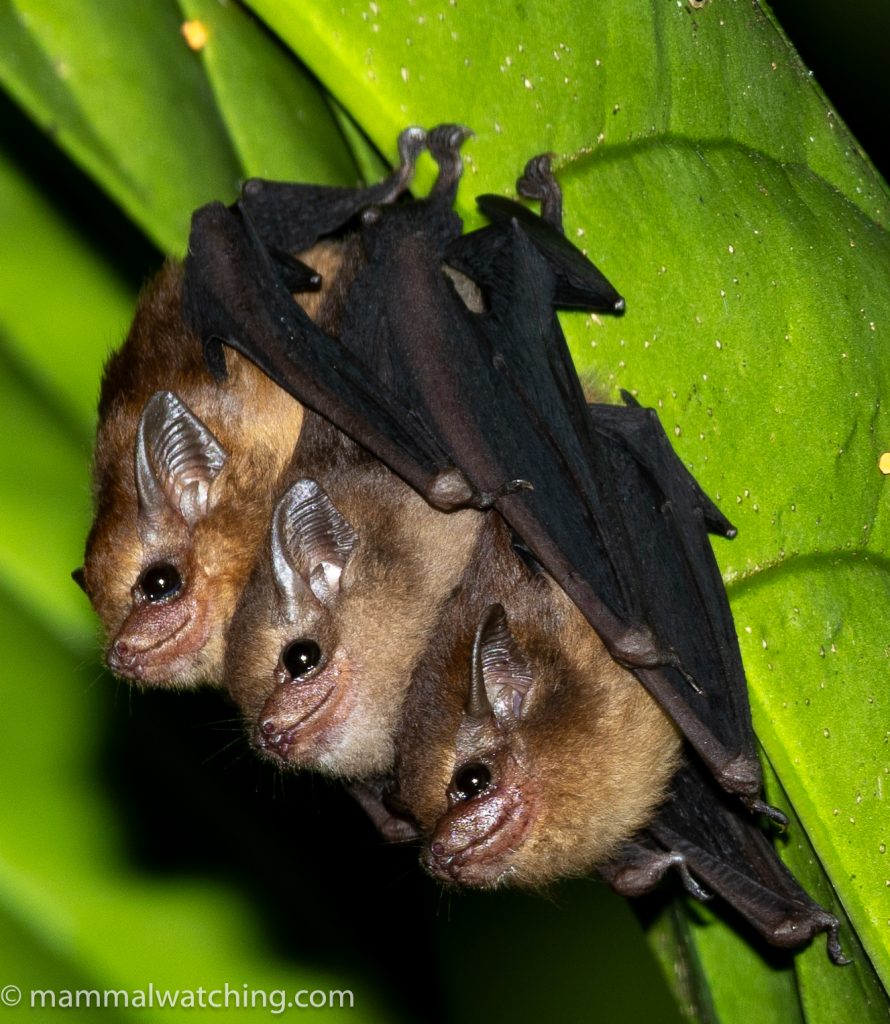
Lesser Sheath-tailed Bat (Mosia nigrescens)
We found two or three clusters of these bats in their characteristic ‘let’s line up on a leaf and look adorable’ pose.
Maluku Myotis (Myotis moluccarum cf. adversus)
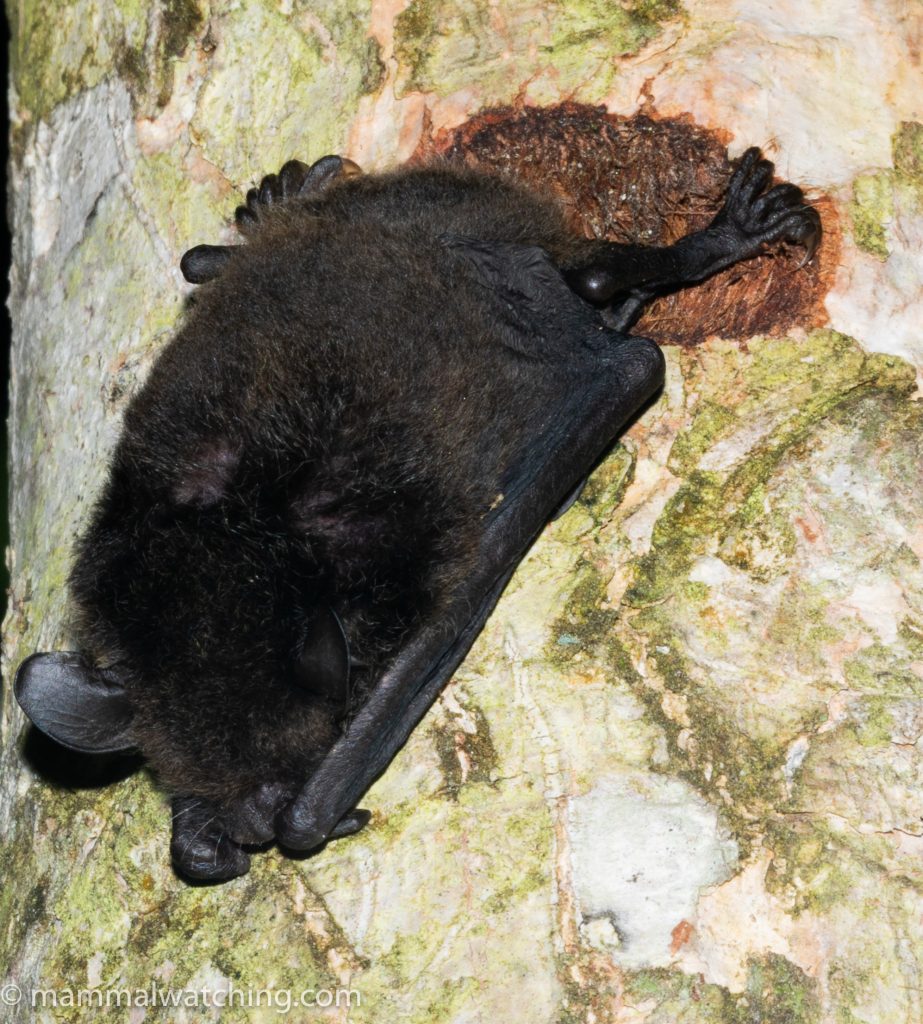
Maluku Myotis (Myotis moluccarum cf. adversus)
One flying around our hut in the village. There was some debate as to whether this was Myotis adversus or M. moluccarum. The latter seems more likely with added evidence pointing to that species from Nils’s analysis of the echolocation calls. In any event these species are a complex that needs revision.
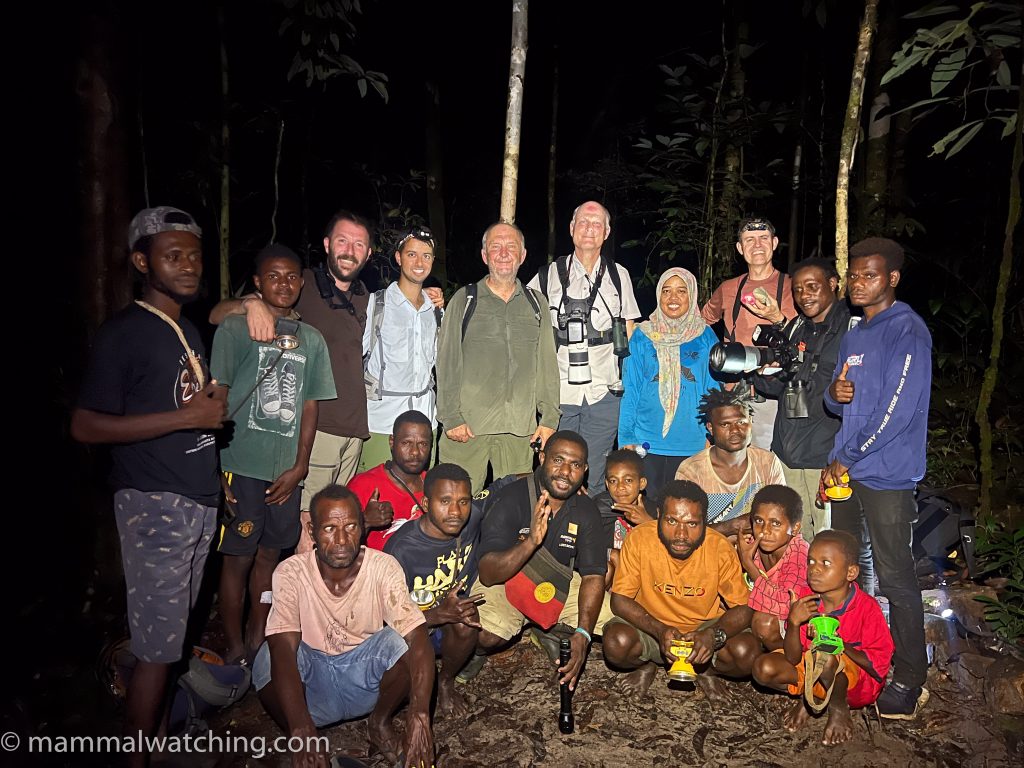
Post-echidna party
Malagufuk
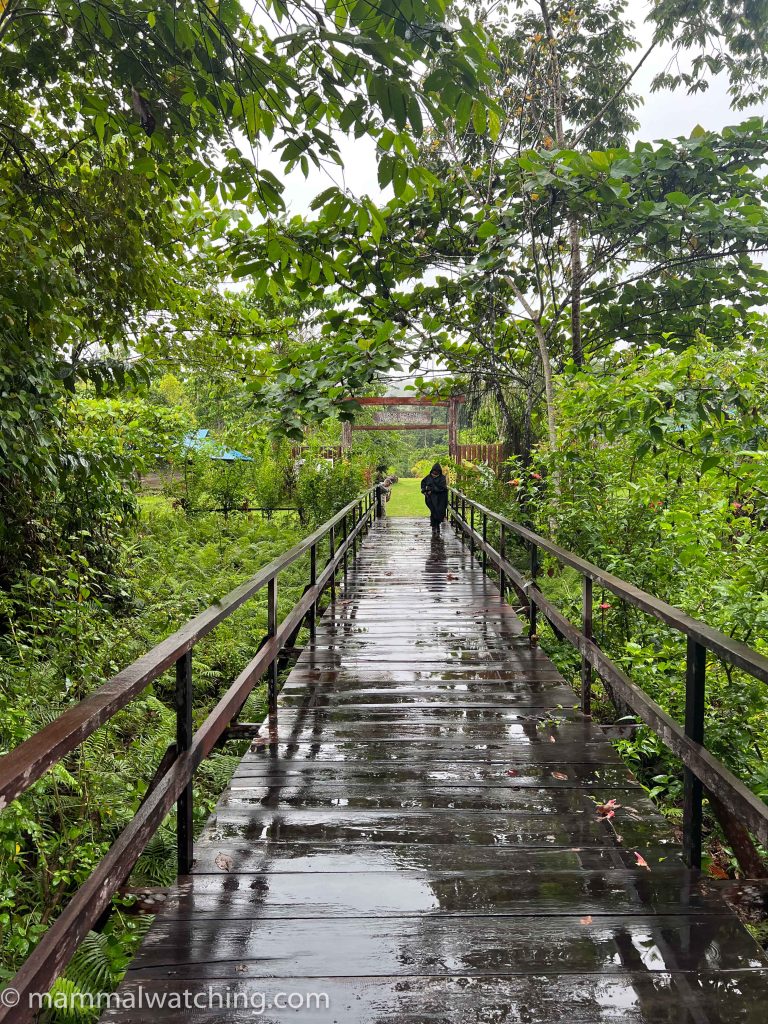
The Malagufuk Ice Rink
Malagufuk is a well-known ‘eco village’ only an hour and a half from Manokwari. The community have built a 3km boardwalk to connect the village to the road. This is fabulous for night walks on the rare occasions it is dry. After any rain it turns into a skating rink. If West Papua ever forms an Olympic Bob Sled team they have somewhere to practice.
Absalom also set up our trip here with the community, proving again how valuable he was to opening a path for mammalwatchers. He also arranged our supplies.
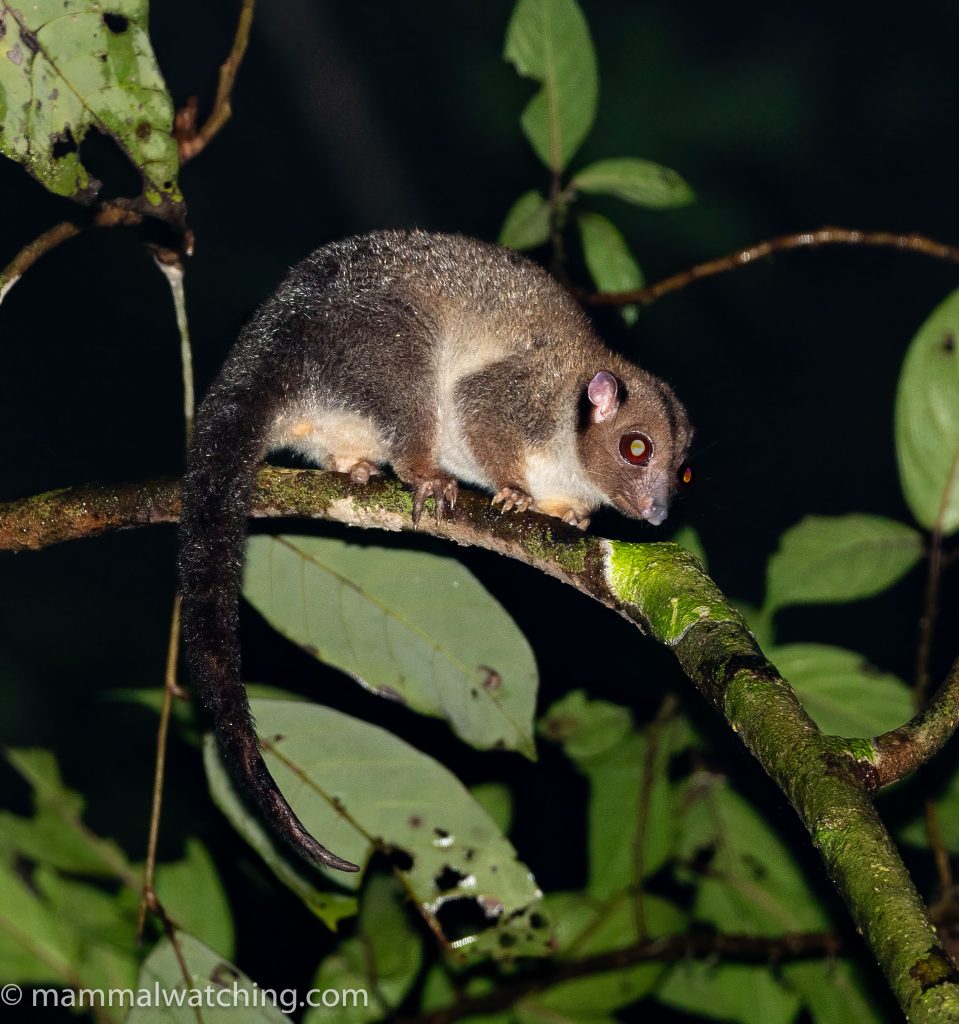
Lowland Ringtail (Pseudochirulus canescens)
The village itself is all well manicured grass and wooden houses. Our accommodation was similar – but more sweaty – to our Mupi shack. Washing facilities were limited to a stretch of river 30 minutes back along the boardwalk.
But who cares because once again the local community here could not have been more helpful. That said I am not sure we were on the same page when it came to fine dining. In particular we agreed to disagree on the idea that you can serve a meal that is not comprised of rice, noodles and vast quantities of aubergine. We ran out of coffee on day three and the only bread had gone moldy by this point. Though that problem was short-lived after a dog got into our cabin and ate what was left. After day three we put in a request for emergency supplies from town and I lived off pot noodle and beer for the rest of the stay.
We looked for mammals at night along the boardwalk, and two good trails that led in different directions from the village. One – the ‘concrete trail’ starts as a solid concrete walkway for 20 minutes before climbing a steep hill. The other – ‘the jungle trail’ begins with a small creek crossing and leads through the forest and past some bat caves.
The village itself is bandicoot central with abundant Common and Long-nosed Echymipera. Flying foxes were also common overhead at dusk as they flapped overhead to search for food in the forest.
The Mammals
All mammals seen at night unless otherwise noted.
Müller’s Three-striped Dasyure (Myoictis melas)
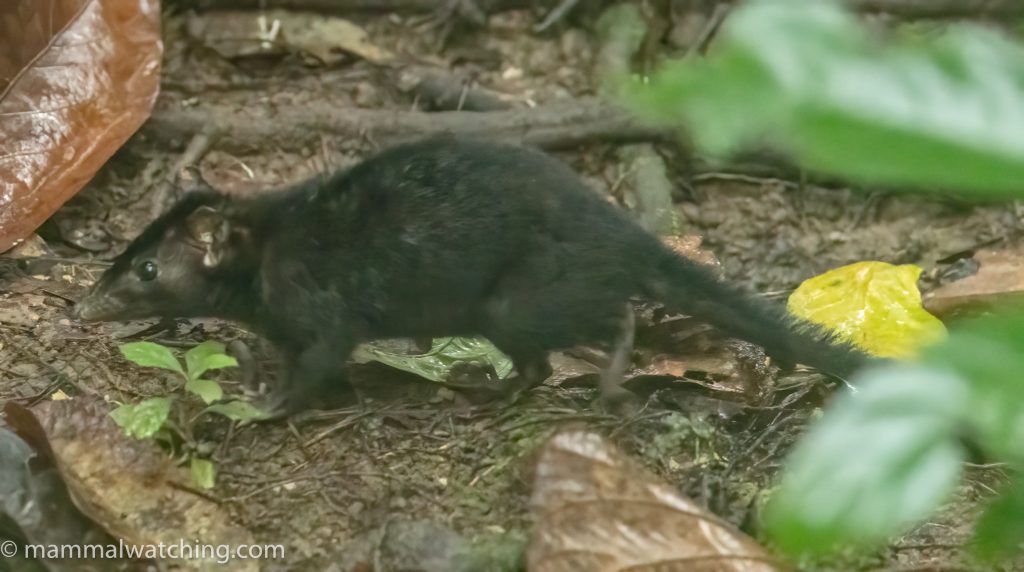
Müller’s Three-striped Dasyure (Myoictis melas)
One seen well, but in poor light, on the forest floor from the boardwalk in the early morning. Initially discovered with a thermal scope.
Black-tailed Dasyure (Murexia melanurus)
We saw one but I didn’t photograph it. This species was photographed well at the Long-beaked Echidna site.
Common Echymipera (Echymipera kalubu)
Both species of Echymipera were abundant around Malagufuk village. We photographed this species at Gunung Mupi so focussed on getting photos of Long-nosed Echymipera.
Long-nosed Echymipera (Echymipera rufescens)
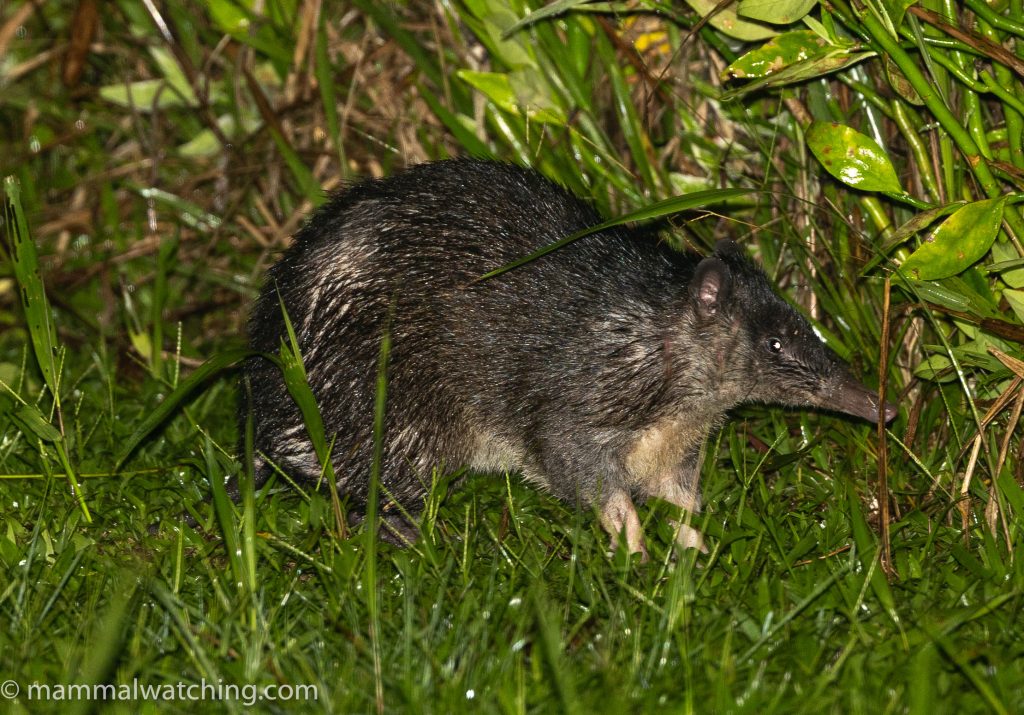
Long-nosed Echymipera (Echymipera rufescens)
It was difficult to walk more than five minutes around the village without spotting an echymipera. Many were skittish but this one posed well for photos.
Northern Common Cuscus (Phalanger orientalis)
Cuscus were surprisingly scarce at Malagufuk and we saw just one animal. This species was photographed well at Gunung Mupi.
Lowland Ringtail (Pseudochirulus canescens)
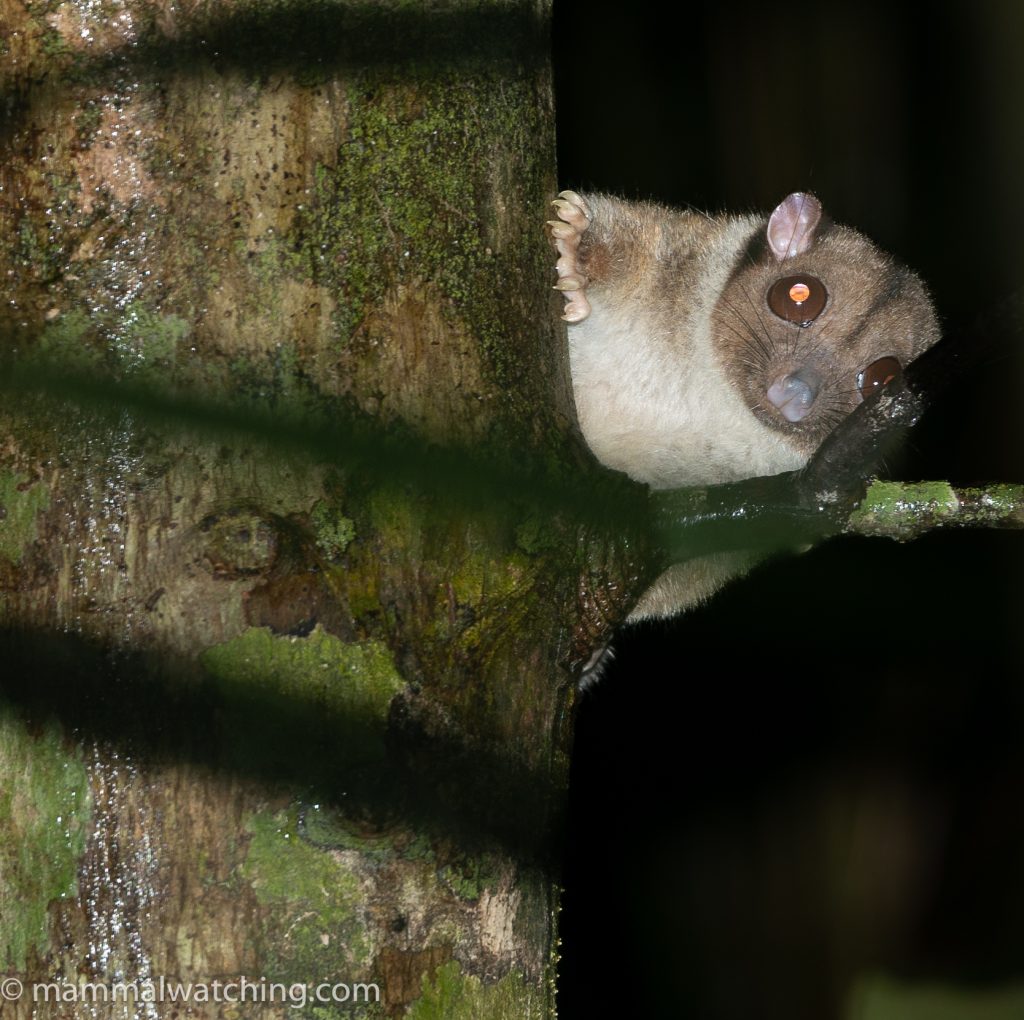
Lowland Ringtail (Pseudochirulus canescens)
We saw Lowland Ringtails every night at Malagufuk.
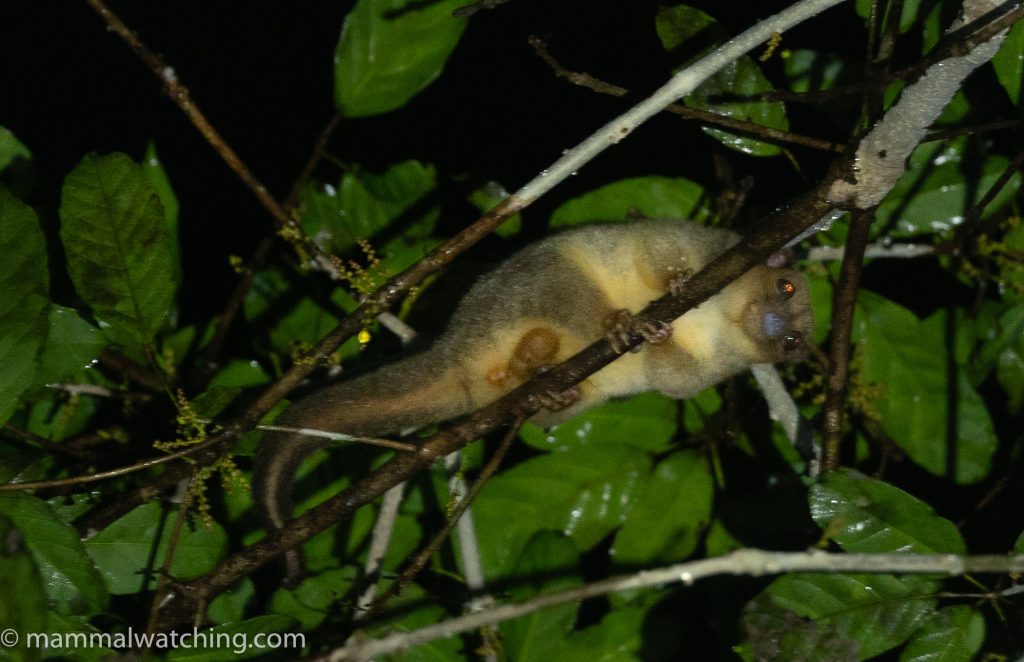
Lowland Ringtail (Pseudochirulus canescens)
Striped Possum (Dactylopsila trivirgata)
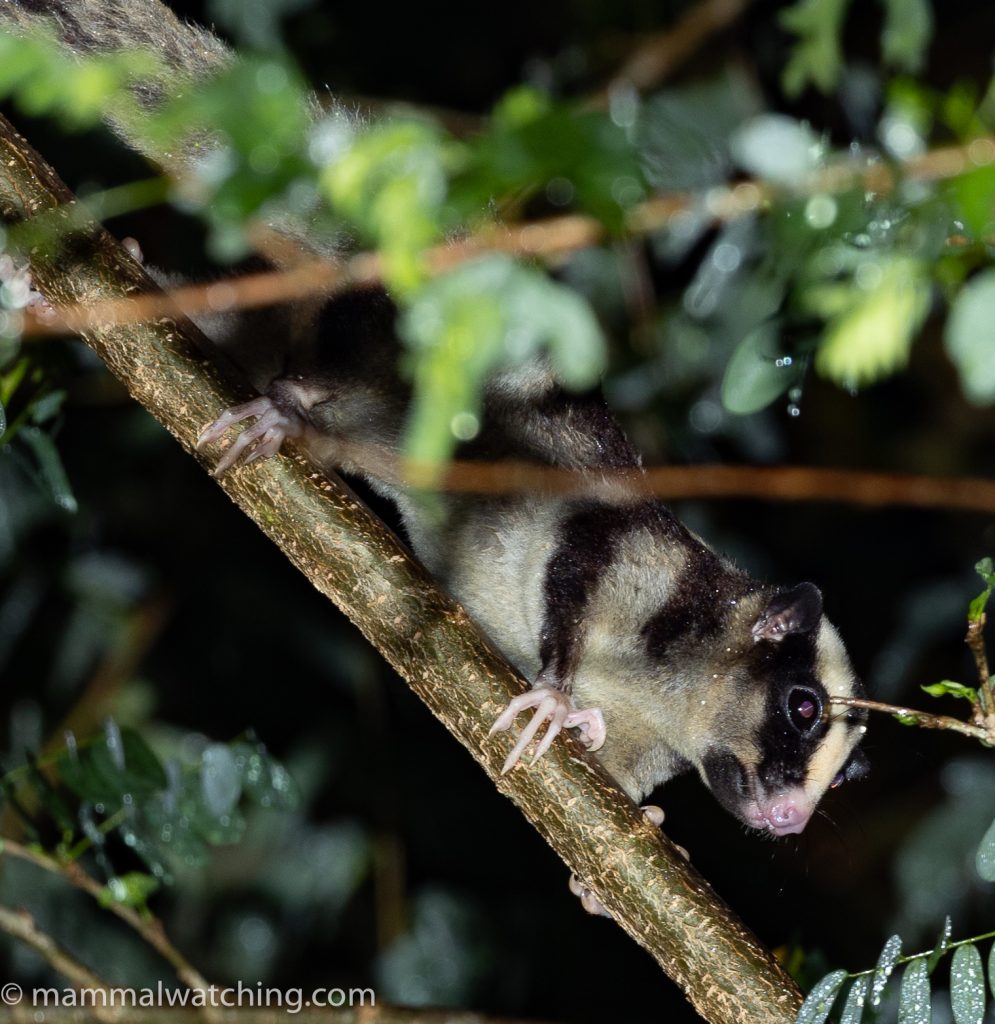
Striped Possum (Dactylopsila trivirgata)
We saw Striped Possums on three of our five nights.
Papuan Glider (Petaurus papuanus)
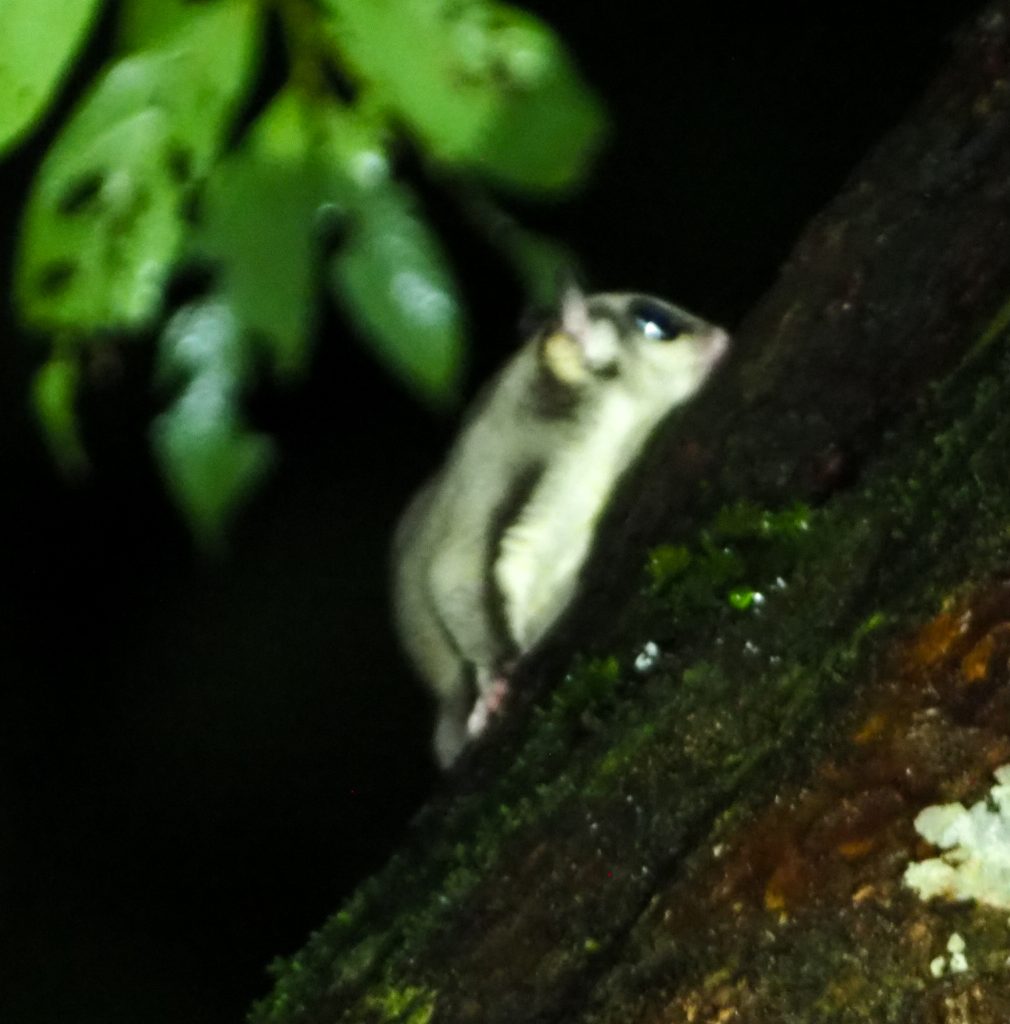
Papuan Glider (Petaurus papuanus). Photo by Venkat Sankar.
One along one of the forest trails. Hard to photograph in the rain.
Brown Dorcopsis (Dorcopsis muelleri)
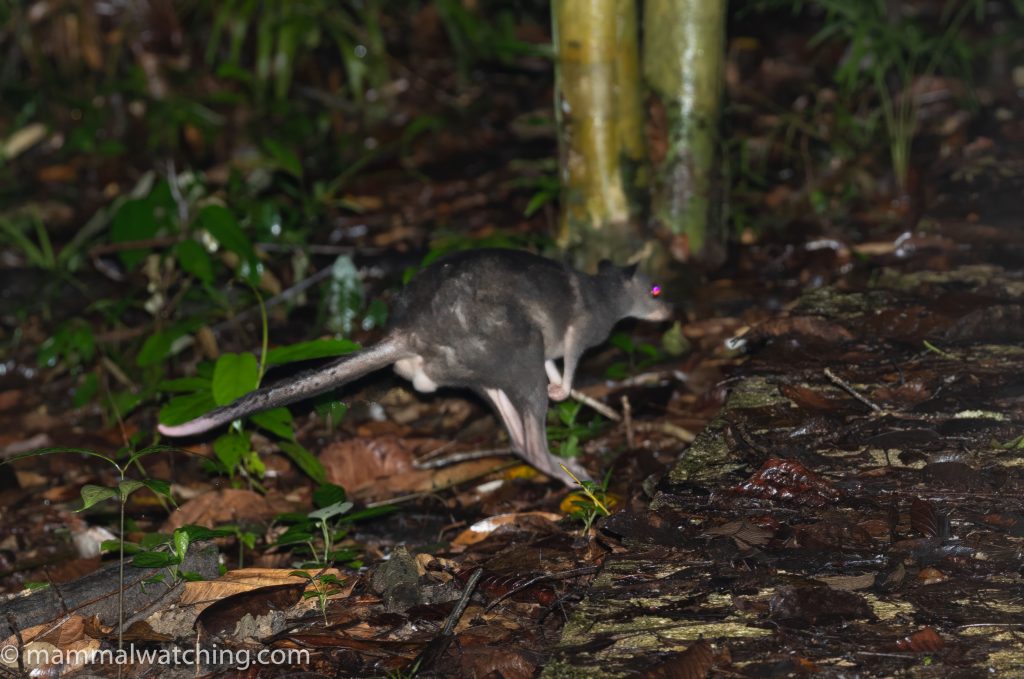
Brown Dorcopsis (Dorcopsis muelleri)
These wallabies were fairly common in Malagufuk and we saw them on several nights and in the early morning, both from the boardwalk and along the trails. Often more grey than brown and always hard to photograph.
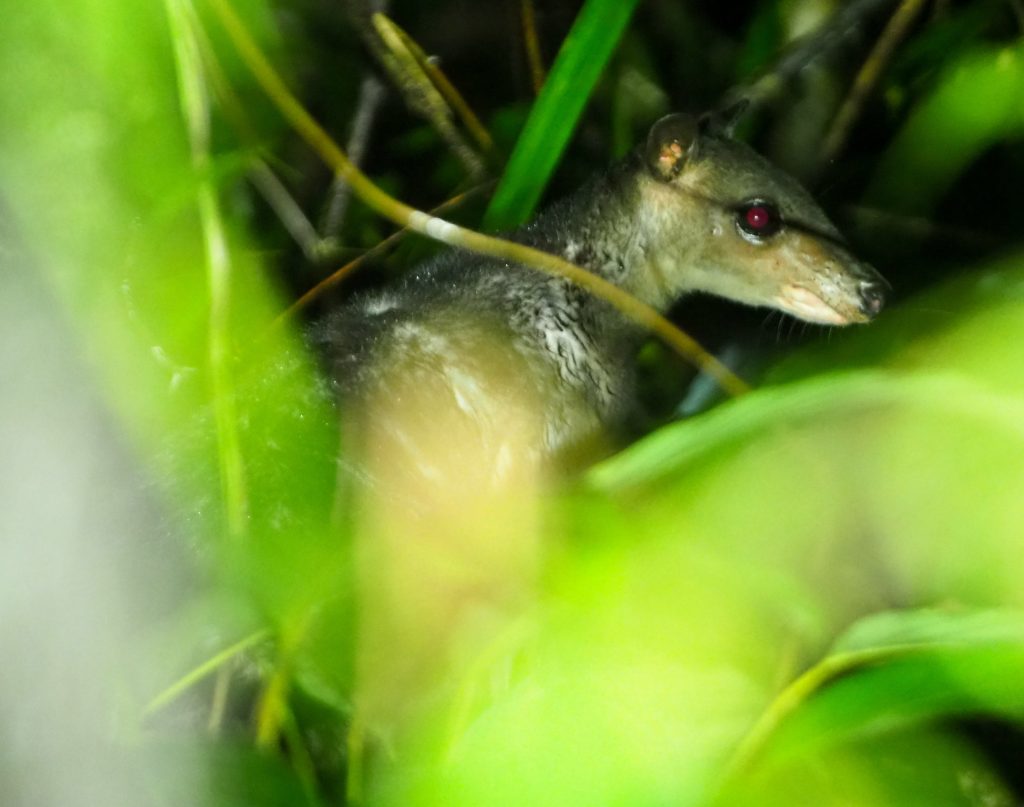
Brown Dorcopsis (Dorcopsis muelleri). Photo by Venkat Sankar.
Common Water Rat (Hydromys chrysogaster)
One seen well but briefly in the creek at the start of a forest trail. Not photographed.
Long-footed Tree Mouse (Lorentzimys cf. nouhuysii)
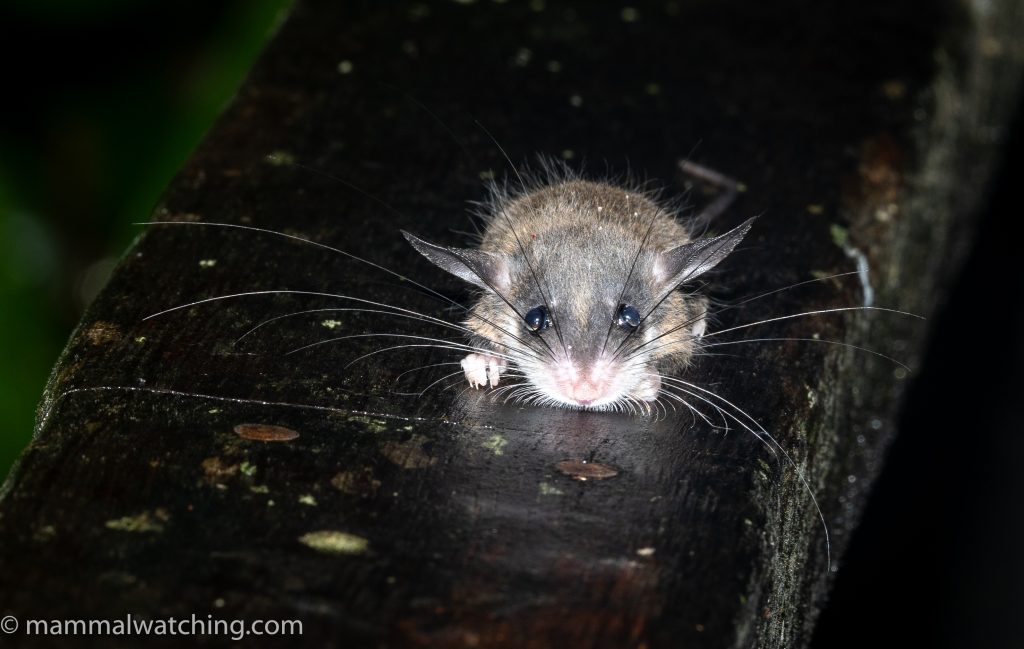
Long-footed Tree Mouse aka New Guinea Jumping Mouse (Lorentzimys nouhuysii)
One of the highlights of Malagufuk. Carlos had mentioned seeing a strange bouncing mouse on a previous trip and wondering whether it might have been a New Guinea Jumping Mouse, a species not apparently recorded from anywhere near the Volgekop Peninsula. On our second night we saw an animal back and forth along the handrail of the boardwalk with a strange – almost reptilian – gait, its legs bent outwards and belly low. We caught it by hand and Venkat quickly identified it as a lorentzimys, with the measurements fittingexactly with those in Flannery’s Mammals of New Guinea. Two nights later we saw a pair of rodents on the forest floor, which bounced almost vertically in leaps about 30cm into the air before one of them rapidly climbed a tree. These too were lorentzimys. The genus is very poorly known and may comprise several species, so whatever it was we saw may end up being an undescribed species.
Black-tailed Melomys (Melomys rufescens)
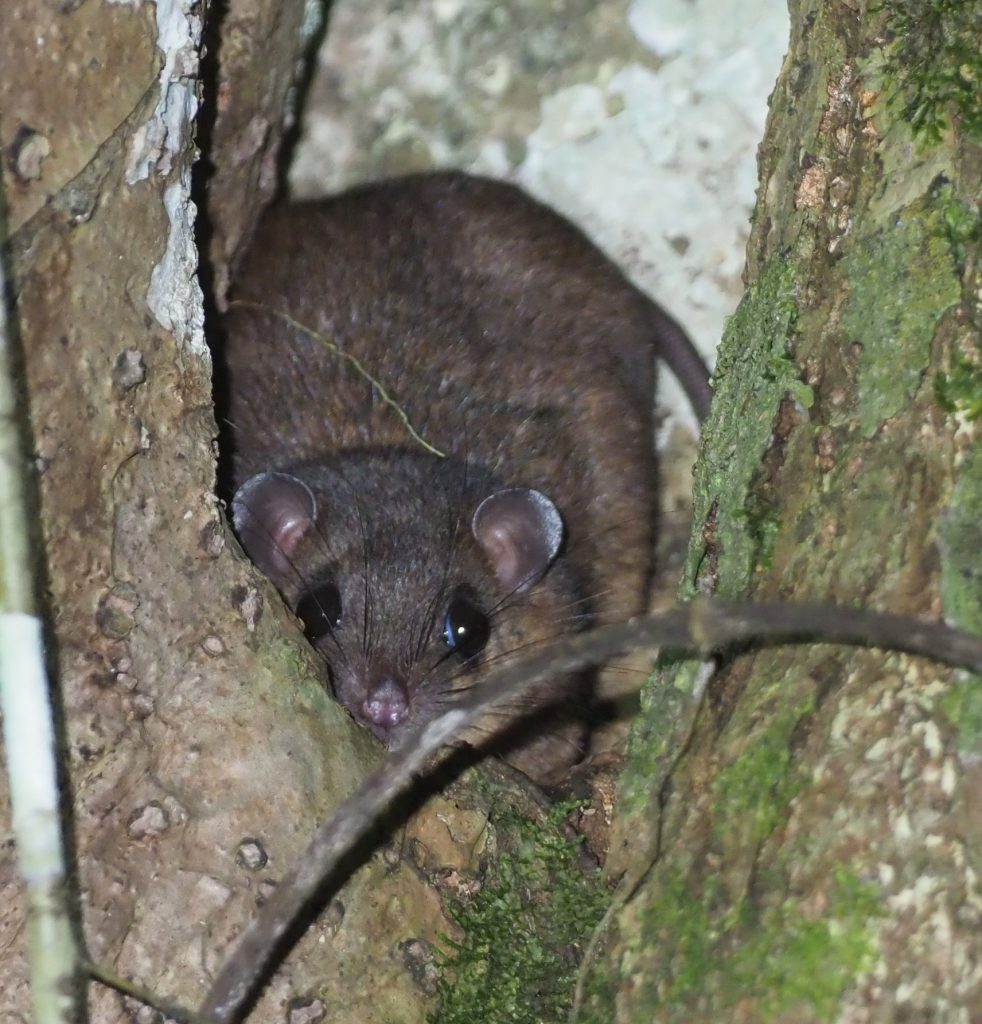
Black-tailed Melomys (Melomys rufescens). Photo Venkat Sankar.
We saw one animal on two nights.
Common Lowland Paramelomys (Paramelomys platyops)
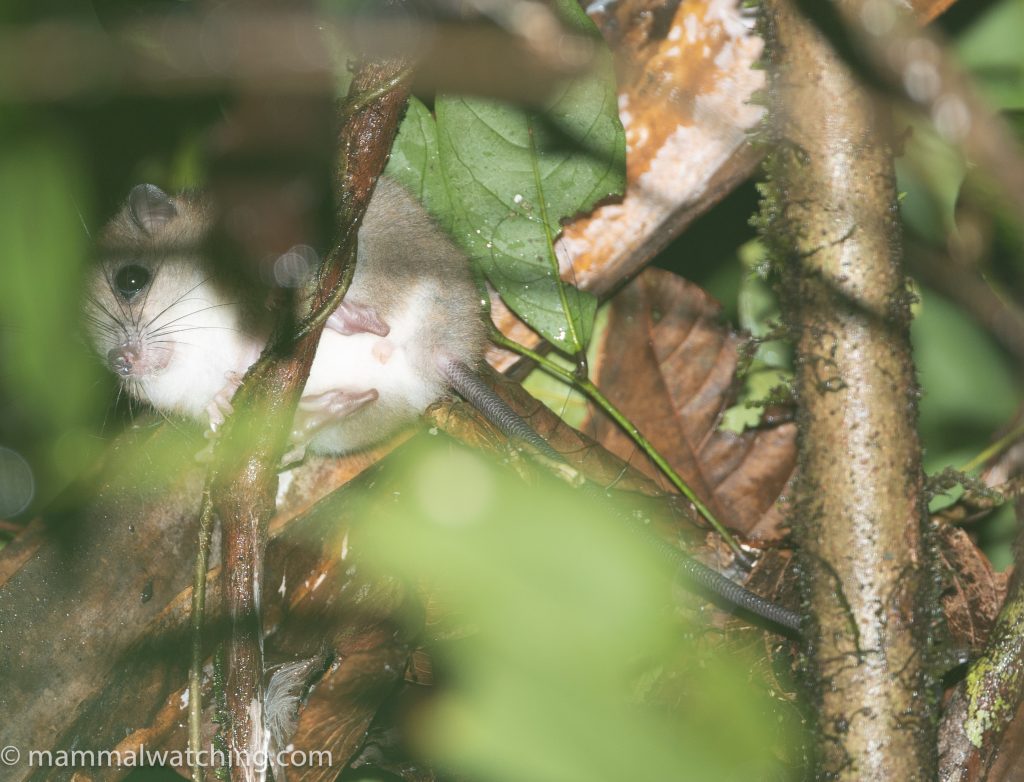
Common Lowland Paramelomys (Paramelomys platyops)
Two animals found with our thermal scopes.
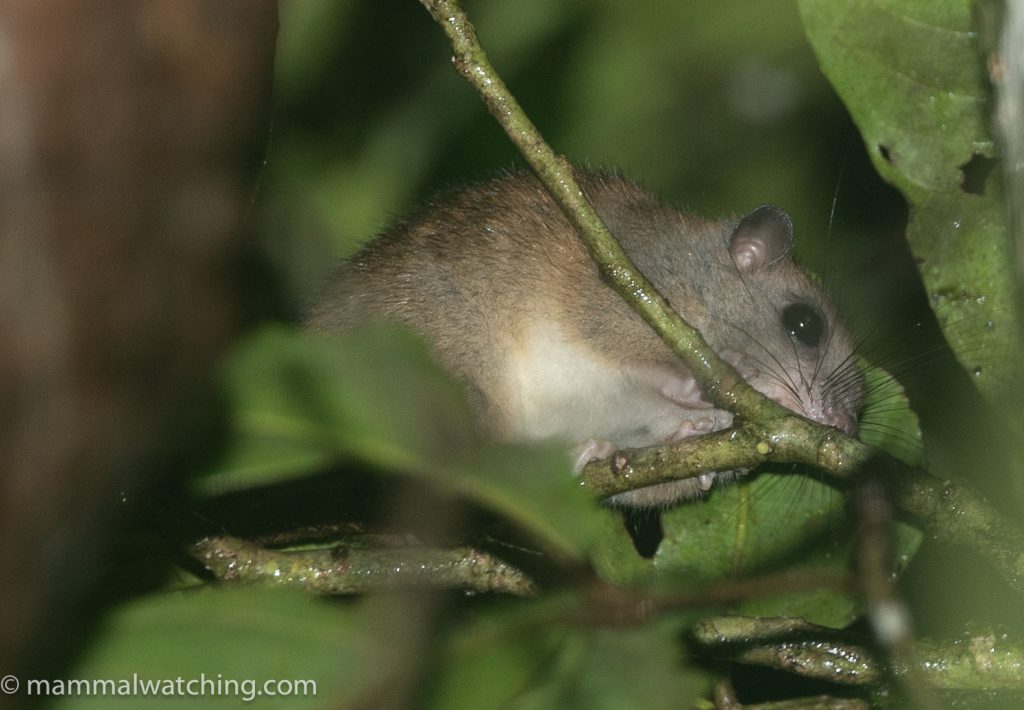
Common Lowland Paramelomys (Paramelomys platyops)
Bruijn’s Pogonomelomys (Pogonomelomys bruijnii)
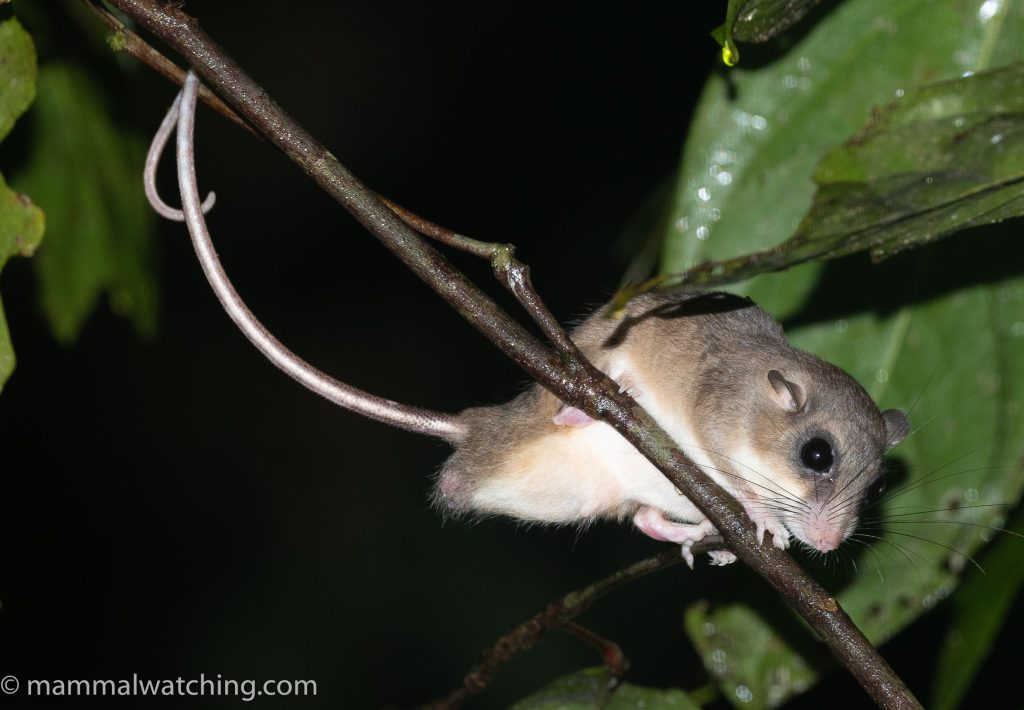
Bruijn’s Pogonomelomys (Pogonomelomys bruijnii)
One animal identified by brownish color and tail pattern.
Loria’s Pogonomys (Pogonomys loriae)
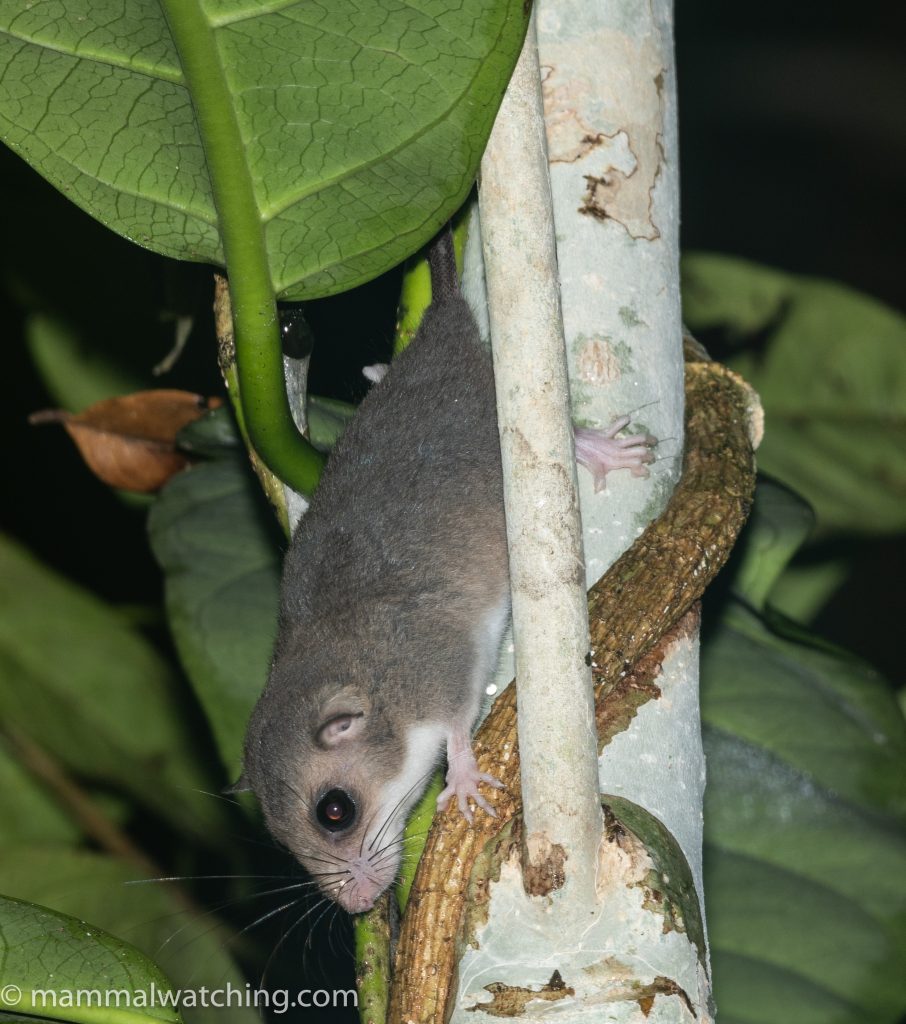
Loria’s Pogonomys (Pogonomys loriae)
Animals seen on two consecutive nights.
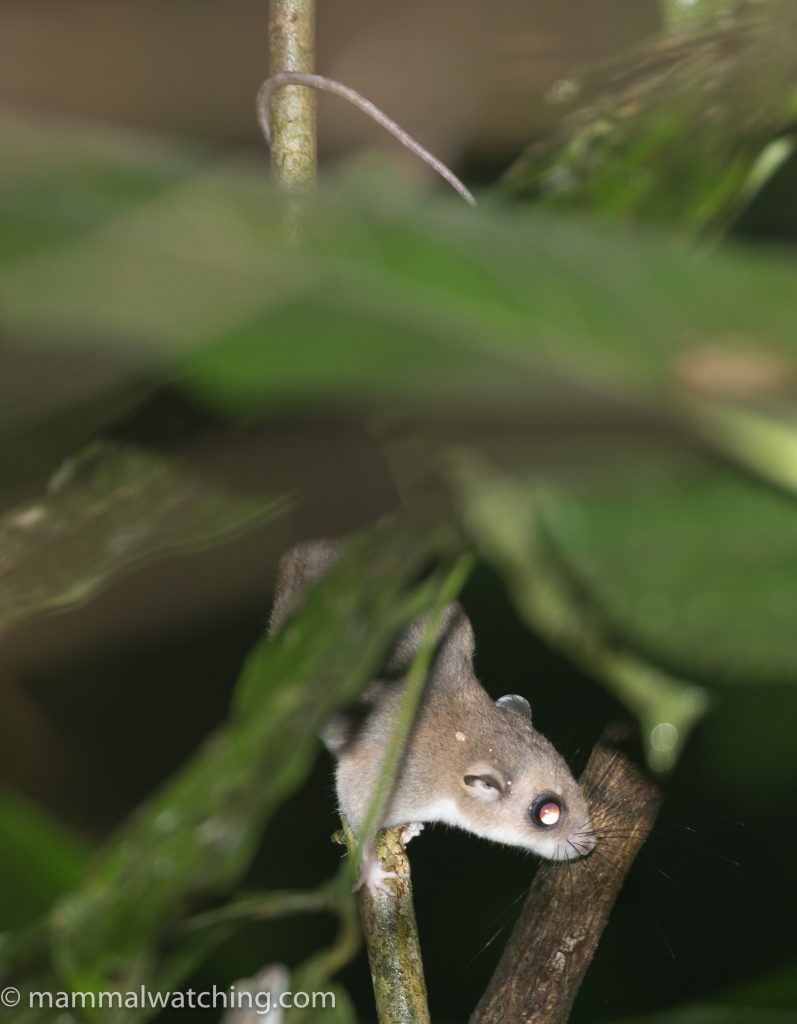
Loria’s Pogonomys (Pogonomys loriae)
White-tailed Giant Rat (Uromys caudimaculatus)
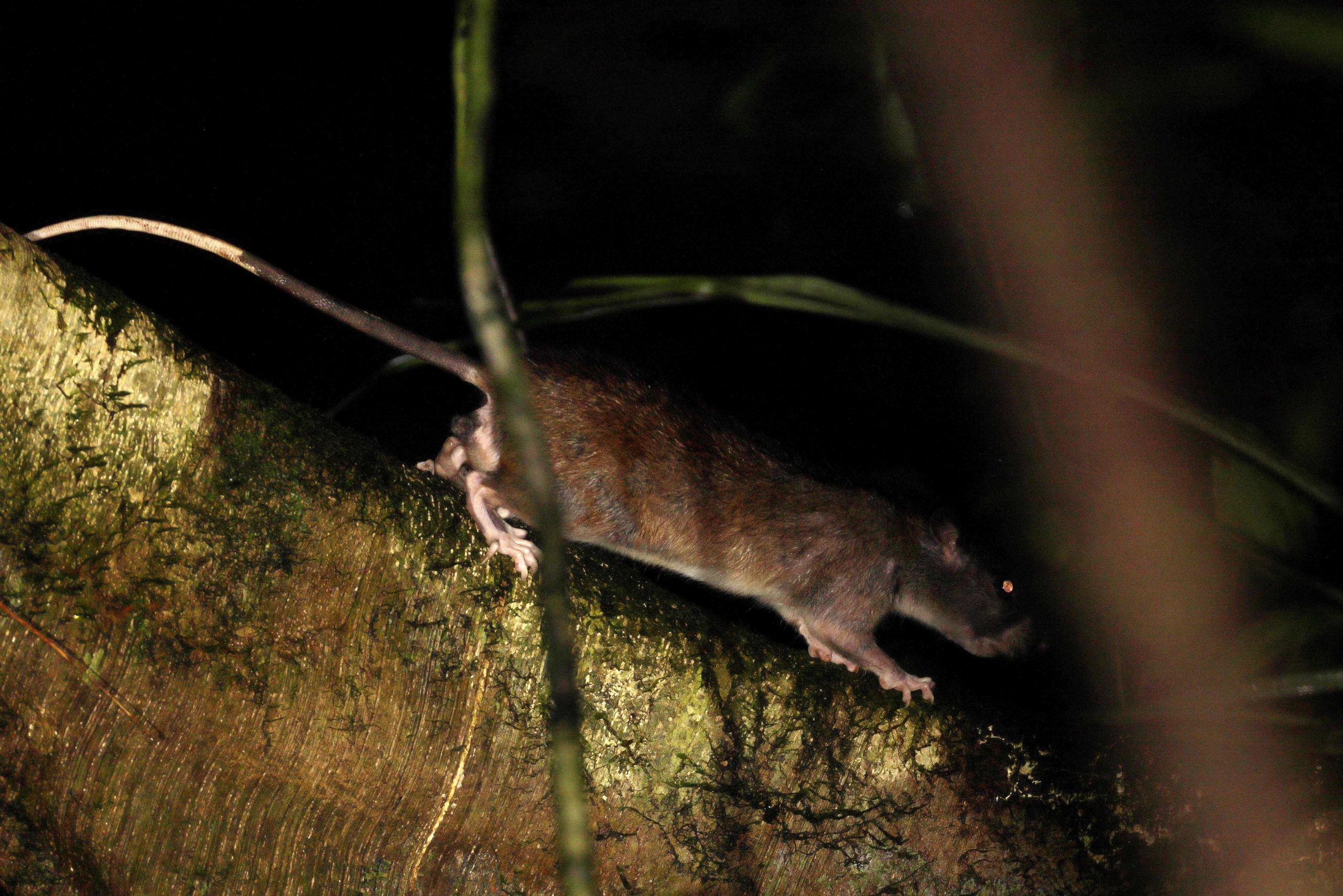
White-tailed Giant Rat (Uromys caudimaculatus). Photo Carlos Bocos.
One animal an hour or so along the ‘jungle trail’ close to the bat caves.
Polynesian Rat (Rattus exulans)
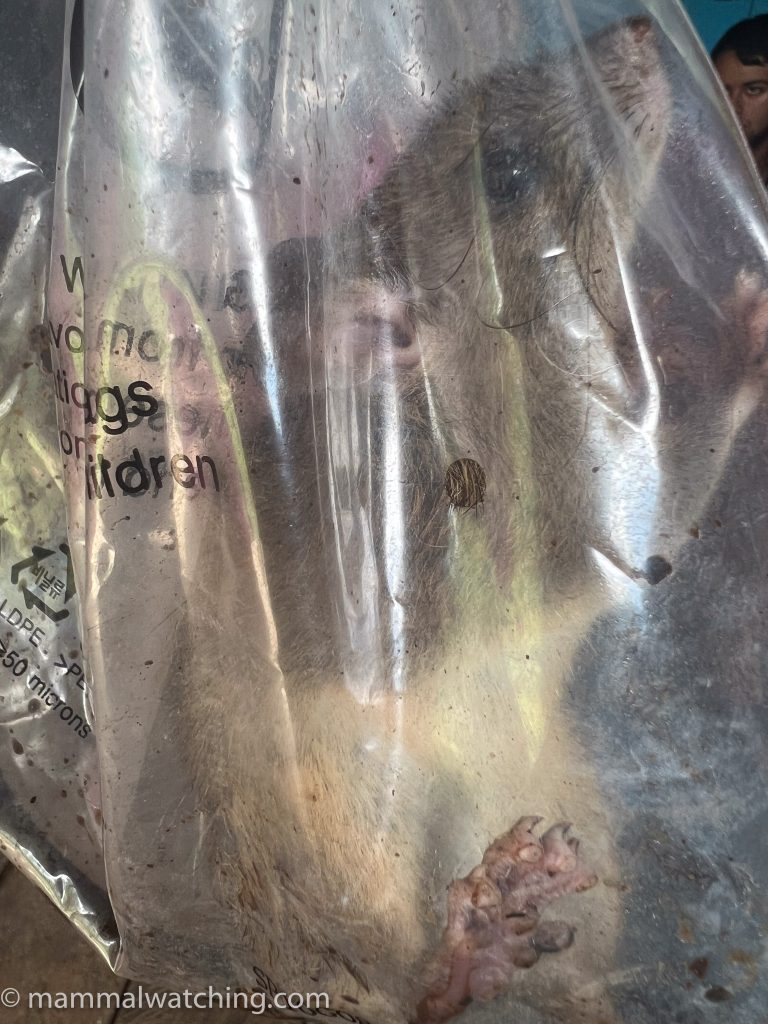
Polynesian Rat (Rattus exulans)
The community caught this rat in one of the gardens. Likely the species we saw several times as we were wandering around the village.
Large Spiny Rat (Rattus praetor) (possible)
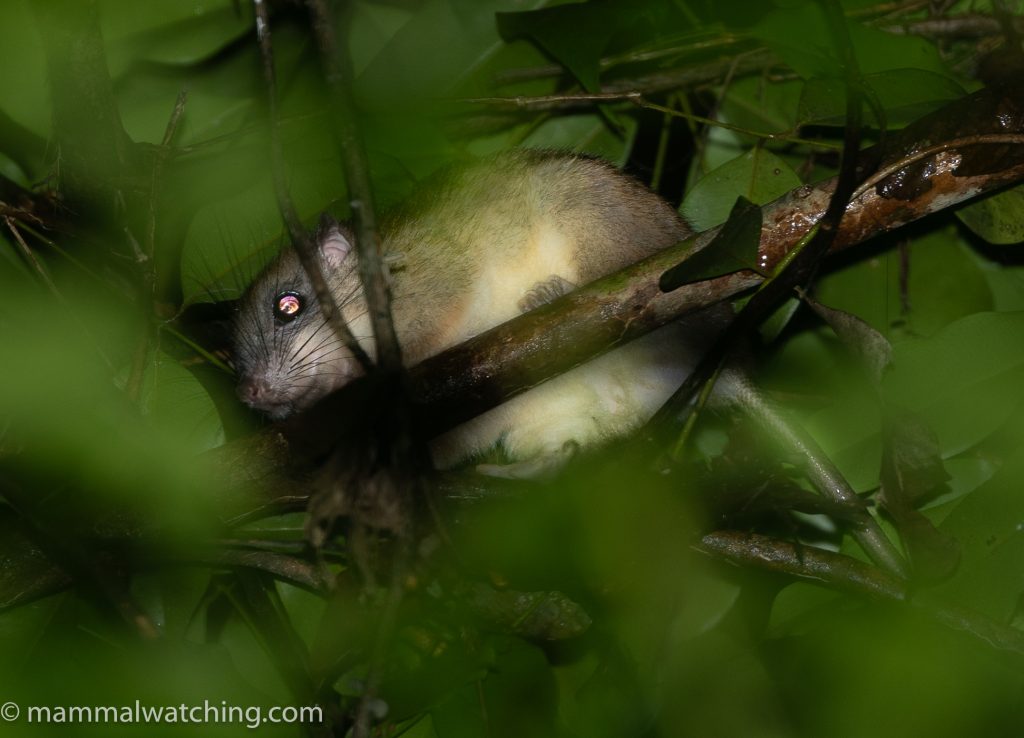
Mystery rat possibly Rattus praetor
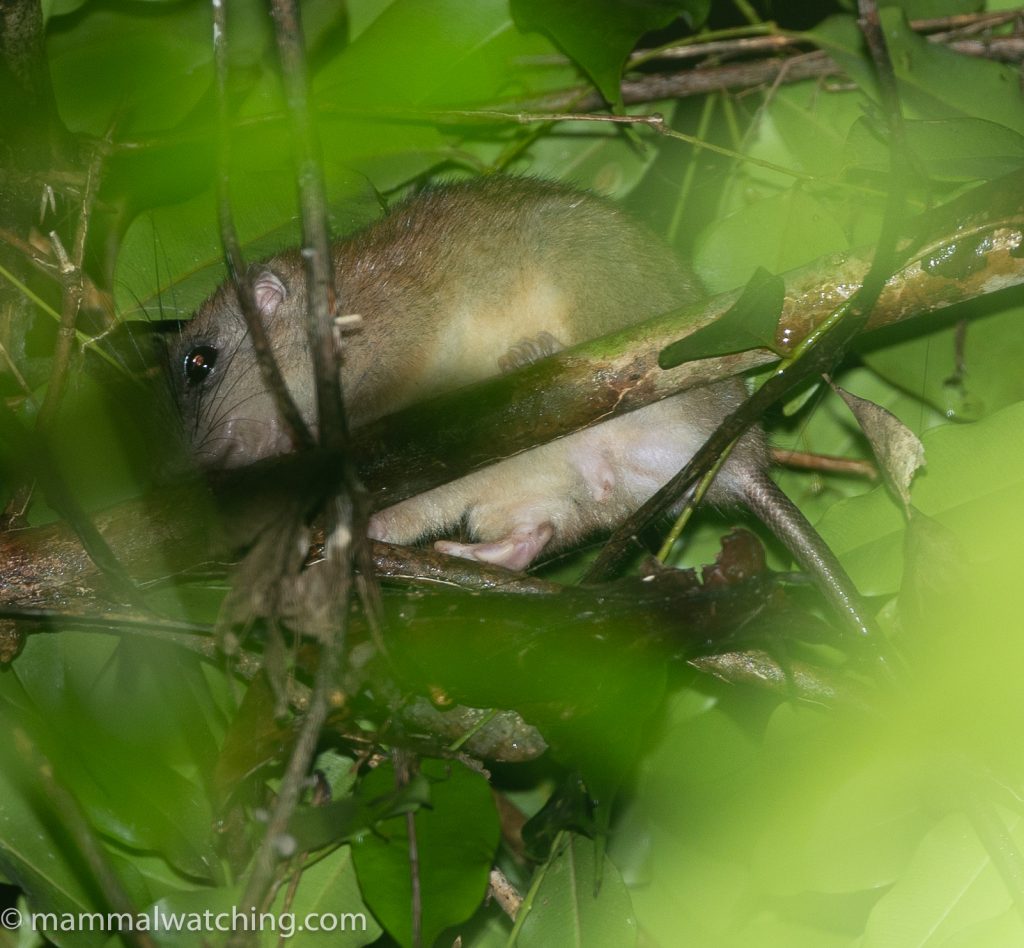
Mystery rat possibly Rattus praetor
We found this large rat in a tree on the top of the hill 15 minutes along the ‘jungle trail’. It did not look very much like the picture of Rattus praetor in Tim Flannery’s book, nor the rat we tentatively identified as this species at the Long-beaked Echidna site. I would love to hear other opinions on its identity.
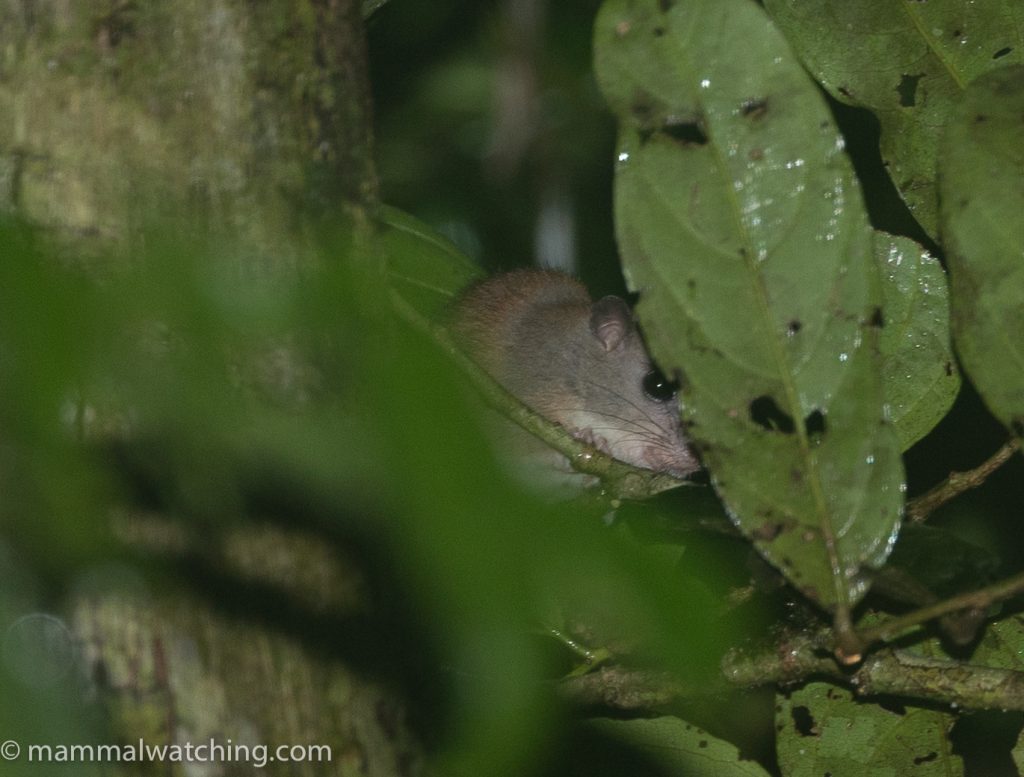
Mystery rat possibly Rattus praetor
Common Blossom Bat (Syconycteris australis)
Two seen well in the forest.
Moluccan Naked-backed Fruit Bat (Dobsonia moluccensis)
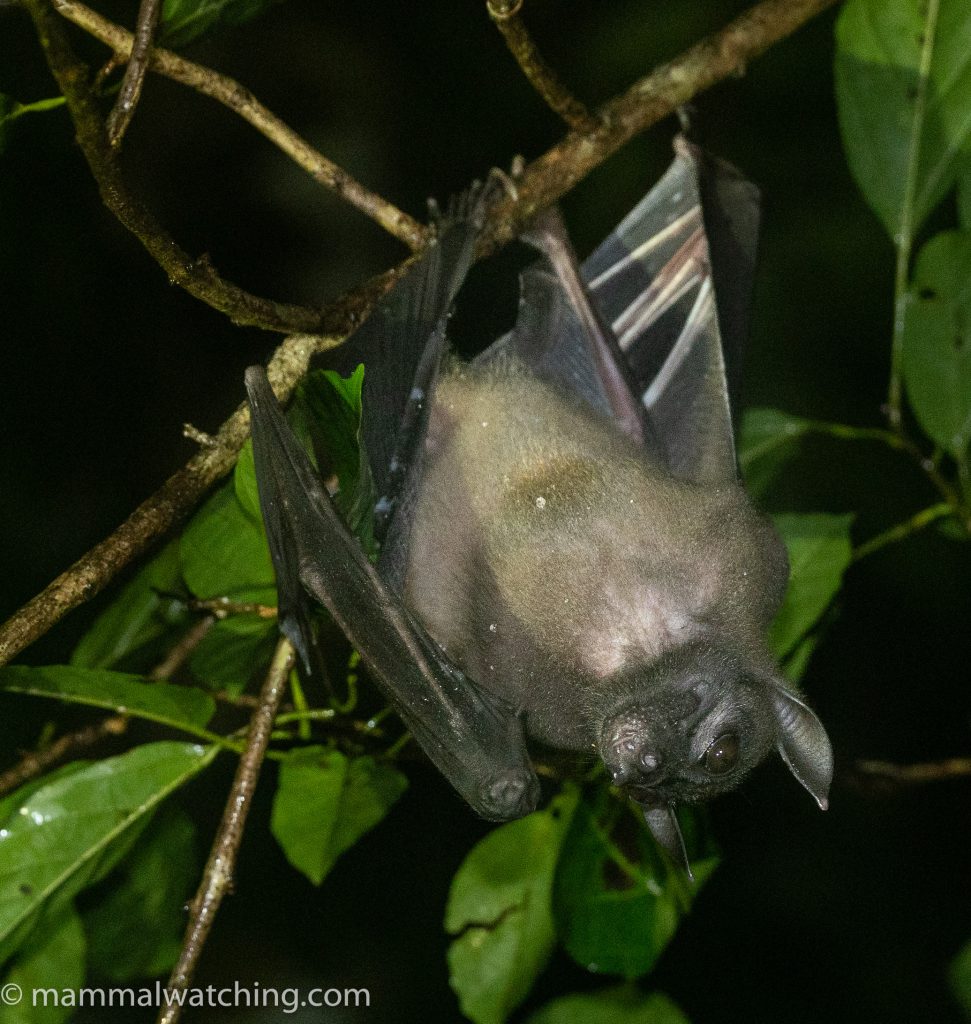
Moluccan Naked-backed Fruit Bat (Dobsonia moluccensis)
Seen most nights and can be identified in flight by “the ‘pok-pok’ sound from air compressing and expressed from spaces under pockets of wing membranes over the back.” (plazi.org). Also seen in the cluster of small bat coves along the ‘jungle trail’.
Unstriped Tube-nosed Bat (Paranyctimene raptor)
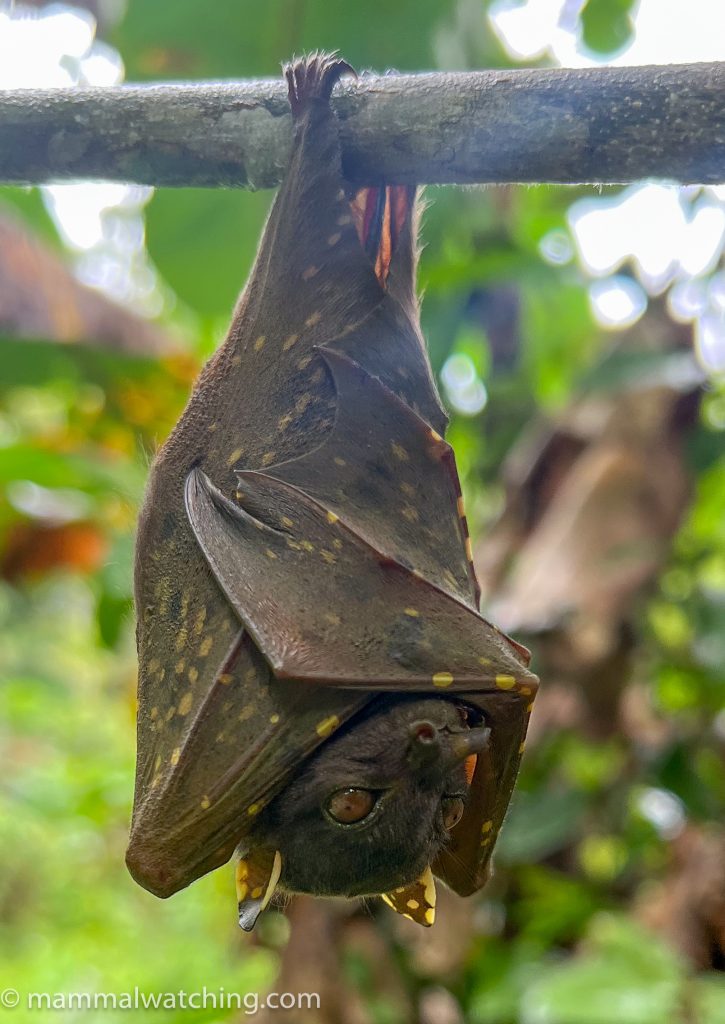
Unstriped Tube-nosed Bat (Paranyctimene raptor)
One close to Malagufuk village. Identified by its greenish wings.
Greater Tube-nosed Bat (Nyctimene aello)
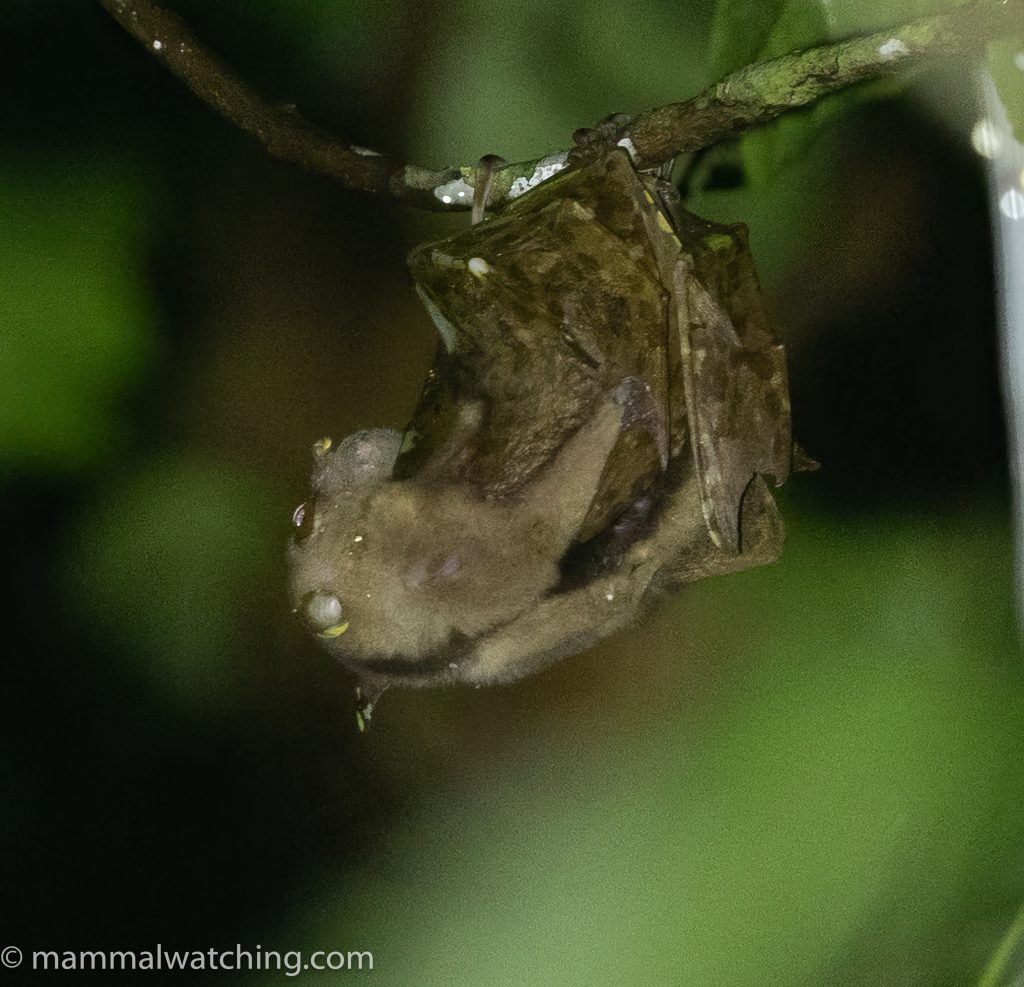
Greater Tube-nosed Bat (Nyctimene aello)
Two along the Malagufuk trails, identified by the prominent dorsal stripe.
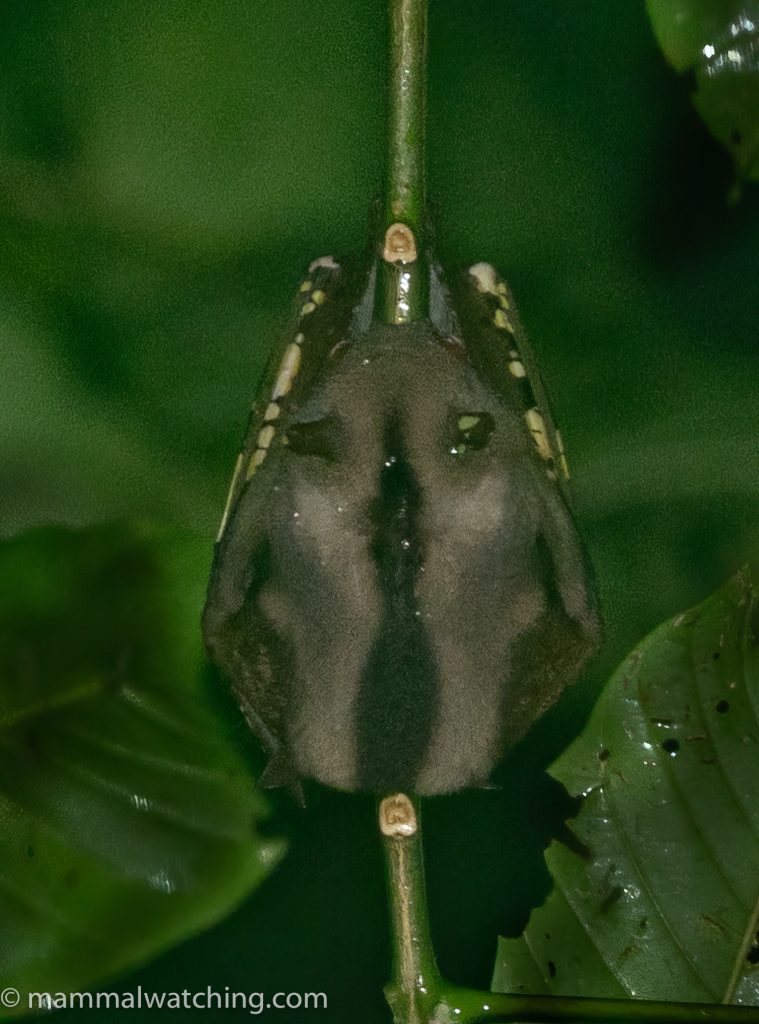
Greater Tube-nosed Bat (Nyctimene aello)
Common Tube-nosed Bat (Nyctimene albiventer)
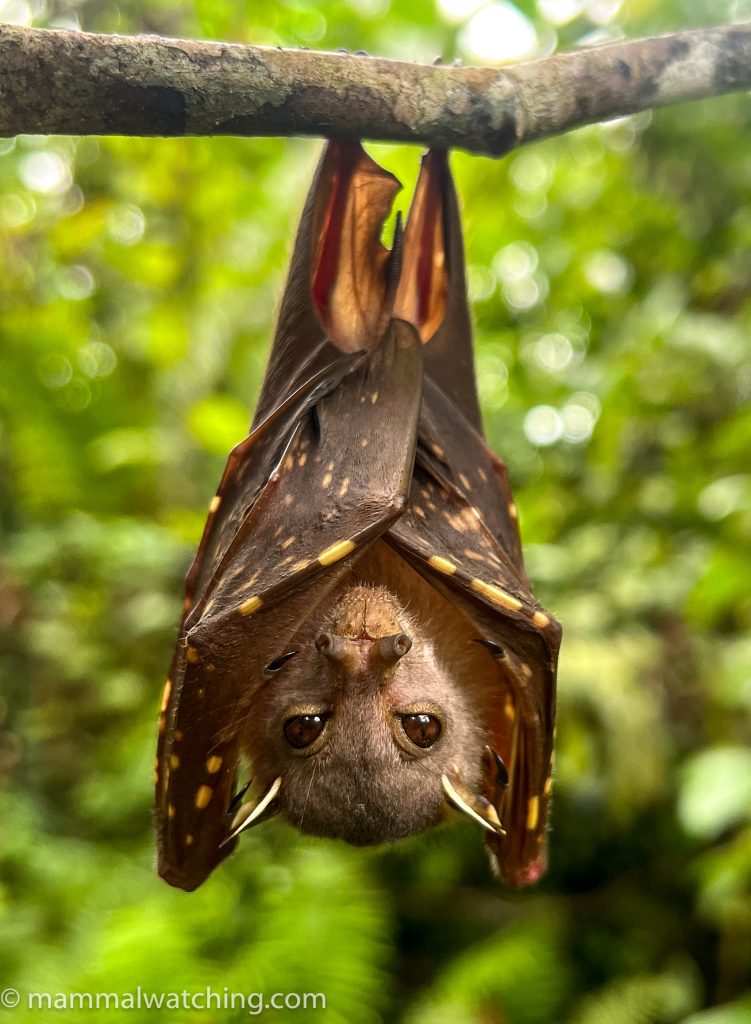
Common Tube-nosed Bat (Nyctimene albiventer)
Just one in Malagufuk close to the village.
Large-eared Flying Fox (Pteropus macrotis)
Some animals feeding in trees along one of the trails. This species was photographed properly in Waigeo.
Great Flying Fox (Pteropus neohibernicus)
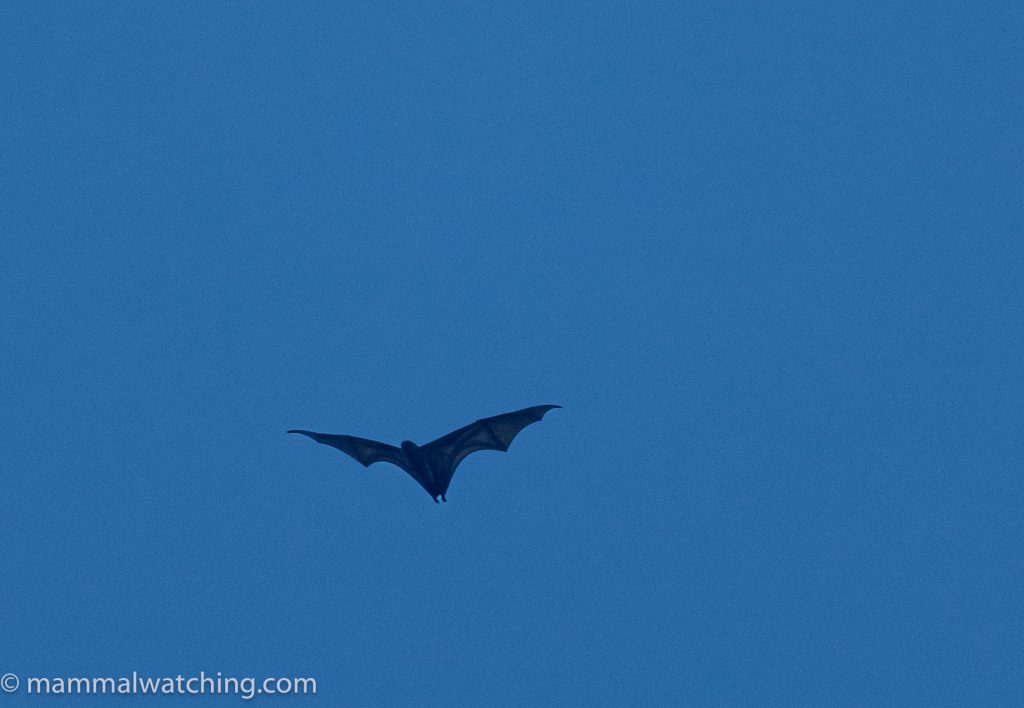
Great Flying Fox (Pteropus neohibernicus)
Dozens of these enormous flying foxes cruised over the village at dusk as they dispersed to search for food. We found several feeding in trees.
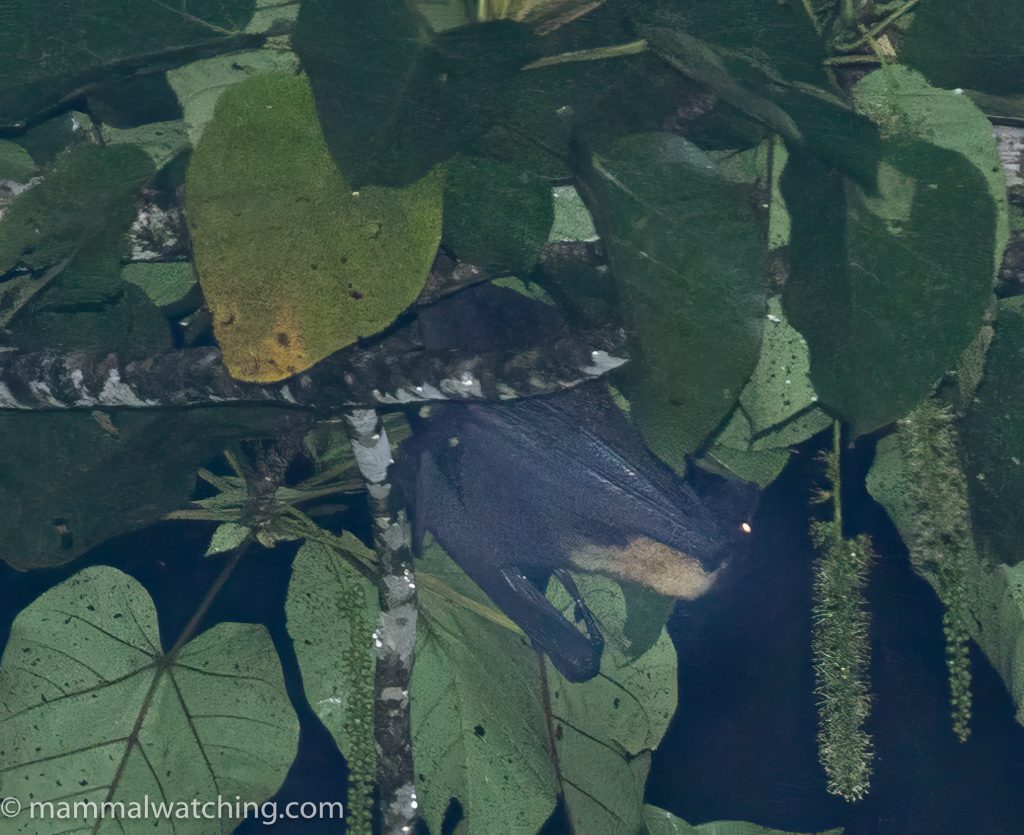
Great Flying Fox (Pteropus neohibernicus)
Diadem Leaf-nosed Bat (Hipposideros diadema)
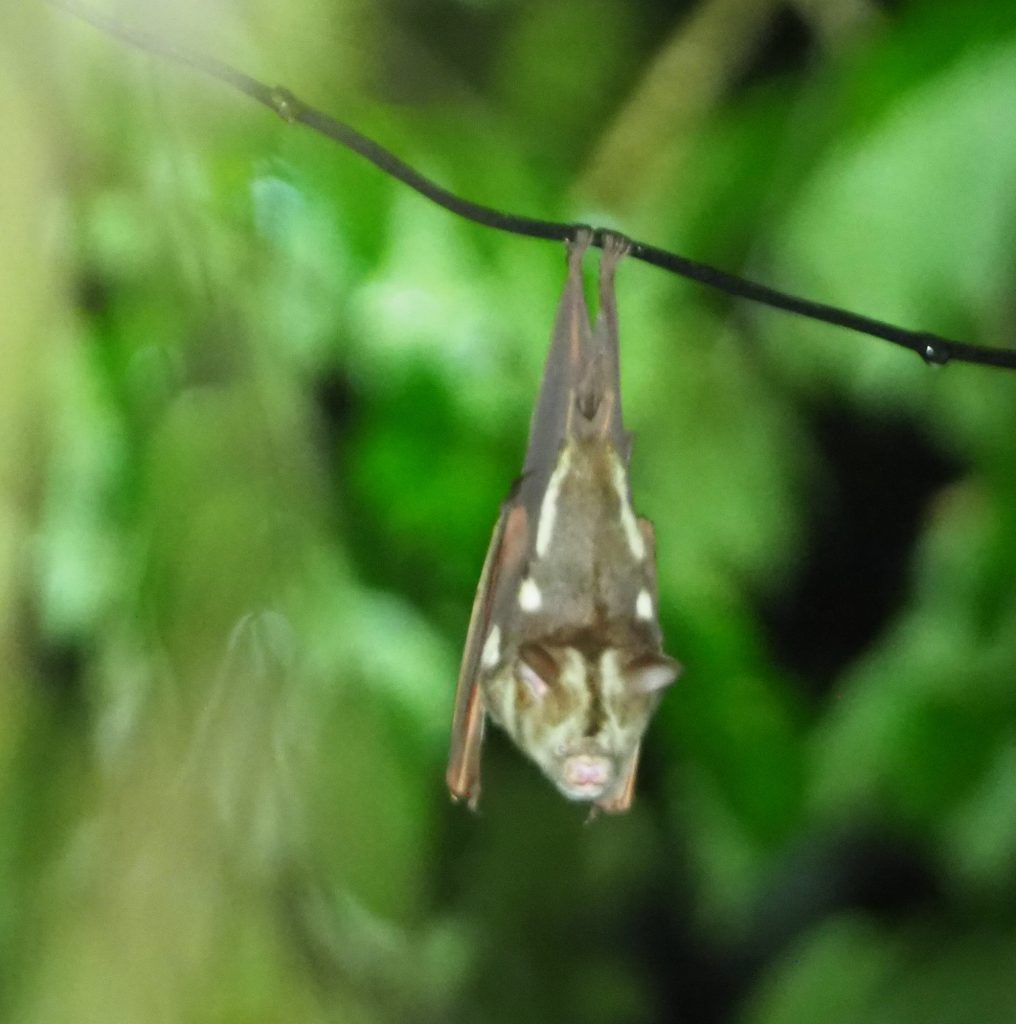
Diadem Leaf-nosed Bat (Hipposideros diadema). Photo by Venkat Sankar.
One seen well at the start of the ‘jungle trail’ though heavy rain made photography difficult.
Biak Leaf-nosed Bat (Hipposideros papua)
Several in a small and hard to access cave along the ‘jungle trail’. This species was easy to photograph in a cave on Waigeo.
Raffray’s Sheath-tailed Bat (Emballonura raffrayana)
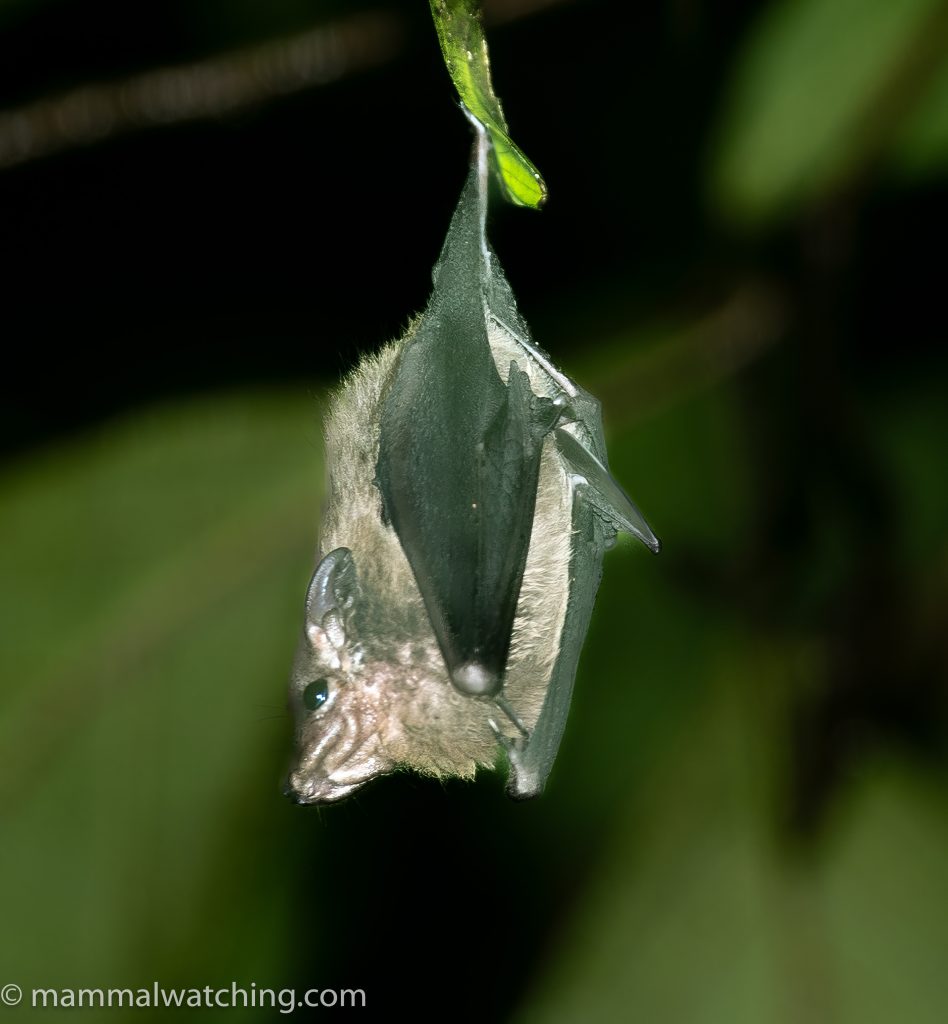
Raffray’s Sheath-tailed Bat (Emballonura raffrayana)
One hanging from the trail. We also saw plenty in the bat cave along the ‘jungle trail’.
Lesser Sheath-tailed Bat (Mosia nigrescens)
A few hanging from leaves along the trails.
Fly River Woolly Bat (Kerivoula muscina)
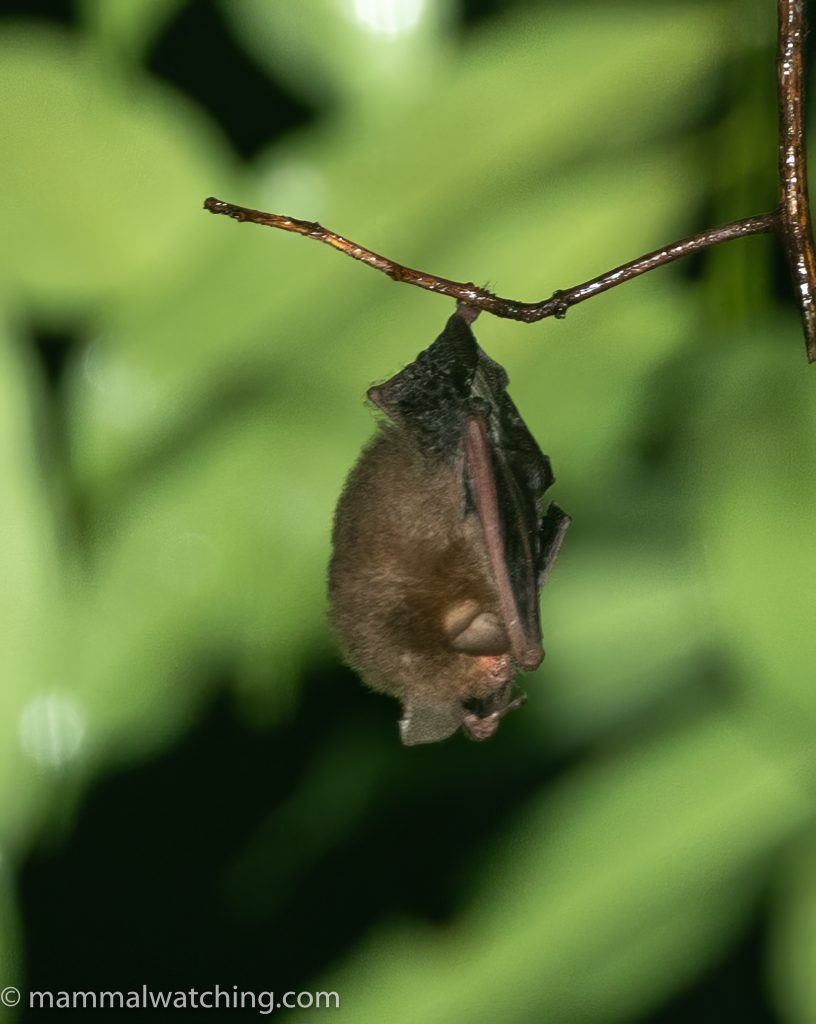
Fly River Woolly Bat (Kerivoula muscina)
An exciting find and a species that even Carlos had never seen. Found with a thermal scope at the top of the hill along the ‘concrete trail’.
Stuff We Missed
Not very much. Carlos has seen New Guinea Quoll several times here in the early morning while birding along the boardwalk. We may have had one in the thermal scope but the sighting was inconclusive. Common Spotted Cuscus ought to be around but we only saw one cuscus during our stay, a Northern Common. And Carlos had seen Long-tailed Pygmy Possum here, including in the accommodation: we were not lucky.
Waigeo Island
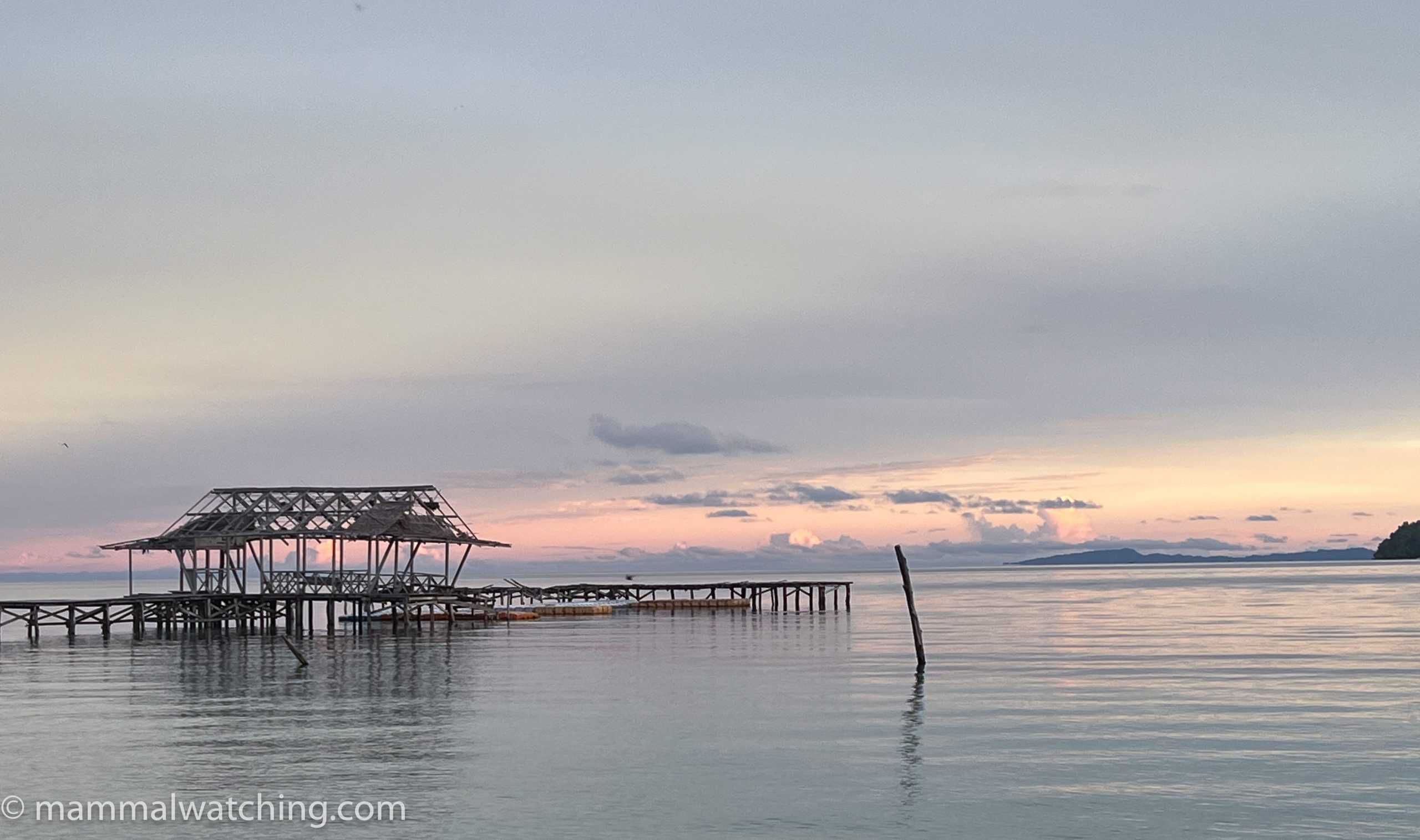
We finished the trip in style at the very comfortable Waiwo Dive Resort for two nights. Lovely rooms on the beach with good food. It was hard to motivate myself to do very much here that didn’t involve having a beer within arm’s reach. Thankfully the beautiful Waigeo Spotted Cuscuses cooperated with that plan.
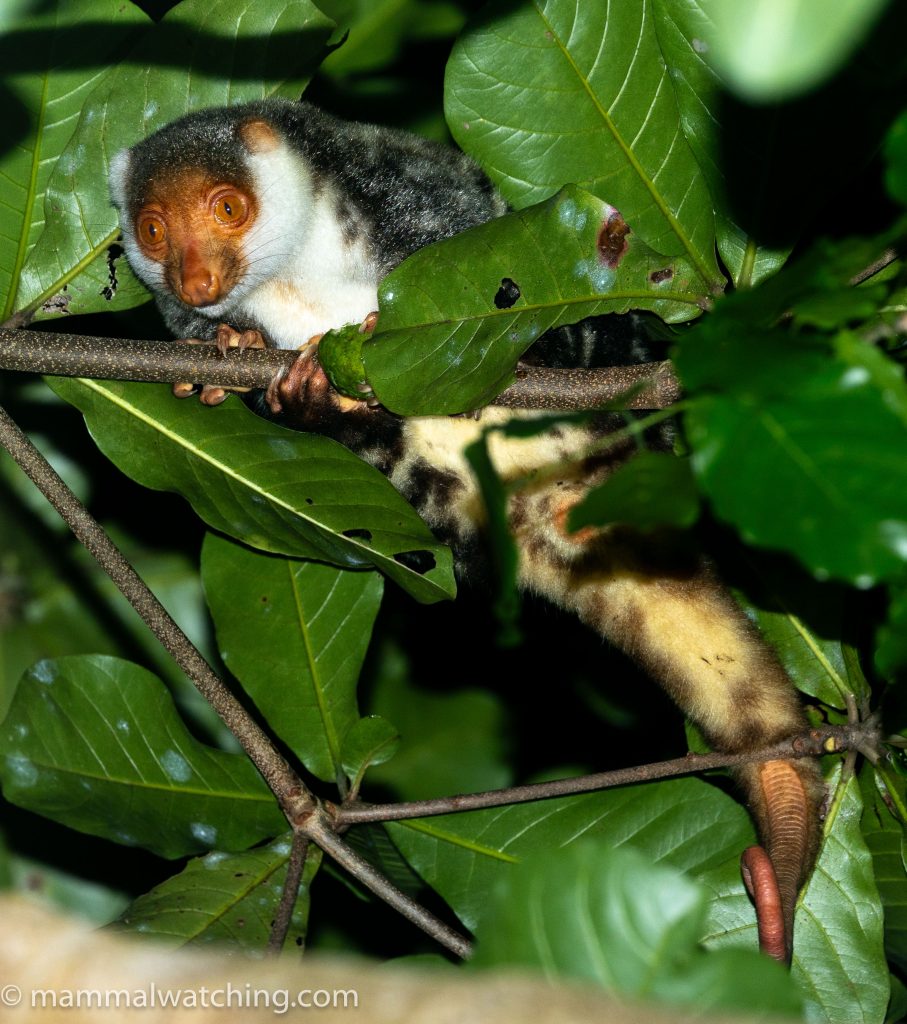
Waigeo Cuscus (Spilocuscus papuensis)
We poked around looking for bats in several caves during our full day on the island and found five species. We even took a trip to see Wilson’s Bird of Paradise on our last morning much to Carlos’s shock. Often called the best bird in the world it was a groovy bouncing blitz of colour as it hopped around its display site cleaning up the forest floor. That said if someone had spotted a rat I would have been out of the hide in seconds.
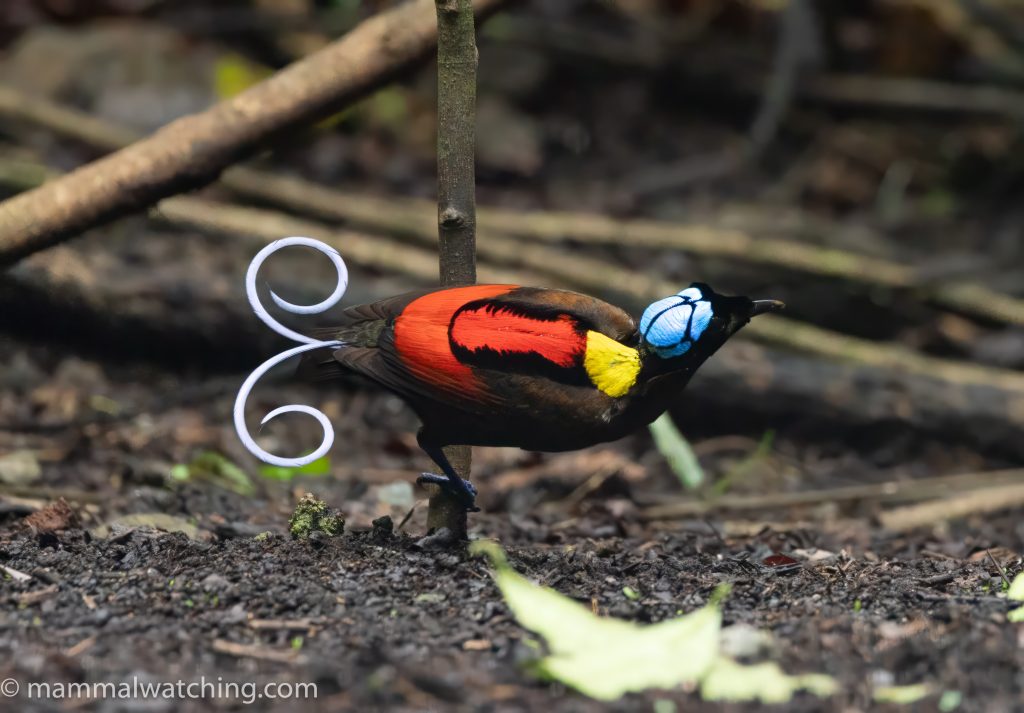
Wilson’s Bird of Paradise
Despite our laziness we saw all our target mammals other than Beaufort’s Naked-backed Fruit Bat. With a bit more effort we would have seen one I am sure: we saw one smaller fruit bat fly out of a tree during our one brief night hike that Carlos was pretty sure was this species. But by this point we were only willing to accept quality sightings.And we were not willing to go more than twenty minutes from the bar.
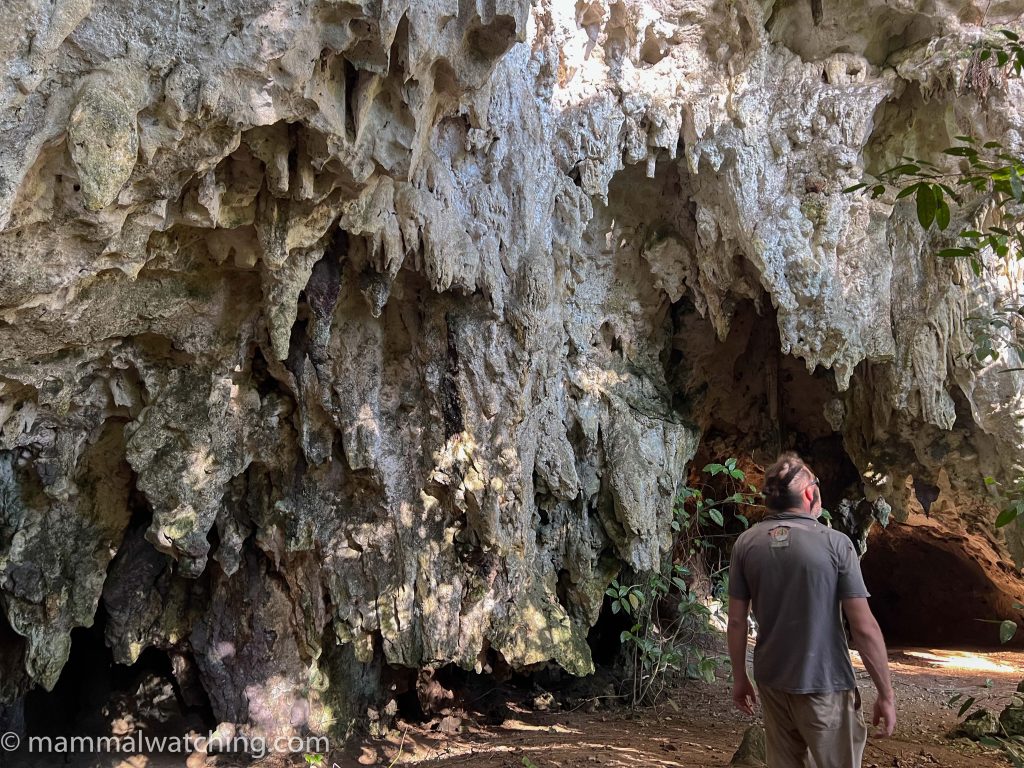
Carlos takes us into another bat cave
Ending at Waigeo was a final piece of inspired planning from Carlos. If you contemplate a similar itinerary that has Waigeo in the beginning or middle then think again. It’s the perfect place to finish a West Papua expedition but to have to leave the island and return to the sweaty jungle would require will power that I don’t have.
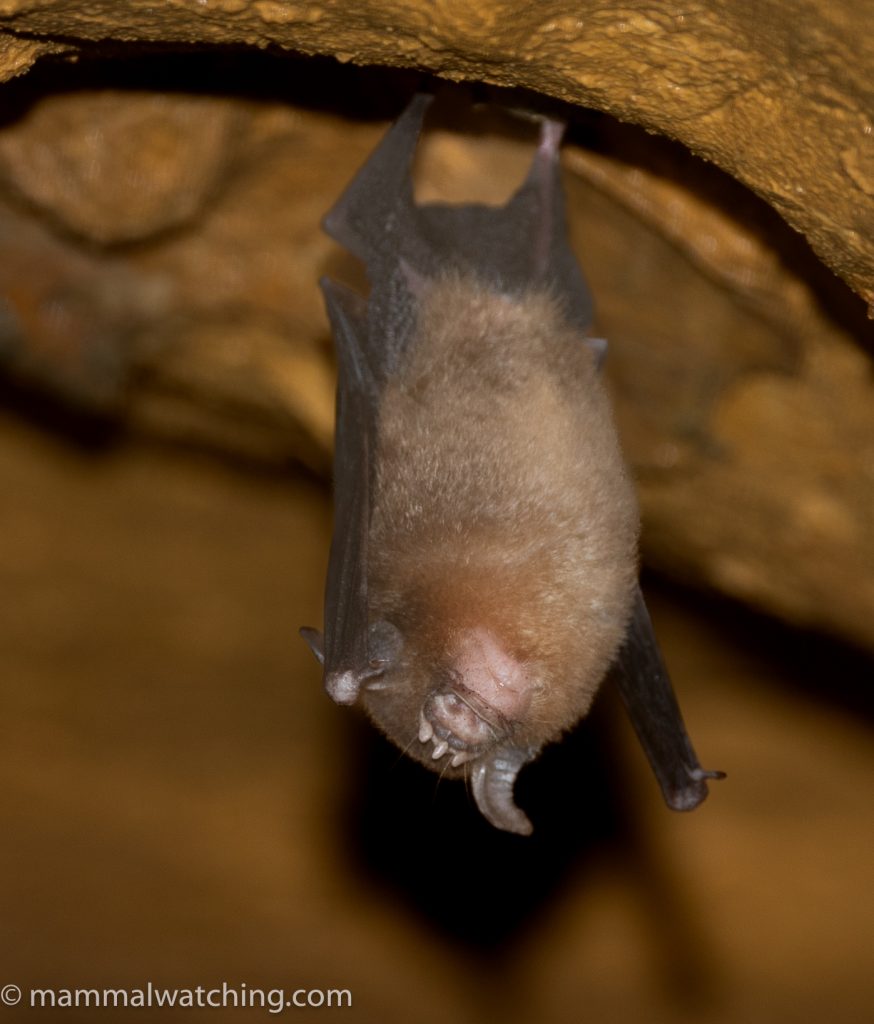
Trident Leaf-nosed Bat (Aselliscus tricuspidatus)
A three hour ferry ride – twice a day – connects Sorong with the island. Calm seas on the way out meant we could look for cetaceans and we had brief and distant views of pods of Bottlenose and Spinner dolphins and Melon-headed Whales on the way out. It was rougher on the return and we didn’t see anything. Australian Humpbacked Dolphins are quite often seen close to shore.
The Mammals
Waigeo Cuscus (Spilocuscus papuensis)
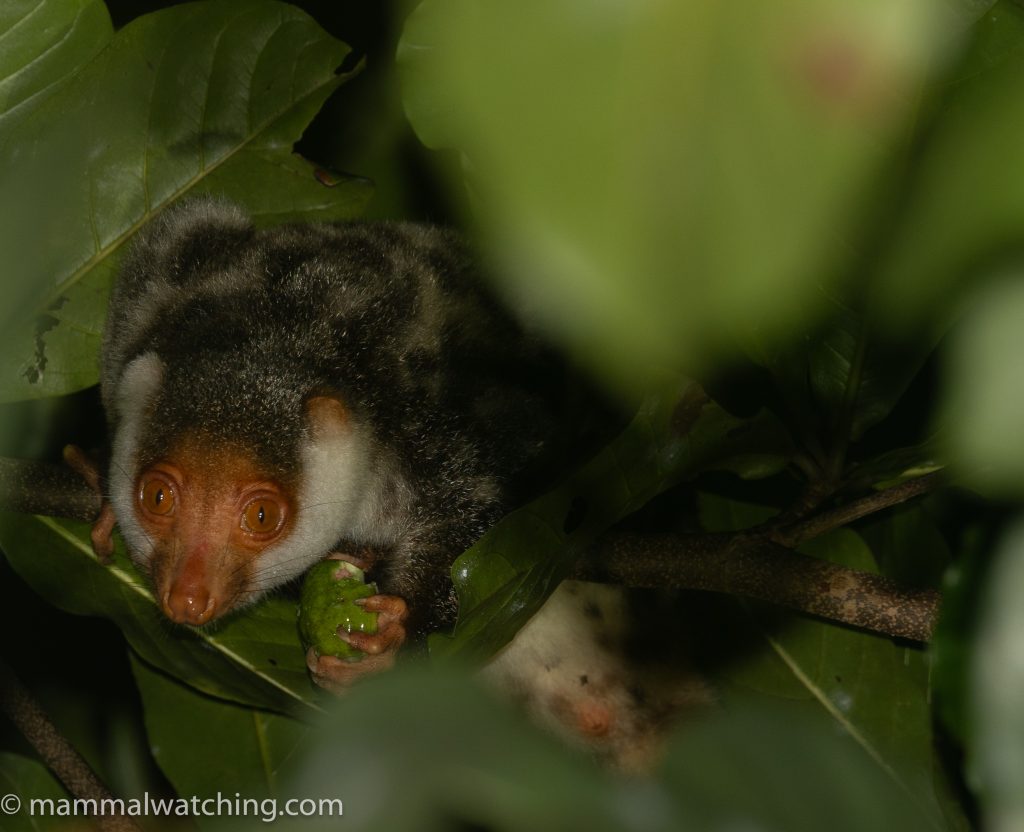
Waigeo Cuscus (Spilocuscus papuensis)
Waigeo Cuscuses appear to have one critical habitat requirement: they are best seen within 10 metres of somewhere you can buy beer. They were easy to find around the Waiwo Dive Resort and along the coastal road that ran past the resort. Carlos said they are much harder to find in the forest itself.
Striped Possum (Dactylopsila trivirgata)
One seen briefly during a short spotlighting session along the road behind the Waiwo Dive Resort.
White-tailed Giant Rat (Uromys caudimaculatus)
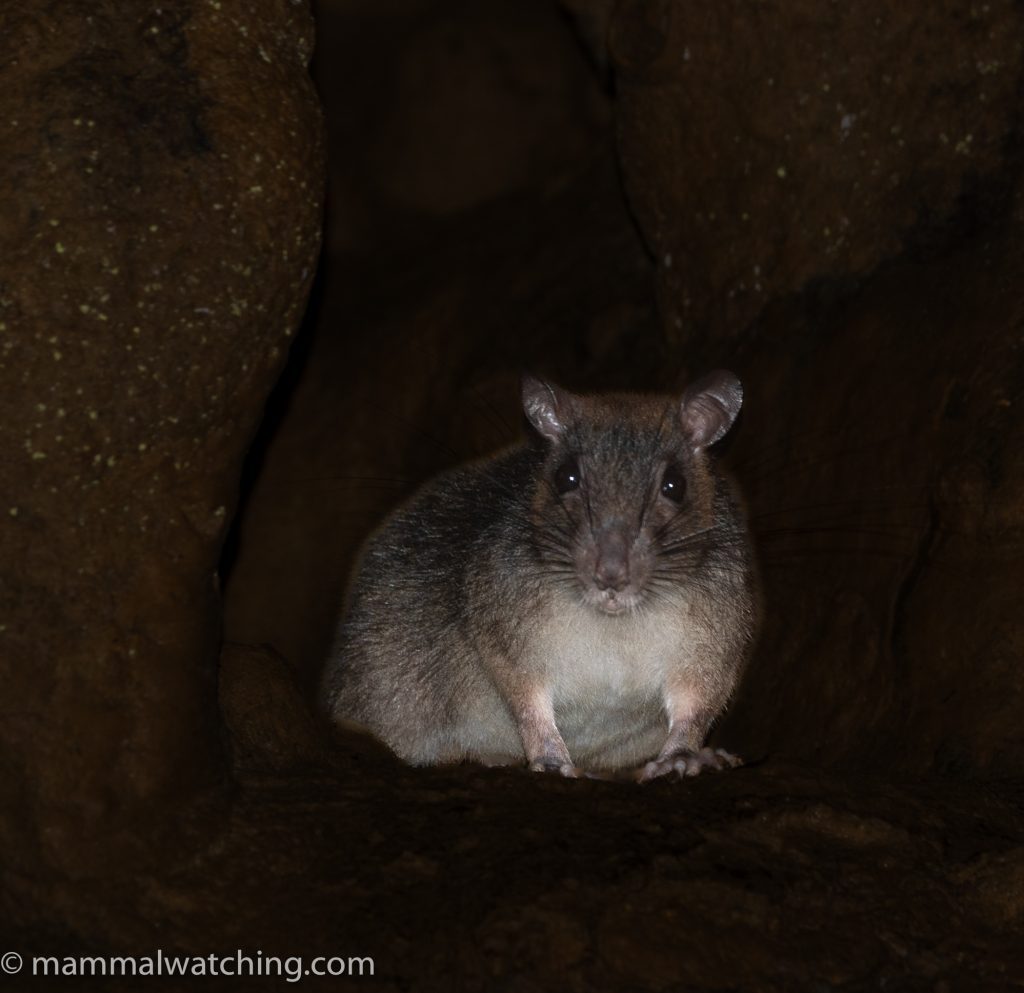
White-tailed Giant Rat (Uromys caudimaculatus)
We were surprised to see a very large rat inside a bat cave just behind the kitchens at the Raja Ampat Dive Resort. When we eventually got a look at the tail it appeared to be faintly mottled, rather than having any significant white colouration. But after some discussion we figured that was because the white on the tail was likely covered in bat cave dirt, and so we recorded this as a White-tailed Giant Rat.
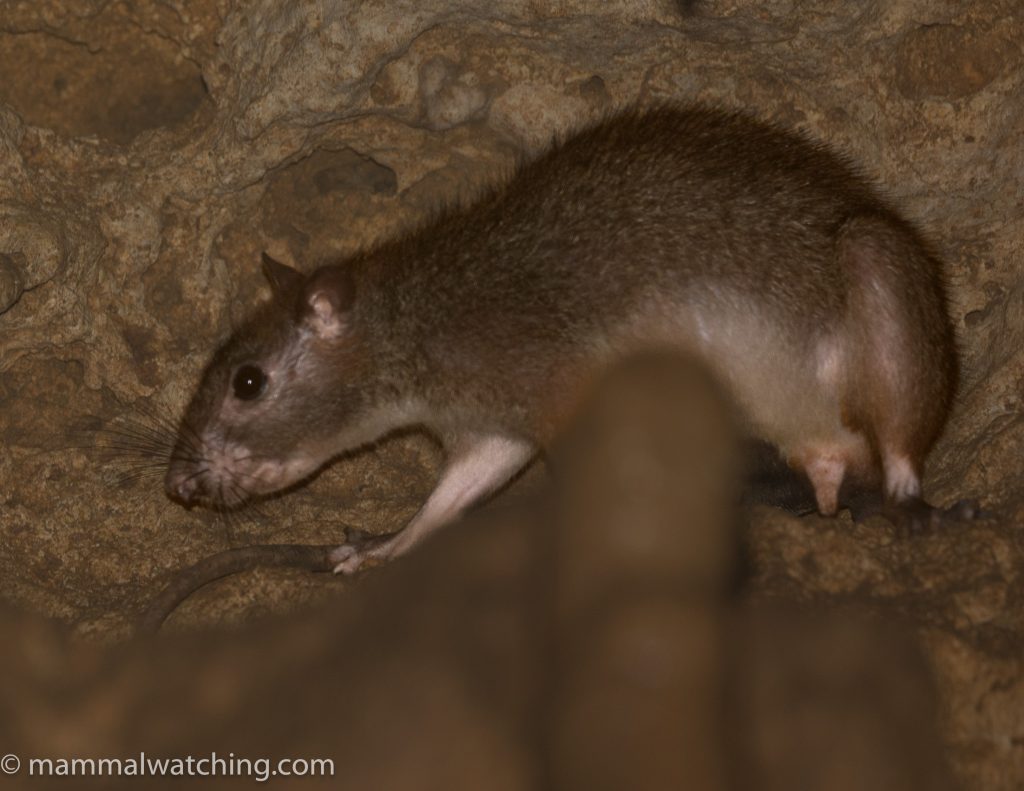
White-tailed Giant Rat (Uromys caudimaculatus)
If anyone has any other ideas on the identification I would love, as always, to hear them.
Large-eared Flying Fox (Pteropus macrotis)
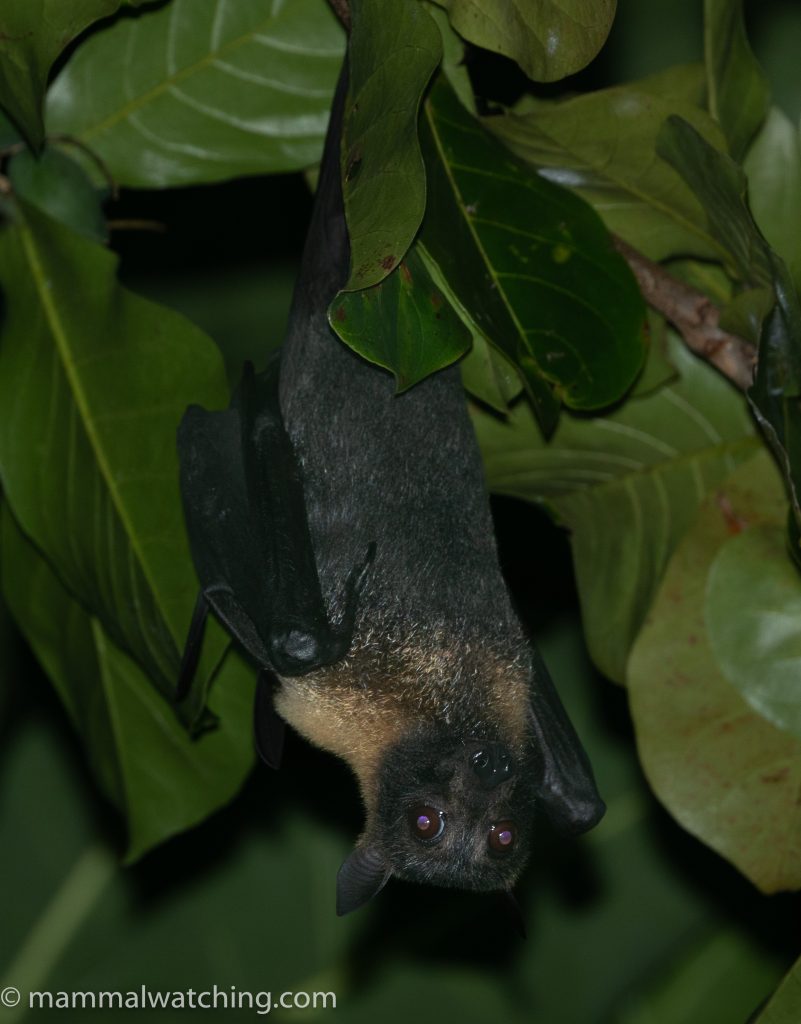
Large-eared Flying Fox (Pteropus macrotis)
One or two feeding in trees along the road behind the Waiwo Dive Resort during a brief spotlighting session.
Trident Leaf-nosed Bat (Aselliscus tricuspidatus)
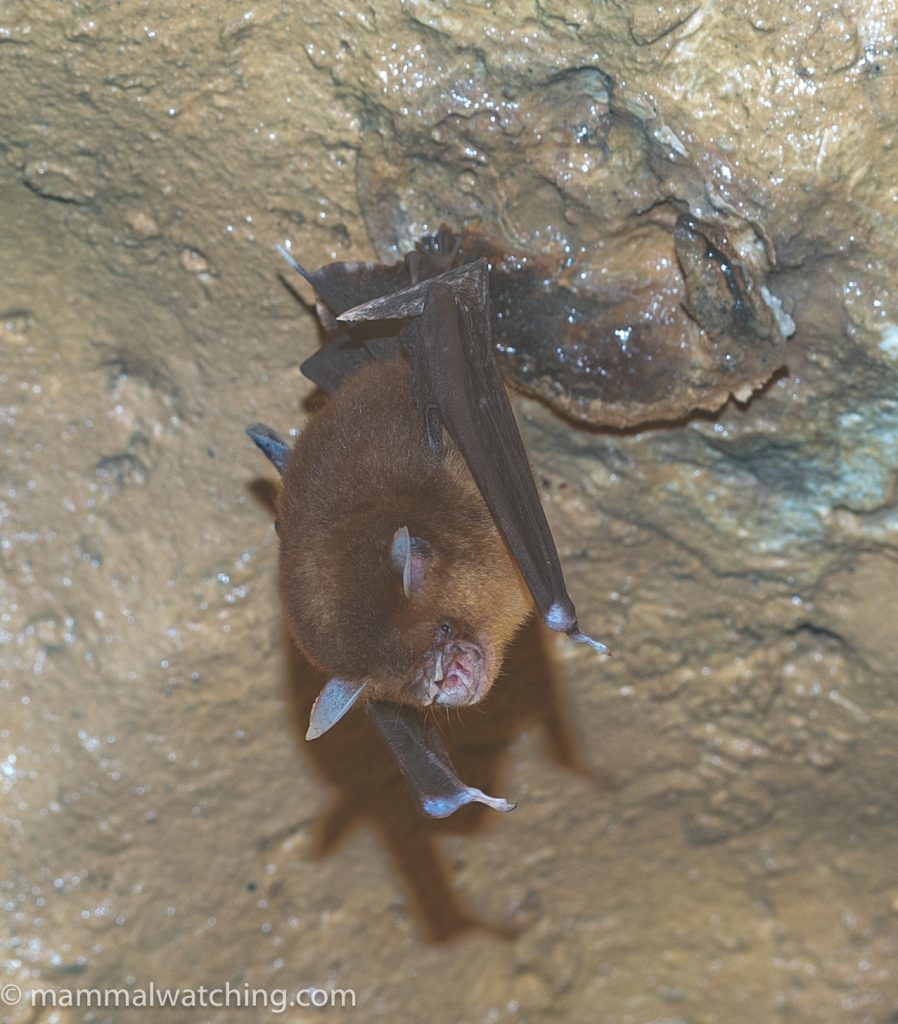
Trident Leaf-nosed Bat (Aselliscus tricuspidatus)
Several of these great bats roosting in a bat cave just behind the kitchens at the Raja Ampat Dive Resort.
Fawn-colored Leaf-nosed Bat (Hipposideros cervinus)
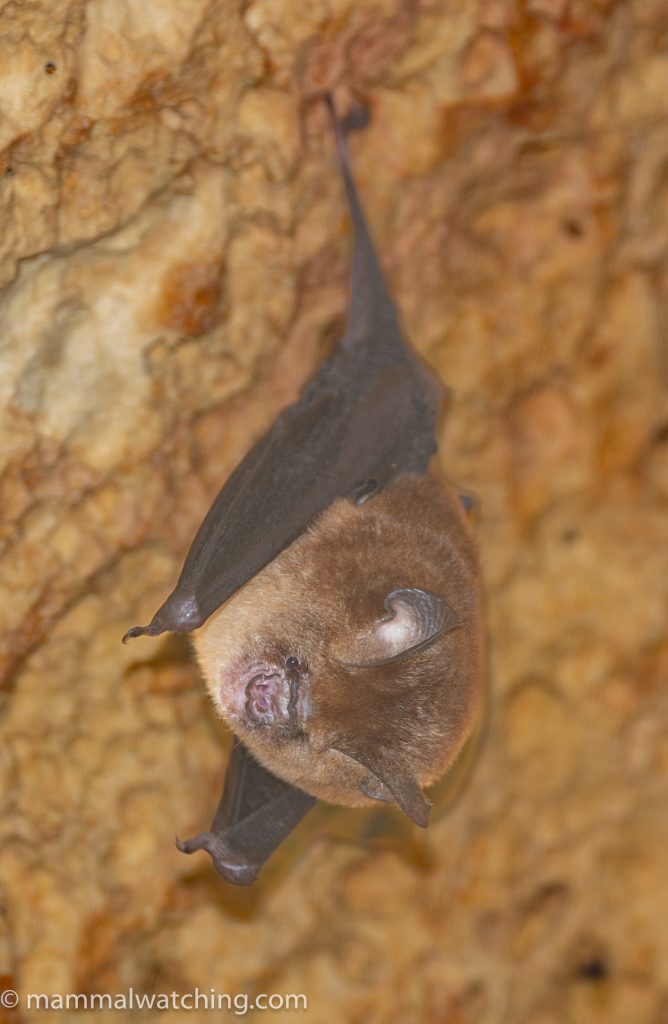
Fawn-colored Leaf-nosed Bat (Hipposideros cervinus)
We visited a cave very close to the Waiwo Dive Resort. Just before the COVID19 pandemic the local government wanted to promote the cave as a tourist attraction, and they had constructed an impressive boardwalk from the edge of the road to the cave. Less than four years later the boardwalk was rotten, and it took us 10 minutes even to find the start of the trail through the newly sprouted jungle. But once we found it, the cave was easy to access and contained many Fawn Leaf-nosed Bats plus, after some searching, a lone Maggie Taylor’s Leaf-nosed Bat, our target for this cave.
Maggie Taylor’s Leaf-nosed Bat (Hipposideros maggietaylorae)
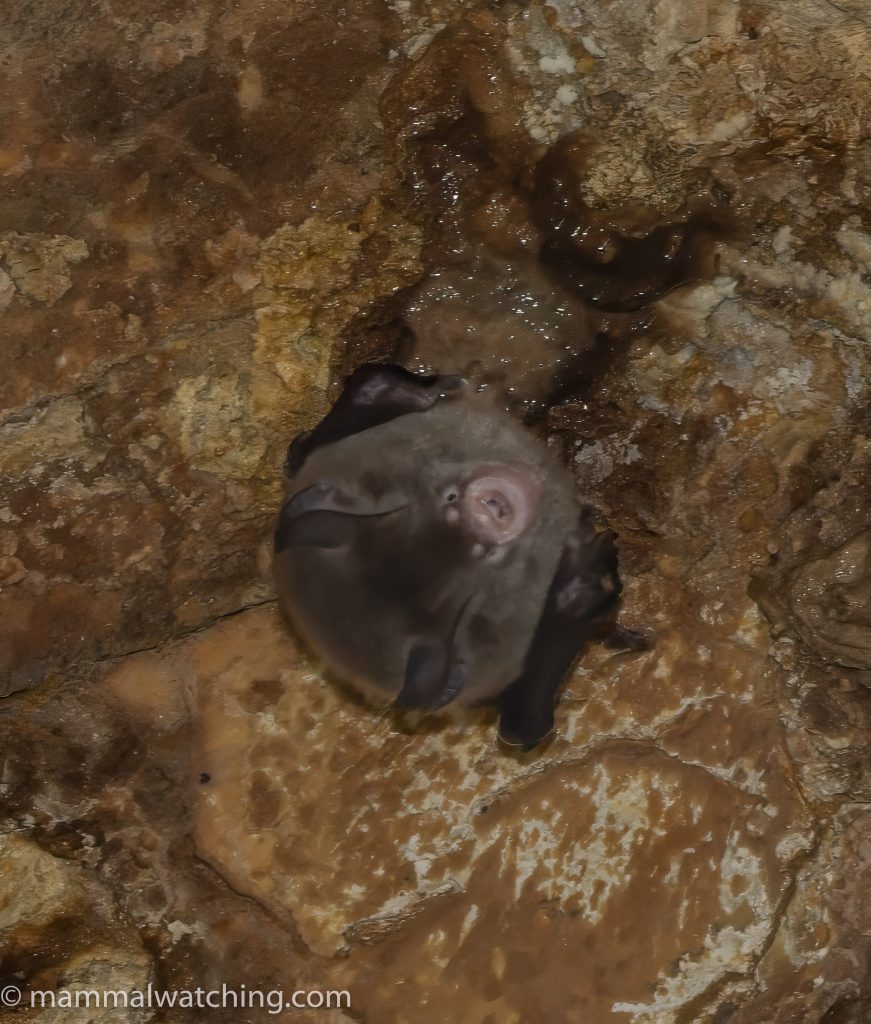
Maggie Taylor’s Leaf-nosed Bat (Hipposideros maggietaylorae)
After some searching in the cave described above (Fawn Leaf-nosed Bats) we found a single Maggie Taylor’s Leaf-nosed Bat in a weep hole. Identified by its larger size and pale eye rings.
Biak Leaf-nosed Bat (Hipposideros papua)
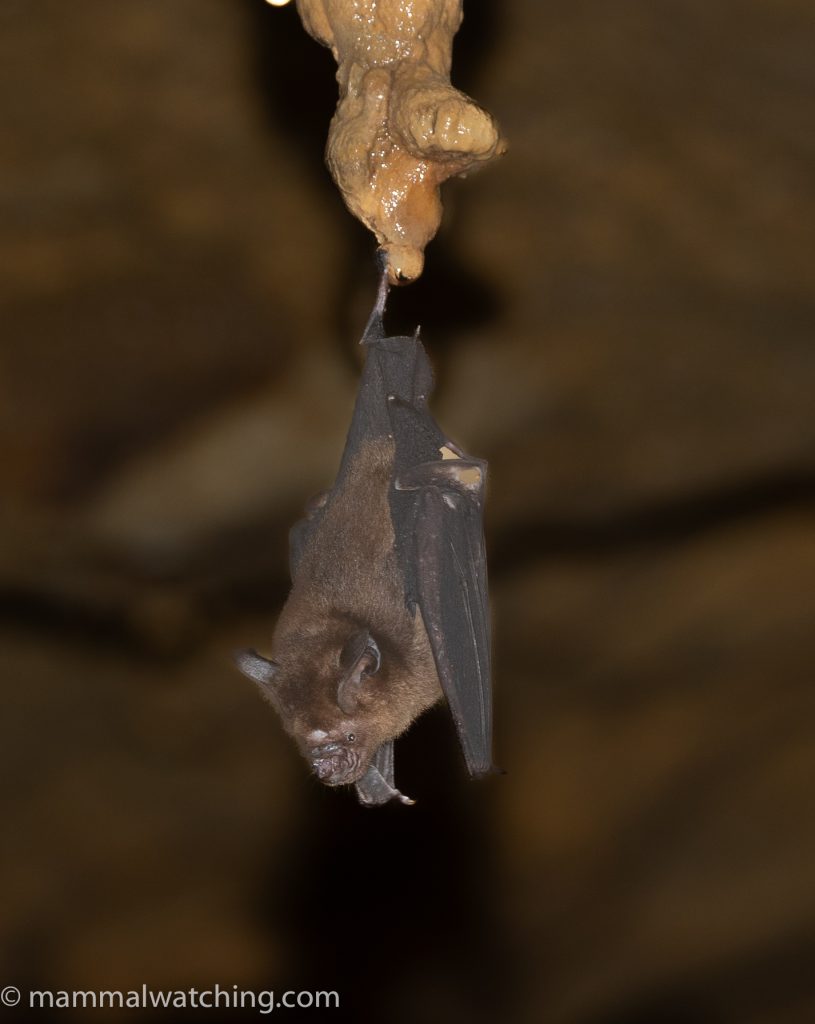
Biak Leaf-nosed Bat (Hipposideros papua)
A few in a bat cave just behind the kitchens at the Raja Ampat Dive Resort.
New Guinea Horseshoe Bat (Rhinolophus euryotis)
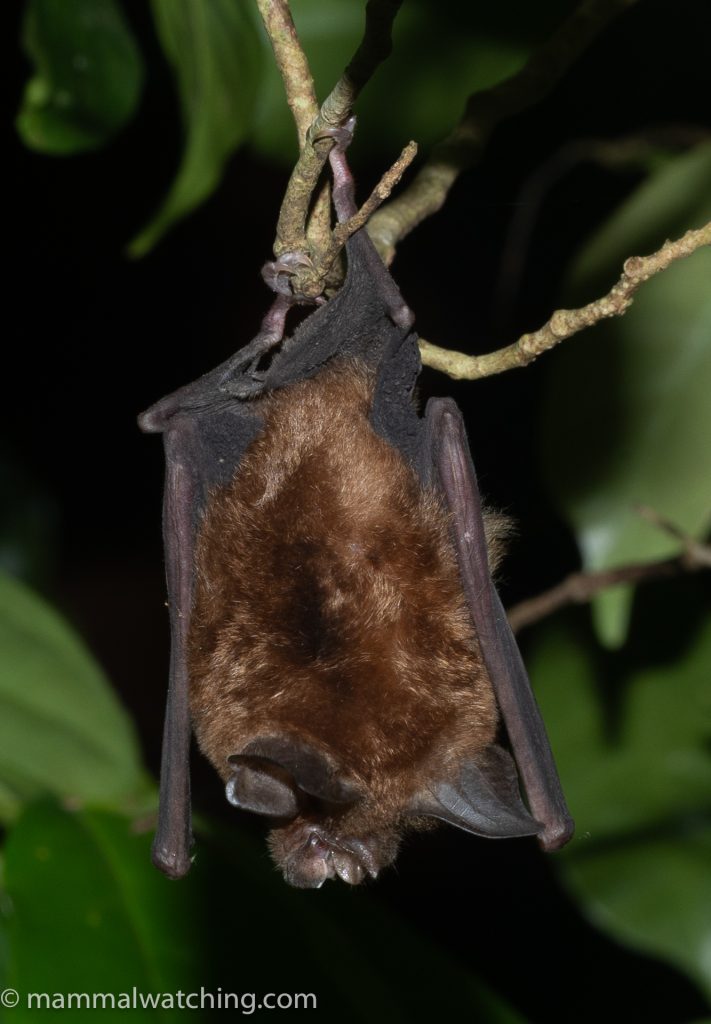
New Guinea Horseshoe Bat (Rhinolophus euryotis)
A few flying around the Waiwo Dive Resort.
Little Long-fingered Bat (Miniopterus australis)
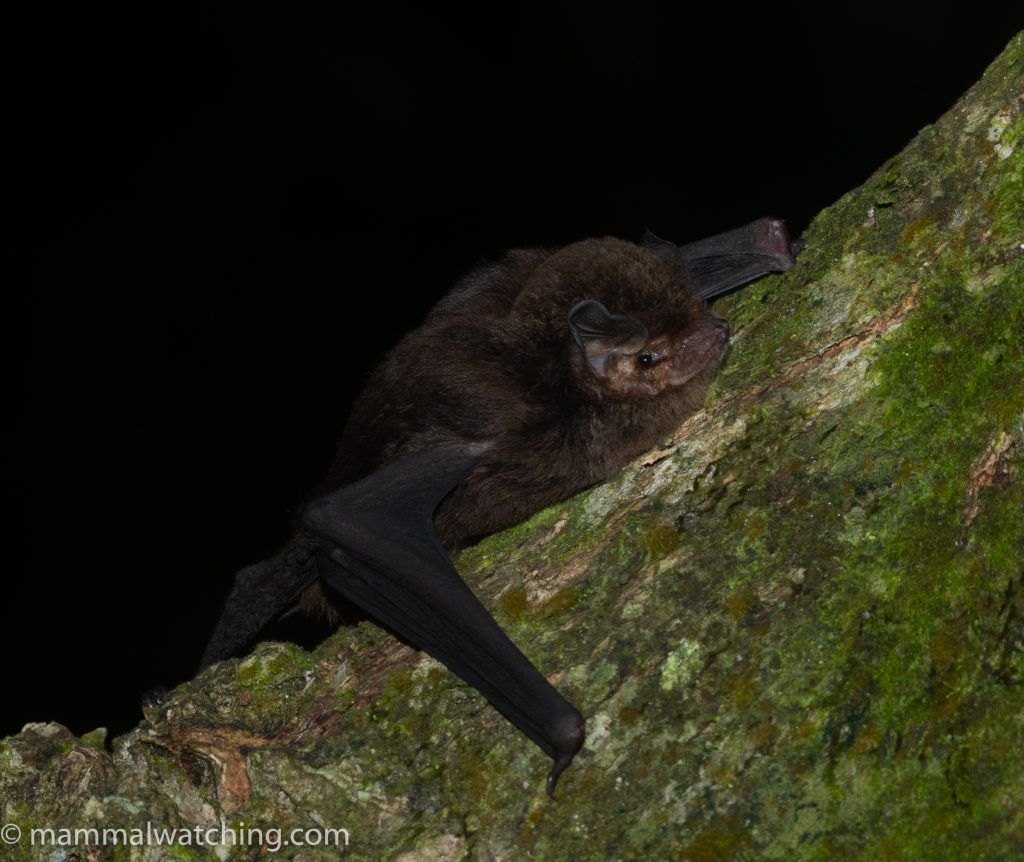
Little Long-fingered Bat (Miniopterus australis)
A few flying around the Waiwo Dive Resort.
Spinner Dolphin (Stenella longirostris)
A distant pod leaping and spinning, spotted from the ferry as we were coming into Waigeo Island.
Indo-pacific Bottlenose Dolphin (Tursiops aduncus)
One pod briefly seen close to Sorong as we set out on the ferry. Ian saw another pod from the beach at the Waiwo Dive Resort.
Melon-headed Whale (Peponocephala electra)
We saw a pod of blackfish distantly and briefly from the ferry about 30 minutes out of Sorong. Tentatively identified as Melon-heads by their overall pilot whale appearance but with more prominent and triangular dorsal fins. They might have been Pygmy Killer Whales, but this seems unlikely as that is a rare species seldom seen so close to shore.
Stuff We Missed
We were lazy on Waigeo. With a bit more effort put into a night walk I am fairly confident we would have seen Beaufort’s Naked-backed Fruit Bat. Indeed we saw one fruit bat flying behind our hotel that looked too small for Pteropus macrotis that Carlos thought was a Beaufort’s. Australian Humpbacked Dolphins are frequently seen close to the Waigeo shore. We made no effort to look for them other than from the ferry. Carlos has seen Large-eared Horseshoe Bats (Rhinolophus philppinensis) in the cave at Raja Ampat Dive Resort: we weren’t lucky.
Final Thoughts
What a trip! West Papua is as good as it gets for mammalwatching. But also as tough as it gets. And this trip would have been far tougher – and far far less successful – without Carlos’s help. So a huge thank you to him and to the wonderful team of Papuans he assembled to help us. A big thanks also to my travel companions for their humour, good nature and mammalwatching skills.
We ended up with around 60 mammals, nearly 50 of them new for me. So far as I know my most successful trip (in terms of lifers) ever. Remarkable!
I received several messages while we were there along the lines of “I hope you are looking at the birds of paradise too!”. So to answer those skeptics here is proof we did look at some of them and even stopped to photograph one or two. Admittedly we were also disappointed that the thermal signature of this King Bird of Paradise was not something mammalian. But when life gives you lemons…
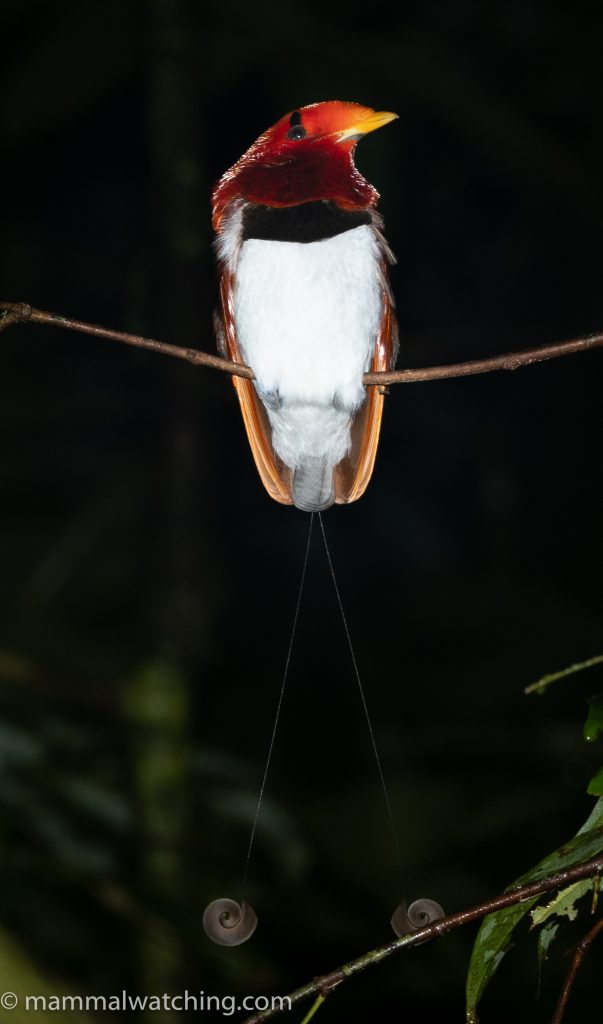
King Bird of Paradise, Malagufuk
Mammalwatching in West Papua has enormous potential to help conservation so please don’t wait to travel because things can change quickly in the wrong direction. But do travel carefully and with lots of help from the right people.
Trip List
All but two of the non-cetacean species were photographed and observed well at least once during the trip. As always, any mistakes in this report are mine and I would love to receive corrections and comments, especially on some of the species that have been only tentatively ID’d. I hope to get more information on some of these soon – there are at least two mammal surveys planned for the area over the next few months.
Western Long-beaked Echidna (Zaglossus bruijnii)
Müller’s Three-striped Dasyure (Myoictis melas)
Black-tailed Dasyure (Murexia melanurus)
Raffray’s Bandicoot (Peroryctes raffrayana) (not photographed)
Common Echymipera (Echymipera kalubu)
Long-nosed Echymipera (E.rufescens)
Ground Cuscus (Phalanger gymnotis)
Northern Common Cuscus (P.orientalis)
Waigeo Cuscus (Spilocuscus papuensis)
Lowland Ringtail (Pseudochirulus canescens)
Arfak Ringtail (P.schlegelii) – endemic
D’Albertis’s Ringtail (Pseudochirops albertisii)
Reclusive Ringtail (P.coronatus)
Long-fingered Triok (Dactylopsila palpator)
Striped Possum (D.trivirgata)
Papuan Glider (Petaurus papuanus)
Feather-tailed Possum (Distoechurus pennatus)
Brown Dorcopsis (Dorcopsis muelleri)
Grizzled Tree Kangaroo (Dendrolagus inustus)
Vogelkop Tree Kangaroo (D.ursinus) – endemic
Broad-headed Tree Mouse (Chiruromys lamia) – possible
Common Water Rat (Hydromys chrysogaster) (not photographed)
Long-footed Tree Mouse (Lorentzimys nouhuysii)
Black-tailed Melomys (Melomys rufescens)
Common Lowland Paramelomys (Paramelomys platyops)
Bruijn’s Pogonomelomys (Pogonomelomys bruijnii)
Loria’s Pogonomys (Pogonomys loriae)
Chestnut Tree Mouse (P.macrourus)
Gray-bellied Tree Mouse (P.sylvestris)
White-tailed Giant Rat (Uromys caudimaculatus)
Polynesian Rat (Rattus exulans)
Large Spiny Rat (R.praetor)
Geoffroy’s Rousette (Rousettus amplexicaudatus)
Dagger-toothed Long-nosed Fruit Bat (Macroglossus minimus)
Common Blossom Bat (Syconycteris australis)
Lesser Bare-backed Fruit Bat (Dobsonia minor)
Moluccan Naked-backed Fruit Bat (D.moluccensis)
Unstriped Tube-nosed Bat (Paranyctimene raptor)
Greater Tube-nosed Bat (Nyctimene aello)
Common Tube-nosed Bat (N.albiventer)
Round-eared Tube-nosed Bat (N.cyclotis)
Large-eared Flying Fox (Pteropus macrotis)
Great Flying Fox (P.neohibernicus)
Trident Leaf-nosed Bat (Aselliscus tricuspidatus)
Fawn-colored Leaf-nosed Bat (Hipposideros cervinus)
Diadem Leaf-nosed Bat (H.diadema)
Maggie Taylor’s Leaf-nosed Bat (H.maggietaylorae)
Biak Leaf-nosed Bat (H.papua)
New Guinea Horseshoe Bat (Rhinolophus euryotis)
Raffray’s Sheath-tailed Bat (Emballonura raffrayana)
Lesser Sheath-tailed Bat (Mosia nigrescens)
Little Long-fingered Bat (Miniopterus australis)
Small Melanesian Bent-winged Bat (M.macrocneme)
Fly River Woolly Bat (Kerivoula muscina)
Maluku Myotis (Myotis moluccarum cf. adversus)
Spinner Dolphin (Stenella longirostris) (not photographed)
Indo-pacific Bottlenose Dolphin (Tursiops aduncus) (not photographed)
Melon-headed Whale (Peponocephala electra) (not photographed)
59 species, 48 of them lifers (in bold).
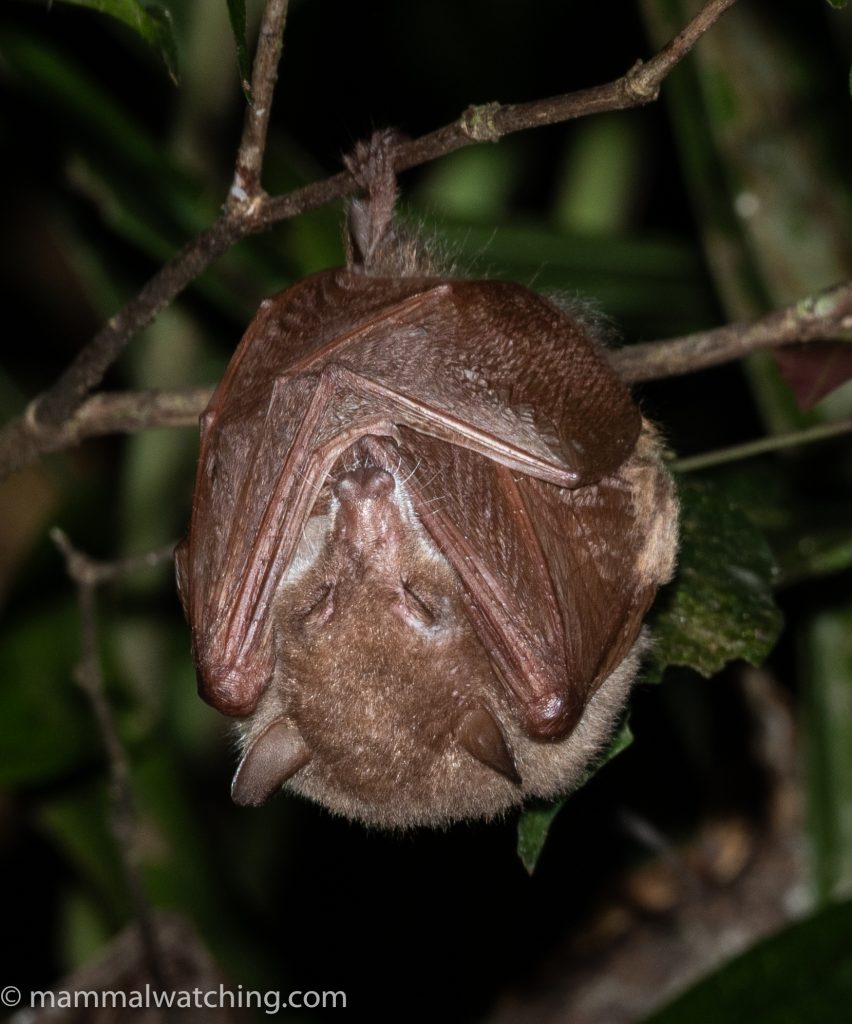
Common Blossom Bat (Syconycteris australis), Gunung Mupi.


Leave a Reply
You must be logged in to post a comment.